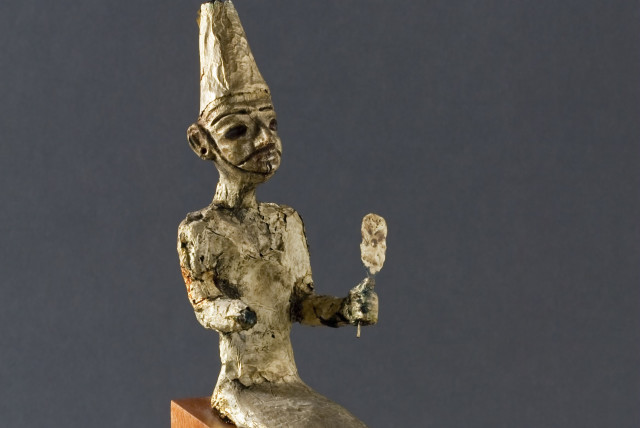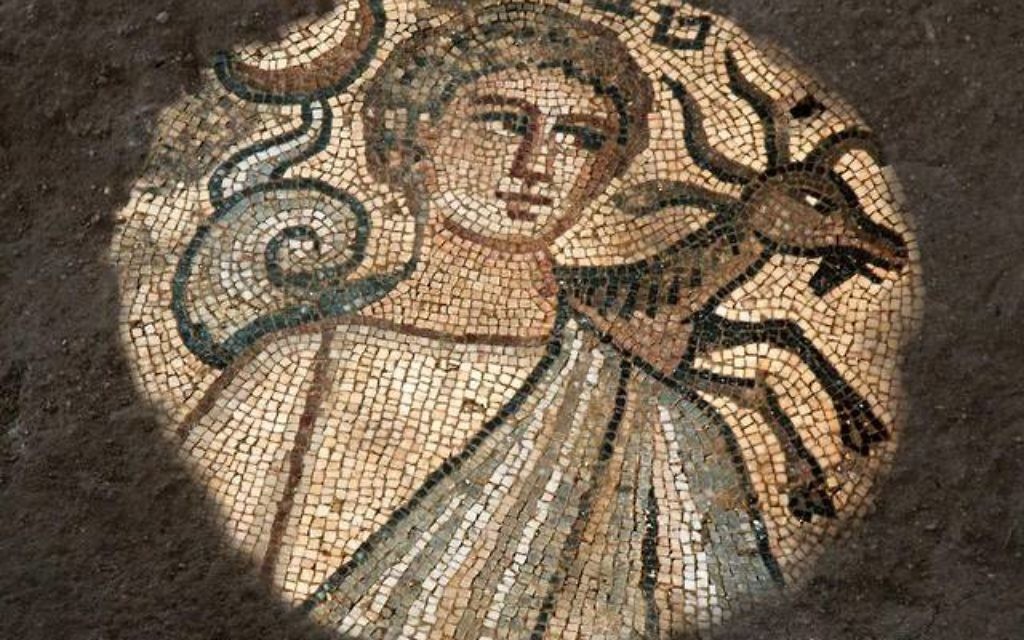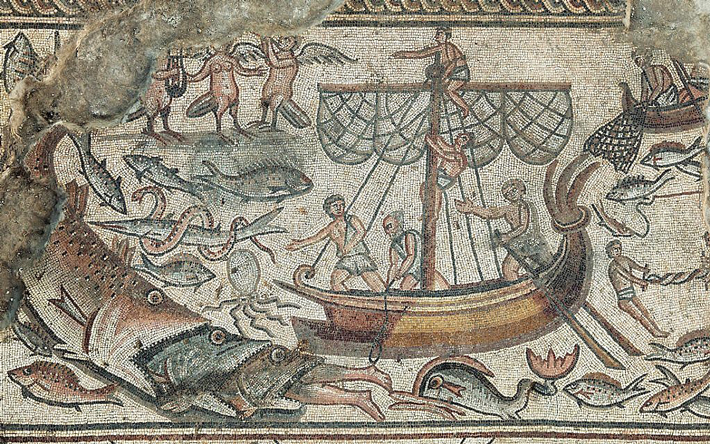Originally posted by Tukuler:
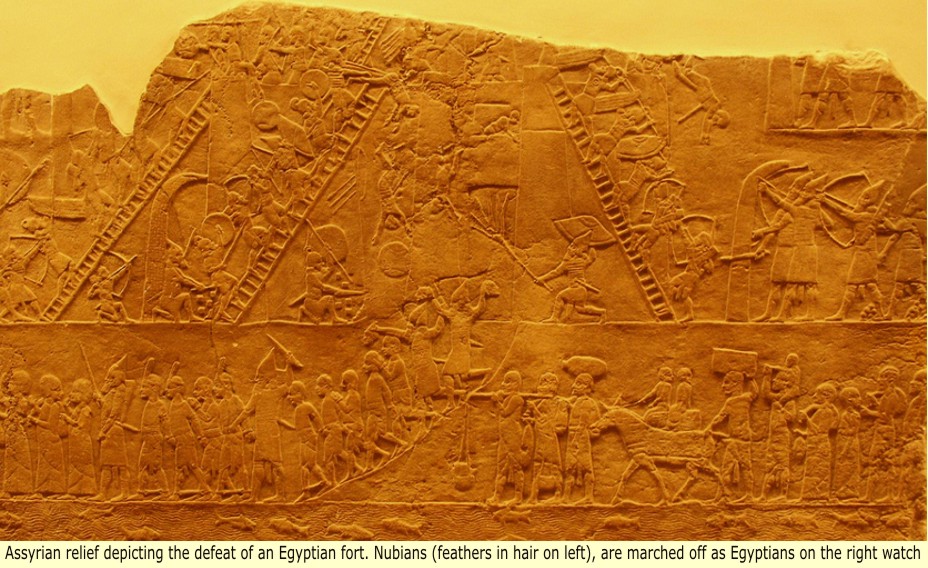
courtesy of Mike111


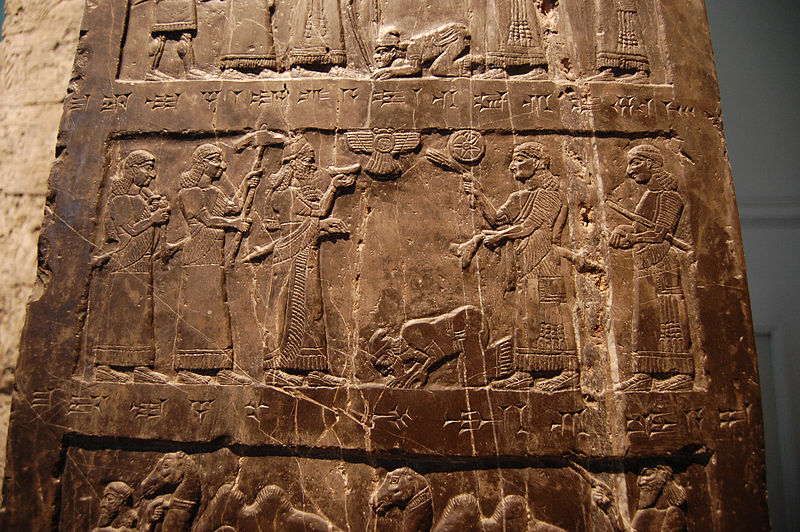



quote:.
Originally posted by the lioness,:
Please let's not talk about Caucasians and Negroids. I'm tired of them both
Caucasians and Negroids are banned from this thread
thanks, lioness
quote:I notice the headwear, ...
Originally posted by the lioness,:
Each panel runs around all four sides of the obelisk and is described by the cuneiform inscription above it.


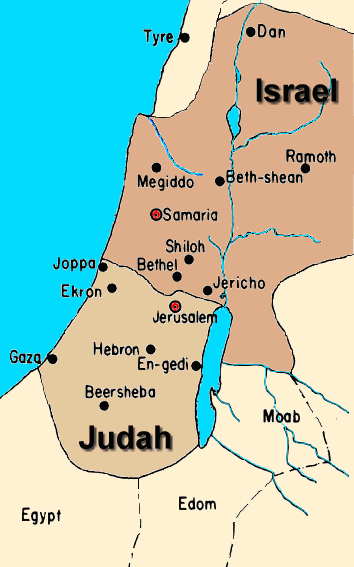
quote:Isaiah 20:4 So shall the king of Assyria lead away the Egyptians prisoners, and the Ethiopians captives, young and old, naked and barefoot, even with their buttocks uncovered, to the shame of Egypt.
Originally posted by the lioness,:
these short legged bearded people don't resemble Egyptians
quote:And this means that the Egyptians were short legged and had beards?
Originally posted by Trollkillah # Ish Gebor:
quote:Isaiah 20:4 So shall the king of Assyria lead away the Egyptians prisoners, and the Ethiopians captives, young and old, naked and barefoot, even with their buttocks uncovered, to the shame of Egypt.
Originally posted by the lioness,:
these short legged bearded people don't resemble Egyptians
quote:Where did you read that?
Originally posted by the lioness,:
quote:And this means that the Egyptians were short legged and had beards?
Originally posted by Trollkillah # Ish Gebor:
quote:Isaiah 20:4 So shall the king of Assyria lead away the Egyptians prisoners, and the Ethiopians captives, young and old, naked and barefoot, even with their buttocks uncovered, to the shame of Egypt.
Originally posted by the lioness,:
these short legged bearded people don't resemble Egyptians
quote:Normally when people reply to a remark and quote that remark, their reply is related in subject
Originally posted by Trollkillah # Ish Gebor:
quote:Where did you read that?
Originally posted by the lioness,:
quote:And this means that the Egyptians were short legged and had beards?
Originally posted by Trollkillah # Ish Gebor:
quote:Isaiah 20:4 So shall the king of Assyria lead away the Egyptians prisoners, and the Ethiopians captives, young and old, naked and barefoot, even with their buttocks uncovered, to the shame of Egypt.
Originally posted by the lioness,:
[qb] these short legged bearded people don't resemble Egyptians
quote:Normally when people receive a question they simple it, you were making a suggestion or at least something like that.
Originally posted by the lioness,:
quote:Normally when people reply to a remark and quote that remark, their reply is related in subject
Originally posted by Trollkillah # Ish Gebor:
quote:Where did you read that?
Originally posted by the lioness,:
quote:And this means that the Egyptians were short legged and had beards?
Originally posted by Trollkillah # Ish Gebor:
quote:Isaiah 20:4 So shall the king of Assyria lead away the Egyptians prisoners, and the Ethiopians captives, young and old, naked and barefoot, even with their buttocks uncovered, to the shame of Egypt.
Originally posted by the lioness,:
[qb] these short legged bearded people don't resemble Egyptians
So if I say these short legged bearded people don't resemble Egyptians and then somebody quotes me and replies it's a good assumption that that their remark will be related to my remark
However you rountinely quote people and then the remark you make after it is unrelated to the quote, just random
quote:My remark was an observation not something I read
Originally posted by Trollkillah # Ish Gebor:
Ps, ^they answer simple it
quote:Oh, so that's why you nitpicked on this biblical text? You can always change it if you want.
Originally posted by the lioness,:
quote:My remark was an observation not something I read
Originally posted by Trollkillah # Ish Gebor:
Ps, ^they answer simple it
Tukular posted a Lachish relief and remarked
"Remember, the northern kingdom is closer to the
Caucasus while the southern kingdom is next door
to Egypt."
I observed the people in the relief didn't look like Egyptians and both you and Tukular agree with this, so stop nitpicking, thanks in advance
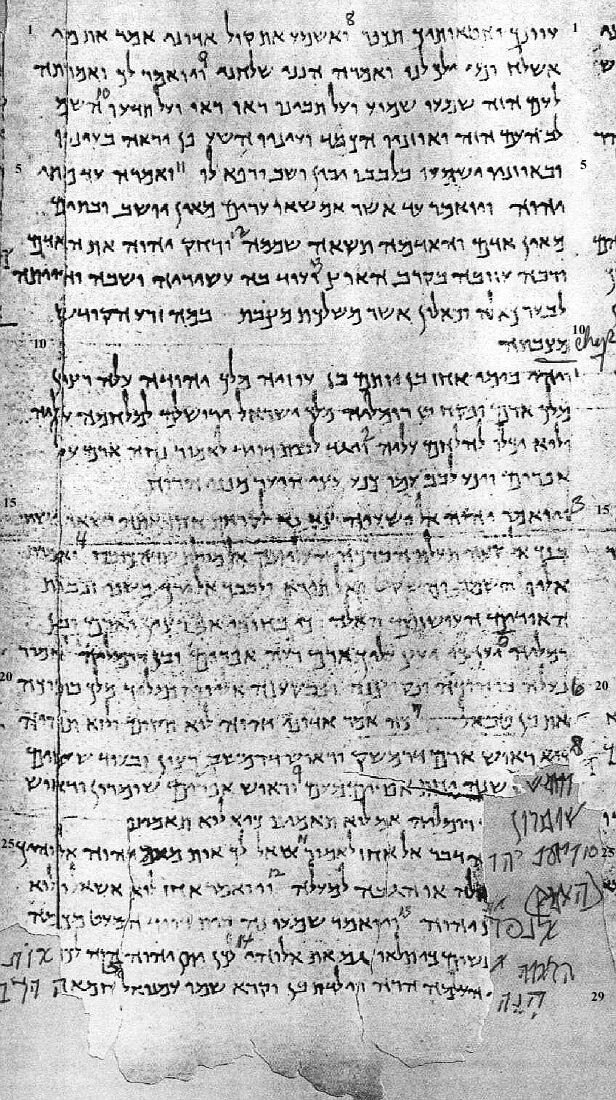
quote:Different haircut & different style of clothing. Remember that they EASILY passed for Egyptian when they wore Egyptian attire, as scripture states when Joseph passed for one (his brothers didn't recognize him, remember?) , Moses passed for one (being brought up by Egyptians, and being mistaken for one in Midian) and the whole congregation of Israel & Egyptians were described as being Egyptian when they went up to Jordan to bury Jacob.
Originally posted by the lioness,:
these short legged bearded people don't resemble Egyptians
quote:You mean to tell be these short legged Israelites and Assyrians
Originally posted by Snakepit1:
quote:Different haircut & different style of clothing. Remember that they EASILY passed for Egyptian when they wore Egyptian attire, as scripture states when Joseph passed for one (his brothers didn't recognize him, remember?) , Moses passed for one (being brought up by Egyptians, and being mistaken for one in Midian) and the whole congregation of Israel & Egyptians were described as being Egyptian when they went up to Jordan to bury Jacob.
Originally posted by the lioness,:
these short legged bearded people don't resemble Egyptians
They looked virtually indistinguishably from one another, phenotypically speaking. The Levitical laws are a testament to this (yellow/blonde-limp hair & white skin being equated to a curse/plague (leprosy) ) fact also.
There's no use discussing the phenotypical appearance to any of the indigenous peoples of North East Africa (which is what Arabia/Levant/Mesopotamia really is) .

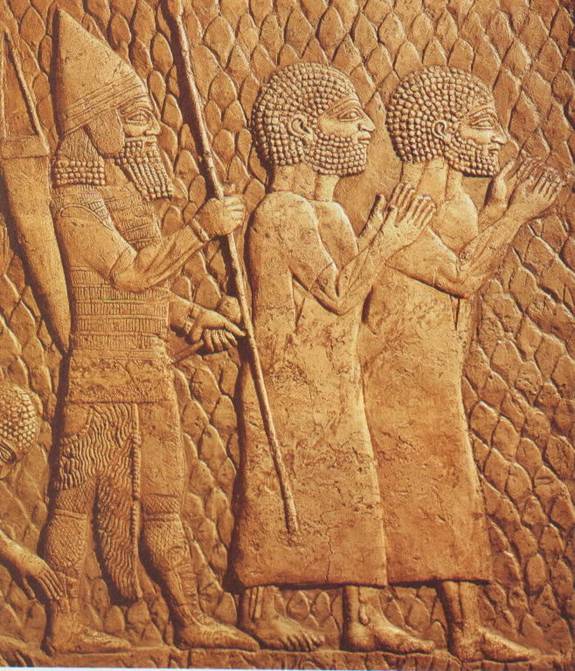


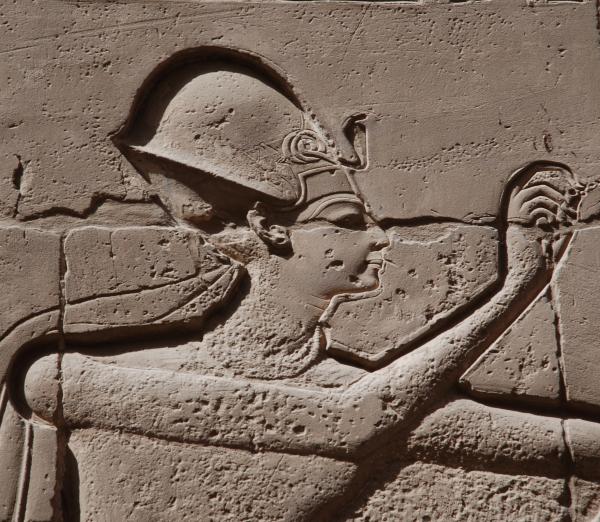

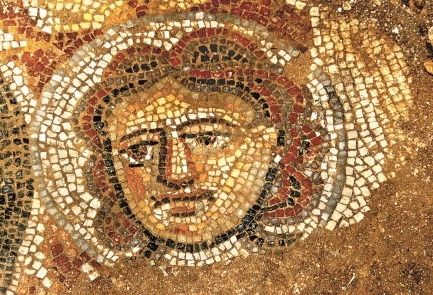
quote:who wrote the sentence>
Originally posted by Tukuler:
[QB] According to Ruth Jacoby's chapter in the
Sixth Archaeological Conference in Israel
(Tel-Aviv, 14-15 March 1979) / Collectif. -
Jerusalem : Israel Exploration Society, 1979
the frieze is an execution in reality of how
Lachish's Judahites actually looked like.

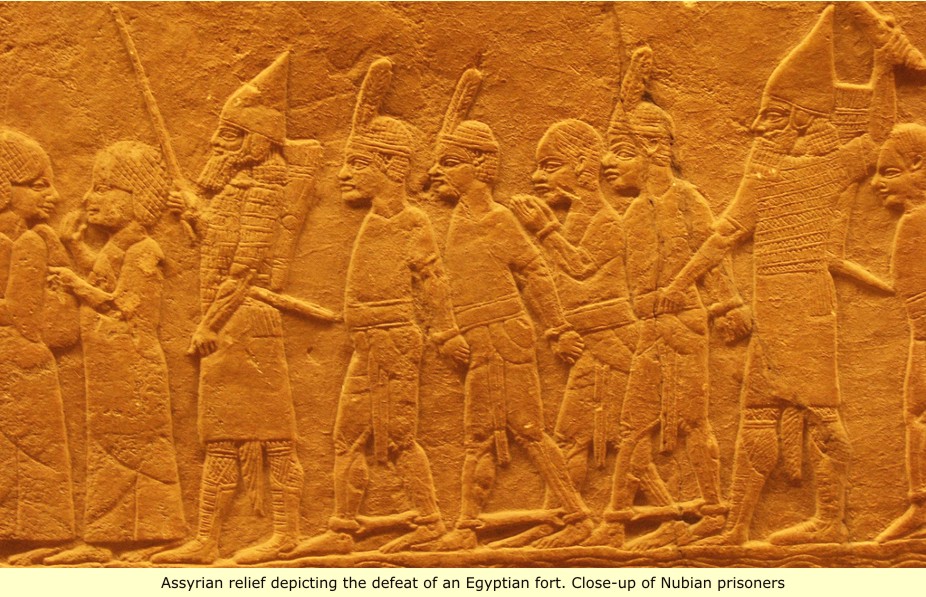

quote:this is too small to see anything
Originally posted by Tukuler:
courtesy of Mike111
quote:I don't see how both figures having the same clothing puts their ethnicity in question. (although what you can tell by looking at either figure is limited)
Originally posted by Tukuler:
Notice these two bowing figures
the bottom one is assumed to Yehu king of Israel
but the top figure has the exact same hat clothes
and shoes.
This is why some scholars doubt Yehu is depicted
instead of some servitor in Shalmanessar's employ.
quote:This is odd. You are saying there is no dispute of accuracy and then you say don't refer to the art.
Originally posted by Tukuler:
Sennacherib's frieze of Judahites leaves no room
for doubt and has no serious dispute of accuracy.
As for limb proportions compare Assyrians to Kushites/Egyptians in Assyrian art not from various different sources of art style.
quote:that may be correct but do you have a source?
Originally posted by Tukuler:
Remember, in general ancient Egyptians were
short and ancient Sudanese were rather tall.
quote:
Originally posted by Tukuler:

quote:^^^ If these are accurate these adults had the proportions of boys aged about 9 years old maybe
Originally posted by the lioness,:
Figure 1.--This Assyrian carving at Lachish shows Hebrews being led into exile by Sargon's son Sennacherib after Hezekiah's failed revolot (701 BC).

Assyrirans with Hebrew captives



quote:You've been writing this shyt for years now.
Originally posted by the lioness,:
The full facial hair is not typical of Africans although some have it.


quote:Who made that "art depiction"?
Originally posted by the lioness,: Their legs are very short compared to their trunks. This is the cold adapted ratio and is quite unlike much of the elongated types in the Egyptian art.
Did the people really have these child-like proportions or was it an artistic style? I don't know
quote:For sure, it's not bone straight.
Originally posted by the lioness,: Is their hair afro or curly? I don't know.
quote:Pardon the intrusion:
Originally posted by Trollkillah # Ish Gebor:
quote:You've been writing this shyt for years now.
Originally posted by the lioness,:
The full facial hair is not typical of Africans although some have it.
quote:The Egyptian Coptic scripts speak of Moses as having dark skin. It is also stated that he had little horns on his head, so did Aaron.
Originally posted by Snakepit1:
quote:Different haircut & different style of clothing. Remember that they EASILY passed for Egyptian when they wore Egyptian attire, as scripture states when Joseph passed for one (his brothers didn't recognize him, remember?) , Moses passed for one (being brought up by Egyptians, and being mistaken for one in Midian) and the whole congregation of Israel & Egyptians were described as being Egyptian when they went up to Jordan to bury Jacob.
Originally posted by the lioness,:
these short legged bearded people don't resemble Egyptians
They looked virtually indistinguishably from one another, phenotypically speaking. The Levitical laws are a testament to this (yellow/blonde-limp hair & white skin being equated to a curse/plague (leprosy) ) fact also.
There's no use discussing the phenotypical appearance to any of the indigenous peoples of North East Africa (which is what Arabia/Levant/Mesopotamia really is) .



quote:
Originally posted by Tukuler:
Notice these two bowing figures
the bottom one is assumed to Yehu king of Israel
but the top figure has the exact same head cover
and clothes. Comparing the retainers reveals the
same thing plus same foot coverings, iirc.
This is why some scholars doubt Yehu is depicted
instead of some servitor in Shalmanessar's employ.
Sennacherib's frieze of Judahites leaves no room
for doubt and has no serious dispute of accuracy.
As for limb proportions compare Assyrians to Kushites/Egyptians in Assyrian art not from various different sources of art style. Compare
the below in light of this quote "compared to the short stubby Assyrians and Hebrews" as far as who's "shortest" and "stubbiest" nevermind
the Assyrian artist's canon. And remember, in general, ancient Egyptians were short and ancient Sudanese were rather tall.
courtesy of Mike111

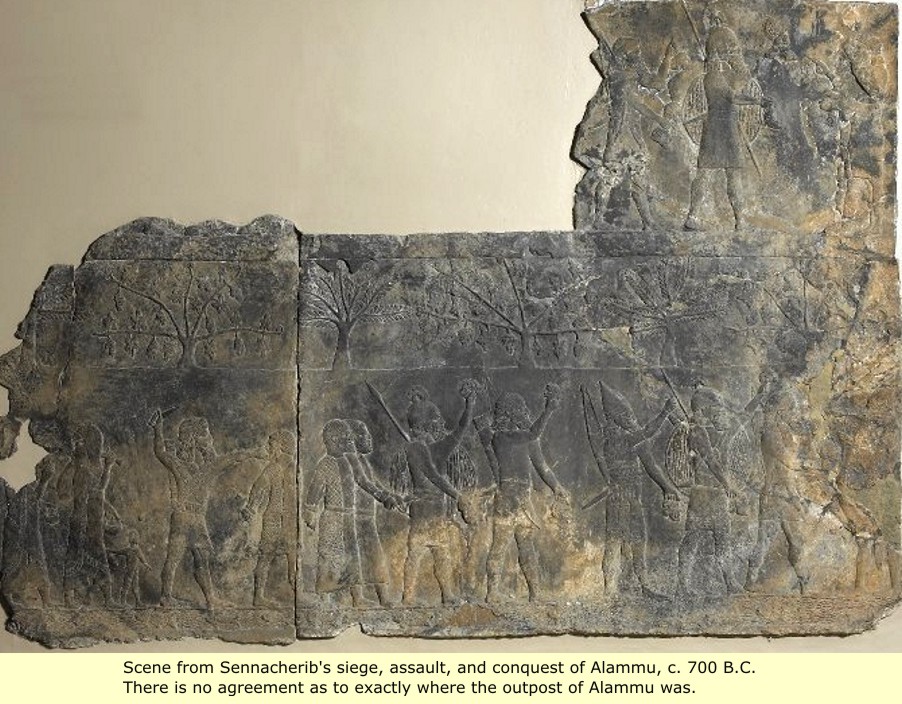
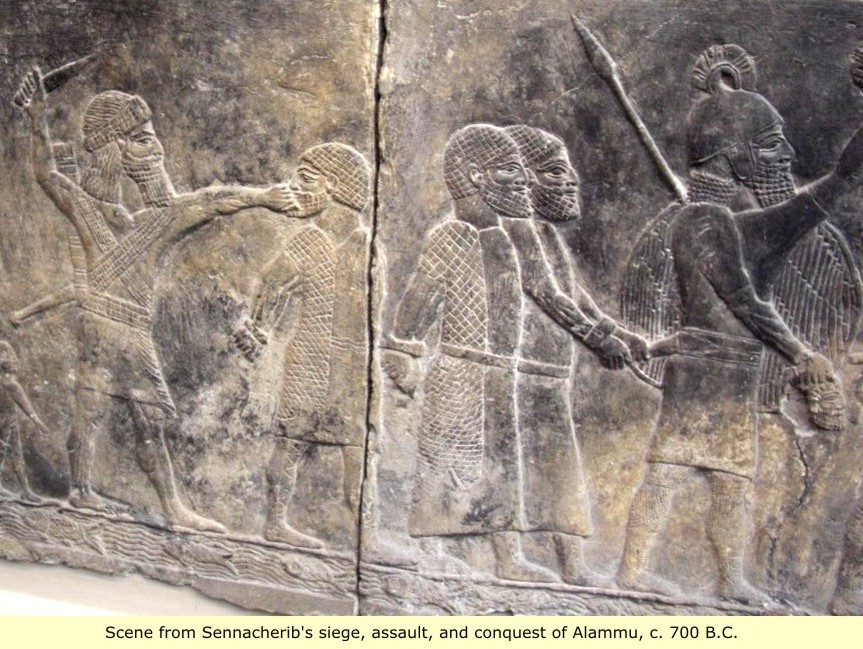
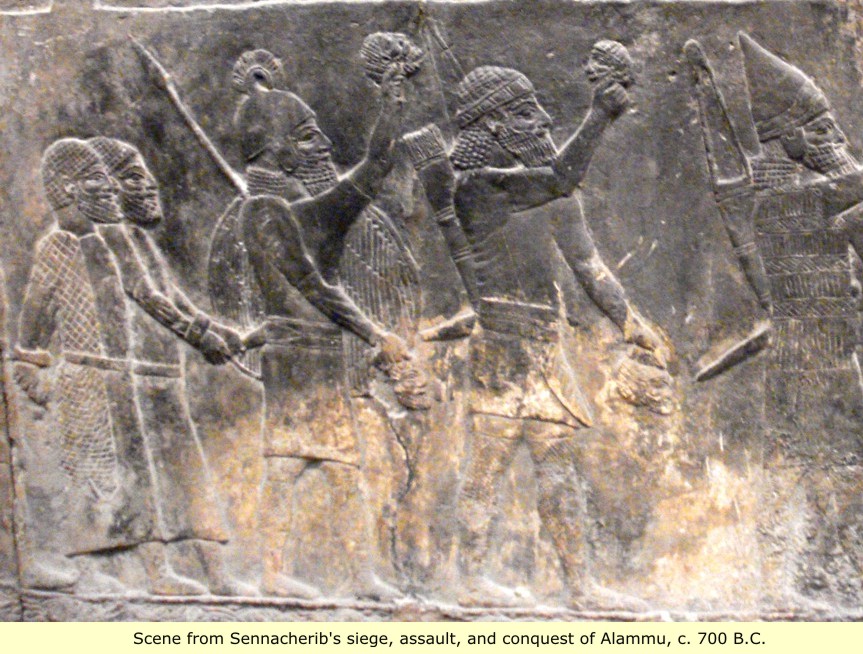

quote:That I know of, yes.
Originally posted by Tukuler:
Are those all the scenes that are available?
quote:
Originally posted by the lioness,:
quote:that may be correct but do you have a source?
Originally posted by Tukuler:
Remember, in general ancient Egyptians were
short and ancient Sudanese were rather tall.

quote:.
Originally posted by Snakepit1:
quote:Different haircut & different style of clothing. Remember that they EASILY passed for Egyptian when they wore Egyptian attire, as scripture states when Joseph passed for one (his brothers didn't recognize him, remember?) , Moses passed for one (being brought up by Egyptians, and being mistaken for one in Midian) and the whole congregation of Israel & Egyptians were described as being Egyptian when they went up to Jordan to bury Jacob.
Originally posted by the lioness,:
these short legged bearded people don't resemble Egyptians
They looked virtually indistinguishably from one another, phenotypically speaking. The Levitical laws are a testament to this (yellow/blonde-limp hair & white skin being equated to a curse/plague (leprosy) ) fact also.
There's no use discussing the phenotypical appearance to any of the indigenous peoples of North East Africa (which is what Arabia/Levant/Mesopotamia really is) .


quote:^^^ This is my original remark
Originally posted by the lioness:
these short legged bearded people don't resemble Egyptians
quote:This would correspond to zarahan's often quoted:
Originally posted by the lioness:
^^^ If these are accurate these adults had the proportions of boys aged about 9 years old maybe
Their legs are very short compared to their trunks. This is the cold adapted ratio and is quite unlike much of the elongated types in the Egyptian art.
quote:I don't know if this quote is comprehensive to all ancient Near East body proportions but I can't believe people are now pulling out the bible as if it's a historical document and going against zarahan's teachings
Originally posted by zarahan- aka Enrique Cardova:
Northern Egypt near the Mediterranean shows the same pattern- limb length data puts its peoples closer to tropically adapted Africans that cold climate Europeans
"..sample populations available from northern Egypt from before the 1st Dynasty (Merimda, Maadi and Wadi Digla) turn out to be significantly different from sample populations from early Palestine and Byblos, suggesting a lack of common ancestors over a long time. If there was a south-north cline variation along the Nile valley it did not, from this limited evidence, continue smoothly on into southern Palestine. The limb-length proportions of males from the Egyptian sites group them with Africans rather than with Europeans." (Barry Kemp, "Ancient Egypt Anatomy of a Civilisation. (2005) Routledge. p. 52-60)
quote:^^when I said this it should have been assumed that I am not simply saying the people were short. I was saying in this Lachish
Originally posted by the lioness:
look at how long and thin they are compared to the short stubby Assyrians and Hebrews who look similar






quote:Look at the Assyrian on the right, his beard
Originally posted by Mike111:
[QB] Since you all seem interested in identifying Assyrian victims, why not try your hand at identifying who the Alammu are.
Their hair seems short and tightly curled like "Some" Hebrews, which has caused some people to guess that they were Hebrews.
But others, looking at other things say they are eastern people.
SENNACHERIB’S SIEGE, ASSAULT, AND CONQUEST OF ALAMMU
Davide Nadali

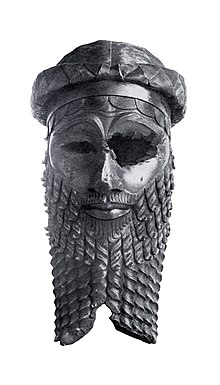
quote:I don't understand what these pictures have to do with the subject at hand? What are you suggesting?
Originally posted by the lioness,:


quote:SEEN
Originally posted by Mike111:
Go away lioness, no one is interested in pursuing stupidity with you.
quote:-that a lot of different types of people could have hair like the sculpture.
Originally posted by Trollkillah # Ish Gebor:
quote:I don't understand what these pictures have to do with the subject at hand? What are you suggesting?
Originally posted by the lioness,:





quote:Yes, left out the African American.
Originally posted by the lioness,:
funny how, in trying to set me up, you left out the black people I had included.
I will put them back in for the quote
quote:-that a lot of different types of people could have hair like the sculpture.
Originally posted by Trollkillah # Ish Gebor:
quote:I don't understand what these pictures have to do with the subject at hand? What are you suggesting?
Originally posted by the lioness,:




and that you can't even tell exactly what type of hair that is supposed to be
and therefore you can't use this sculpture to say that these figures, supposedly Hebrew were necessarily black African type people, excluding other possibilities.
I'm not saying they are not black African type people.
I'm saying that you can't say they are for sure
or even be close to being sure.
You can only say black Africans are one of several types of people who might have that type of hair
That is an honest objective observation
^^^ similarly you can't assume these similar figures are for sure African type people with "nappy hair" as one poster said
quote:The Assyrians were African types?
Originally posted by Tukuler:
Well we see here some of Asia's blacks also have nappy hair.
quote:The subject of this thread is the Black Obelisk of Shalmaneser III located in Northen Iraq.
Originally posted by Trollkillah # Ish Gebor:
But what is it these other two have to do with the subject?
What is it your implying? You have them up every so what minute.
quote:Question..., did blacks ever make it to Assyria?
Originally posted by the lioness,:
quote:The Assyrians were African types?
Originally posted by Tukuler:
Well we see here some of Asia's blacks also have nappy hair.
quote:I said African types
Originally posted by Trollkillah # Ish Gebor:
quote:Question..., did blacks ever make it to Assyria?
Originally posted by the lioness,:
quote:The Assyrians were African types?
Originally posted by Tukuler:
Well we see here some of Asia's blacks also have nappy hair.
quote:Can you say what type of Human is NOT African type?
Originally posted by the lioness,:
Question..., did blacks ever make it to Assyria?
I said African types
quote:
Originally posted by Mike111:
Can you say what type of Human is NOT African type?
And how do you prove this when just about all science says that "ALL" Humans are Africans.
quote:
Originally posted by Mike111:
Speaking of seeing for myself, to aid that effort, I took the trouble to provide an Albino skull for comparison.
quote:So, you imply that blacks never made it to Assyria, right?
Originally posted by the lioness,:
quote:I said African types
Originally posted by Trollkillah # Ish Gebor:
quote:Question..., did blacks ever make it to Assyria?
Originally posted by the lioness,:
quote:The Assyrians were African types?
Originally posted by Tukuler:
Well we see here some of Asia's blacks also have nappy hair.
"black" is a social construct term
It is therefore what it means is open to widely varied interpretation and is not, in recent thinking, considered a scientific term ("nappy" isn't either)
"African type" refers to a specific geographic location, Africa
Also, whether an African type person made it to some location 40-50,000 years ago is irrelevant to specific populations in Assyria or Lachish 2,700 years ago
Within that span of time people evolve adpatations to new climates, drift and isolation and admixture may also be at play
![[Smile]](smile.gif)
quote:Lioness, what is an albino skull?
Originally posted by the lioness,:
quote:
Originally posted by Mike111:
Can you say what type of Human is NOT African type?
And how do you prove this when just about all science says that "ALL" Humans are Africans.quote:
Originally posted by Mike111:
Speaking of seeing for myself, to aid that effort, I took the trouble to provide an Albino skull for comparison.
quote:You'll have to ask Mike it's his dumb ass term
Originally posted by Trollkillah # Ish Gebor:
Lioness, what is an albino skull?
quote:Oh, but you cited it for comparison.
Originally posted by the lioness,:
quote:You'll have to ask Mike it's his dumb ass term
Originally posted by Trollkillah # Ish Gebor:
Lioness, what is an albino skull?
quote:I don't understand how you can cite something for contradiction, if you don't know what it means in the first place.
Originally posted by the lioness,:
I cited it for contradicition
![[Smile]](smile.gif)

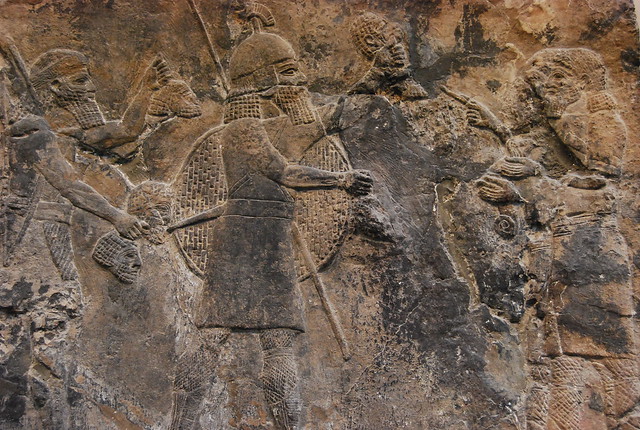
quote:So you're suggesting that these people you've posted depict ancient Hebrews? Or that they depict those from the hieroglyphs being taken as captives to Assyria?
Originally posted by the lioness,:


quote:By now I have explained myself very clearly
Originally posted by the lioness,:
funny how, in trying to set me up, you left out the black people I had included....
To make comparisons on hair type I compared the Lachish relief to an African Amercian, European Americans and a Beja
So why are you asking me about a specific two ?


quote:
Originally posted by Tukuler:
quote:.
Originally posted by Snakepit1:
quote:Different haircut & different style of clothing. Remember that they EASILY passed for Egyptian when they wore Egyptian attire, as scripture states when Joseph passed for one (his brothers didn't recognize him, remember?) , Moses passed for one (being brought up by Egyptians, and being mistaken for one in Midian) and the whole congregation of Israel & Egyptians were described as being Egyptian when they went up to Jordan to bury Jacob.
Originally posted by the lioness,:
these short legged bearded people don't resemble Egyptians
They looked virtually indistinguishably from one another, phenotypically speaking. The Levitical laws are a testament to this (yellow/blonde-limp hair & white skin being equated to a curse/plague (leprosy) ) fact also.
There's no use discussing the phenotypical appearance to any of the indigenous peoples of North East Africa (which is what Arabia/Levant/Mesopotamia really is) .
Also in the Greek books Paul, the
Judean founder of Christianity was
mistaken for an Egyptian
- Art not thou that Egyptian ...
Acts 21:38
This aligns with Greco-Latin thought
One of the customs most zealously observed among the
Aegyptians is this, that they rear every child that is born,
and circumcise the males, and excise the females, as is
also customary among the Judaeans, who also are Aegyptian
in origin, as I have already stated in my account of them.
Strabo
then there's the most popular Roman
opinion that Judeans are an Æthiopian
subset.
The majority of people say the Judaeans were
those Ethiopians whom fear and hatred obliged
to change their habitations, in the reign of king
Cepheus.
Tacitus -- The Histories Book V








quote:I'm asking what they have to do with the topic and the account? But you give some weird answers. While you removed this biblical citation.
Originally posted by the lioness,:
repost
quote:By now I have explained myself very clearly
Originally posted by the lioness,:
funny how, in trying to set me up, you left out the black people I had included....
To make comparisons on hair type I compared the Lachish relief to an African Amercian, European Americans and a Beja
So why are you asking me about a specific two ?
You have nothing to contribute to the topic
You will destroy any thread, going in circles , reposting over and over again, not advancing any knowledge but only trying to play a game of test the lioness
I can't go with you there
It's very boring and repetative

quote:So, can you explain why curly and nappy hair is not strange in Europe. But loose to straight hair is to Africa?
Originally posted by the lioness,:

Both pictures above are people from Lachish being deported by the Assyrians.
These figures appear in the same scene,
on the same path, with Assyrians in between them
Notice how the top figure at the ox cart has a skull cap-ish looking head gear and some kind of thing hanging down the side, perhaps a side lock, the figures in front perhaps women
Are the figures in both pictures Hebrews? Historians aren't sure.
Why do they look quite different ? It's odd
If one group is not Hebrew that could not be determined with certainty, I've read the sources
___________________________________
Now let's look at the hair/beards of the lower figures for a moment
part of Assyrian's hair
captive figure's beard
^^^^^ Both of these parts of their hair or beards look the same.
The dotted look, perhaps a bit of an artistic interpretation of hair not super realistic
However it is closer in scale to curly type of hair like the two people below:
The "dotted" look
^^^ this type of hair is not uncommon in Jews, it's called the "Jew fro"
Curly hair is also not that rare in Europeans.
It doesn't mean the Lachish figures are European.
It means you can't exclude a wide range of possibilites
for their ethnicity based on the
hair representation on these reliefs
____________________________________
The hair on those Lachish figures
is not as close to nappy hair with a much finer texture,
very small type frizzy curls like this >>
Nappy Nap

__________________________________________
and to use this relief to say for sure these figures formn Lachish are black African types is silly, you can't fool the lioness
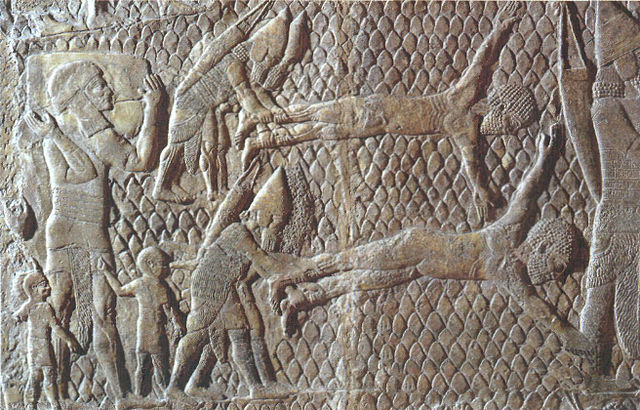
quote:Google Assyrians and Ethiopians/ Cush.
Originally posted by the lioness,:
look up jewfro in google images
quote:why are you quoting this?
Originally posted by Trollkillah # Ish Gebor:
Isaiah 20:4 So shall the king of Assyria lead away the Egyptians prisoners, and the Ethiopians captives, young and old, naked and barefoot, even with their buttocks uncovered, to the shame of Egypt.

quote:And who exactly invaded the region Lachish and took the captives, yep the Assyrians...
Originally posted by the lioness,:
quote:why are you quoting this?
Originally posted by Trollkillah # Ish Gebor:
Isaiah 20:4 So shall the king of Assyria lead away the Egyptians prisoners, and the Ethiopians captives, young and old, naked and barefoot, even with their buttocks uncovered, to the shame of Egypt.
the side topic was the invasion of Lachish not of Egypt
As per the invasion of Egypt the Assyrians were said to have brought some of the captives to various parts of their Mesopotamian empire
![[Smile]](smile.gif)




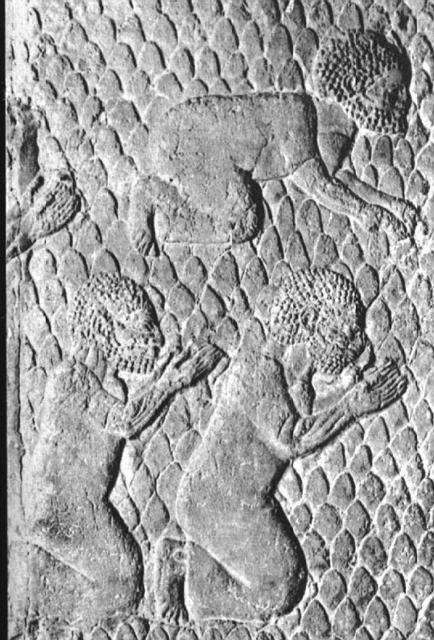


quote:so why do you keep asking me if Africans entered the region of Assyria. ?
Originally posted by the lioness,:
As per the invasion of Egypt the Assyrians were said to have brought some of the captives to various parts of their Mesopotamian empire
quote:Nice headware,
Originally posted by the lioness,:
The Lachish reliefs: A Judean family deported form the conquered city
quote:I keep asking this because it's critical in the analysis.
Originally posted by the lioness,:
Trollkillah I shouldn't reply to you at all
I already said this
quote:so why do you keep asking me if Africans entered the region of Assyria. ?
Originally posted by the lioness,:
As per the invasion of Egypt the Assyrians were said to have brought some of the captives to various parts of their Mesopotamian empire
In other words -yes-
the Assyrians were said to have brought some of the captives to various parts of their Mesopotamian empire, Assyria
quote:The Assyrians deported conquered peoples from their homelands as a hedge against rebellion. However they didn't necessarily deport them to Assyria itself (Northern Mesopotamia/Iraq), but rather, to other parts of the Assyrian Empire, which at its height, included everything from Elam/Persia west to Egypt.
Originally posted by Trollkillah # Ish Gebor:
I keep asking this because it's critical in the analysis.
So, we now have come to the conclusion that indeed Africans/ Cushitics/ Ethiopians were taken as captives to Assyria by Assyrians.
We have this in depiction and in recorded historical account, correct?
quote:I don't know you'll have to research that
Originally posted by Trollkillah # Ish Gebor:
we now have come to the conclusion that indeed Africans/ Cushitics/ Ethiopians were taken as captives to Assyria by Assyrians.
We have this in depiction and in recorded historical account, correct?
quote:Why do you demand, or rather is it required for them to have beards necessarily?
Originally posted by the lioness,:
Daily Life of the Nubians
By Robert Steven Bianch
_____________________________________
Lachich, city of Judea
The Lachish reliefs: Judean family
deported from the conquered city

detail form above scene
Ancient Near Eastern Art
By Dominique Collon
^^^ It could be true that these are a defeated Nubian garrison in Lachish bowing to Sennacherib
However I hesitate to agree because Nubians are portrayed at the palace of Arshurbanipal without beards (as well as later at Persepolis). I'm not sure about it
_________________________________________________________



quote:Yes, people tend to have facial differences. I am not going to object that.
Originally posted by the lioness,:
also the facial features are different
Lachish man deported by Assyrians
![[Smile]](smile.gif)
quote:You have a picture of an Ethiopian who could also be classified as Nubian, who is also beardless and a few hundred years after the Siege of Lachish is in Iraq bringing gifts of gold, ivory, ebony and slaves to the Persians
Originally posted by Trollkillah # Ish Gebor:

Isaiah 20:4 So shall the king of Assyria lead away the Egyptians prisoners, and the Ethiopians captives, young and old, naked and barefoot, even with their buttocks uncovered, to the shame of Egypt.
quote:So, now deal with several groups who had happy Afro hair, who were taken as captives to Assyria by Assyrians. That's the confirmation I was looking for.
Originally posted by the lioness,:
quote:You have a picture of an Ethiopian who could also be classified as Nubian, who is also beardless and a few hundred years after the Siege of Lachish is in Iraq bringing gifts of gold, ivory, ebony and slaves to the Persians
Originally posted by Trollkillah # Ish Gebor:

Isaiah 20:4 So shall the king of Assyria lead away the Egyptians prisoners, and the Ethiopians captives, young and old, naked and barefoot, even with their buttocks uncovered, to the shame of Egypt.
not a naked captive as described in the Bible quote, that applies to an earlier period
quote:What evidence do you have that this man is a Nubian/Ethiopian?
Originally posted by the lioness,:

You have a picture of an Ethiopian who could also be classified as Nubian, who is also beardless and a few hundred years after the Siege of Lachish is in Iraq bringing gifts of gold, ivory, ebony and slaves to the Persians
not a naked captive as described in the Bible quote, that applies to an earlier period
quote:I am aware you don't think this is an African
Originally posted by Mike111:
quote:What evidence do you have that this man is a Nubian/Ethiopian?
Originally posted by the lioness,:

You have a picture of an Ethiopian who could also be classified as Nubian, who is also beardless and a few hundred years after the Siege of Lachish is in Iraq bringing gifts of gold, ivory, ebony and slaves to the Persians
not a naked captive as described in the Bible quote, that applies to an earlier period
A better question would be why do you continue to make false statements, even after you have been proven wrong many times?
quote:you think that's an African Trollkillah?
Originally posted by Trollkillah # Ish Gebor:
So, did African types ever make it to Assyria?![[Smile]](smile.gif)

quote:On what do you base he is Ethiopian, instead of Nubian?
Originally posted by Trollkillah # Ish Gebor:
quote:So, now deal with several groups who had happy Afro hair, who were taken as captives to Assyria by Assyrians. That's the confirmation I was looking for.
Originally posted by the lioness,:
quote:You have a picture of an Ethiopian who could also be classified as Nubian, who is also beardless and a few hundred years after the Siege of Lachish is in Iraq bringing gifts of gold, ivory, ebony and slaves to the Persians
Originally posted by Trollkillah # Ish Gebor:

Isaiah 20:4 So shall the king of Assyria lead away the Egyptians prisoners, and the Ethiopians captives, young and old, naked and barefoot, even with their buttocks uncovered, to the shame of Egypt.
not a naked captive as described in the Bible quote, that applies to an earlier period
I think we are getting somewhere.
quote:
Originally posted by the lioness,:
also the facial features and head shapes are different, the man below marked "Lachish" has a round head, the Nubians at right, oval shaped
Lachish man deported by Assyrians
^^^ here at left is the Lachish man being deported with his family, same as the head above.
To his right Assyrians are holding two different looking tuype men horizontally. They have dotted looking hair like the other Lachish head above and I have read they are being flayed, having their skin removed
quote:http://www.britishmuseum.org/explore/highlights/highlight_objects/me/s/panel,_palace_of_sennacherib-4.aspx
Nineveh, northern Iraq, Neo-Assyrian, about 700-681 BC
This alabaster panel was part of a series which decorated the walls of a room in the palace of King Sennacherib (reigned 704-681 BC). It tells the story of the siege and capture of the city of Lachish in 701 BC
The story continues from the previous panel (no. 9) of the relief. This section decorated a corner of the room.
Having been exiled from their city, the people of Lachish move through the countryside to be resettled elsewhere in the Assyrian Empire. Below them high officials and foreigners are being tortured and executed. It is likely that they are being flayed alive.
The foreigners are possibly officers from Nubia. The Nubians were seen as sharing responsibility for the rebellion. Much of Egypt at this time was ruled by a line of kings from Nubia (the Twenty-fifth Dynasty) who were keen to interfere in the politics of the Levant, to contain the threat of Assyrian expansion.
As Sennacherib's forces laid siege to Lachish, an Egyptian army appeared, led by a man called Taharqa, according to the Old Testament. He may be the later pharaoh of Egypt with the same name (690-664 BC).
Sennacherib's account claims that the rebels had called on the support of the kings of Egypt (Delta princes) and the Kings of Kush (Nubia). The armies clashed on the plain of Eltekeh. While Sennacherib claimed victory, he was still not able to capture Jerusalem.
The story continues on the next panel (no. 11) of the relief.
quote:http://www.britishmuseum.org/explore/highlights/highlight_objects/me/s/stone_relief,_sw_palace.aspx
Stone relief from the South-West Palace of Sennacherib
Nineveh, northern Iraq
Neo-Assyrian, about 704-681 BC
Prisoners, probably from Phoenicia or Palestine, playing lyres
This is one small surviving fragment from a much larger composition. The scale effect on the background represents rough ground.
The musicians are often thought to have come from the state of Judah, though there is no evidence for this. The style of their dress is different to that worn by the people of Lachish (see for example, a panel showing the siege of Lachish). They are, however, almost certainly Western or Levantine in origin.
Music was clearly an important part of court life and Assyrian kings often refer to taking musicians into captivity as part of the deportation of defeated peoples. There is evidence of music in religious practice at an earlier period, but reliefs like this provide the first images of musical instruments in an ancient Near Eastern society that are not connected with a religious ceremony.
The musicians are playing lyres. They hold them more or less horizontally and use a plectrum. This type of lyre was possibly introduced into Assyria from the West in the first half of the second millennium BC. Only a few are known and the chronology and classification of the many forms of lyre in the Near East in the first millennium is neither complete nor certain.
J.E. Reade, Assyrian sculpture-1 (London, The British Museum Press, 1998)

quote:
Originally posted by the lioness,:
quote:I am aware you don't think this is an African
Originally posted by Mike111:
quote:What evidence do you have that this man is a Nubian/Ethiopian?
Originally posted by the lioness,:

You have a picture of an Ethiopian who could also be classified as Nubian, who is also beardless and a few hundred years after the Siege of Lachish is in Iraq bringing gifts of gold, ivory, ebony and slaves to the Persians
not a naked captive as described in the Bible quote, that applies to an earlier period
A better question would be why do you continue to make false statements, even after you have been proven wrong many times?
Trollkillah first put up this picture in the thread
Let's let him verify the ethnicity of it, he left out info on it
quote:you think that's an African Trollkillah?
Originally posted by Trollkillah # Ish Gebor:
So, did African types ever make it to Assyria?![[Smile]](smile.gif)



quote:
Originally posted by the lioness,:
quote:The subject of this thread is the Black Obelisk of Shalmaneser III located in Northen Iraq.
Originally posted by Trollkillah # Ish Gebor:
But what is it these other two have to do with the subject?
What is it your implying? You have them up every so what minute.
People didn't like that subject so I allowed myself to participate in a change of subject to reliefs in Lachish, Israel
To make comparisons on hair type I compared the Lachish relief to an African Amercian, European Americans and a Beja
So why are you asking me about a specific two ?
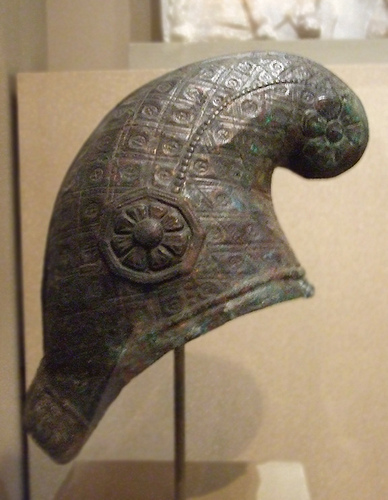

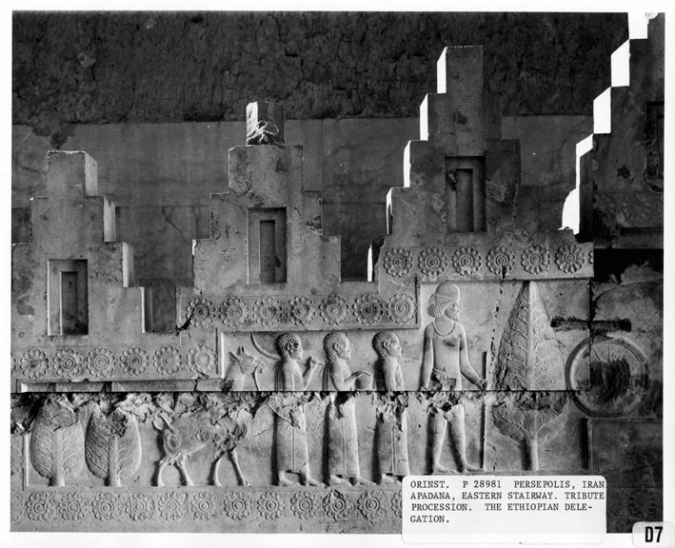

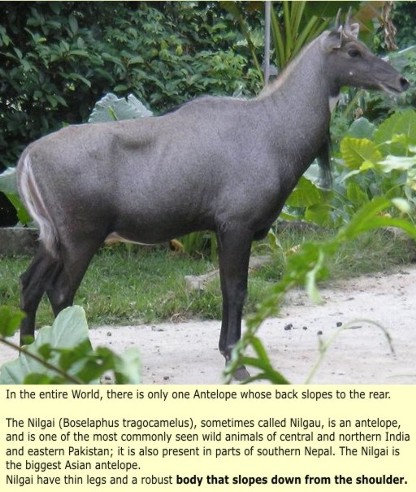
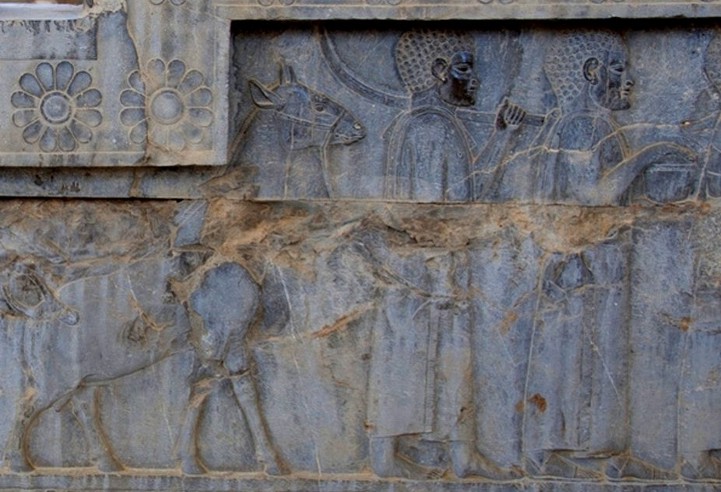
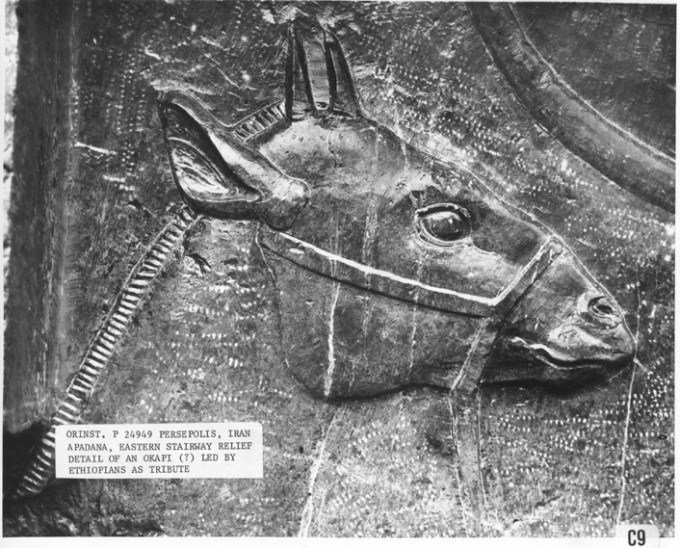
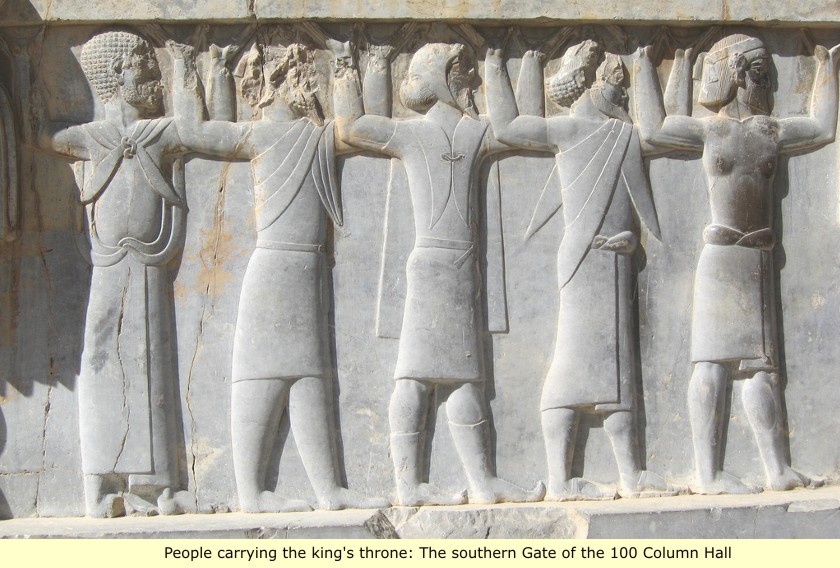
quote:http://www.britishmuseum.org/explore/highlights/highlight_objects/me/s/stone_relief,_sw_palace.aspx
Stone relief from the South-West Palace of Sennacherib
Nineveh, northern Iraq
Neo-Assyrian, about 704-681 BC
Prisoners, probably from Phoenicia or Palestine, playing lyres
This is one small surviving fragment from a much larger composition. The scale effect on the background represents rough ground.
The musicians are often thought to have come from the state of Judah, though there is no evidence for this. The style of their dress is different to that worn by the people of Lachish (see for example, a panel showing the siege of Lachish). They are, however, almost certainly Western or Levantine in origin.
Music was clearly an important part of court life and Assyrian kings often refer to taking musicians into captivity as part of the deportation of defeated peoples. There is evidence of music in religious practice at an earlier period, but reliefs like this provide the first images of musical instruments in an ancient Near Eastern society that are not connected with a religious ceremony.
The musicians are playing lyres. They hold them more or less horizontally and use a plectrum. This type of lyre was possibly introduced into Assyria from the West in the first half of the second millennium BC. Only a few are known and the chronology and classification of the many forms of lyre in the Near East in the first millennium is neither complete nor certain.
J.E. Reade, Assyrian sculpture-1 (London, The British Museum Press, 1998)
quote:Please identify the metal helmet
Originally posted by Trollkillah # Ish Gebor:
[/QB]






quote:when you say "blacks" do you mean black haired people?
Originally posted by Tukuler:
What fool believes all black people look alike?
Asiatic blacks do not 1:1 resemble African blacks.
Indeed, there's no 1:1 resemblance between various
African blacks themselves.
quote:Thanks for proving that you don't know what the heck you're talking about, with those blather excuses.
Originally posted by the lioness,:
quote:Please identify the metal helmet
Originally posted by Trollkillah # Ish Gebor:

The left portion of the helmet hangs down, that is probably the back
Therefore the curl at the top goes forward
The figures on the relief, on the other hand, have hats that may be made of cloth
The flop down portion goes backward, there is no flower-like ornament and there is a crease like curved line, which may be a fold which does not appear on the metal helmet
I don't believe it's a match
![[Big Grin]](biggrin.gif)
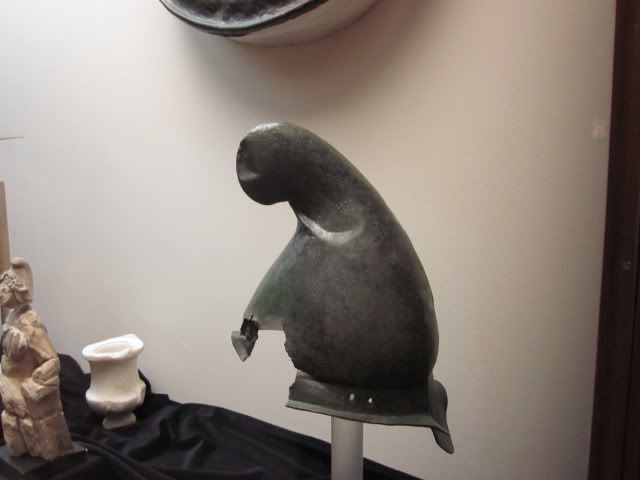
quote:Probably "blacks" with different hair color and texture.
Originally posted by the lioness,:
quote:when you say "blacks" do you mean black haired people?
Originally posted by Tukuler:
What fool believes all black people look alike?
Asiatic blacks do not 1:1 resemble African blacks.
Indeed, there's no 1:1 resemblance between various
African blacks themselves.
quote:We agree on a crossroad now.
Originally posted by the lioness,:
Hellenizing Art in Ancient Nubia 300 B.C. - AD 250 and Its Egyptian Models ...
By László Török, Laszlo Toro
Herodotus
Book 3 - THALIA
[3.97] Such then were the governments, and such the amounts of tribute at which they were assessed respectively. Persia alone has not been reckoned among the tributaries - and for this reason, because the country of the Persians is altogether exempt from tax. The following peoples paid no settled tribute, but brought gifts to the king: first, the Ethiopians bordering upon Egypt, who were reduced by Cambyses when he made war on the long-lived Ethiopians, and who dwell about the sacred city of Nysa, and have festivals in honour of Bacchus. The grain on which they and their next neighbours feed is the same as that used by the Calantian Indians. Their dwelling-houses are under ground. Every third year these two nations brought - and they still bring to my day - two choenices of virgin gold, two hundred logs of ebony, five Ethiopian boys, and twenty elephant tusks. The Colchians, and the neighbouring tribes who dwell between them and the Caucasus - for so far the Persian rule reaches, while north of the Caucasus no one fears them any longer - undertook to furnish a gift, which in my day was still brought every fifth year, consisting of a hundred boys, and the same number of maidens. The Arabs brought every year a thousand talents of frankincense. Such were the gifts which the king received over and above the tribute-money.

Three boys, one carrying possibly an elephant tusk,
an adult Persian(?) man at right. These are possibly Nubian boys, however there are not five of them and they are not being led by a Nubian
Archers formed the core of Nubian armies that vied with Egypt for control over parts of the Nile valley, conquered Egypt in the 8th century BC, and confronted the troops of the Assyrian empire. The skill of Nubian archers made them valued members in the military forces of other lands. Egyptian texts as early as 2400 BC note Nubians in Egyptian armies. Representations of Nubian warriors appear in Egyptian tomb models, reliefs, and paintings in all periods of ancient Egyptian history. Nubian archers also served as warriors in the imperial army of Persia in the first millennium BC.
_____________________________________________
Dictionary of African Biography, Volumes 1-6
edited by Emmanuel Kwaku Akyeampong,

quote:--Moorjani et al.
"A potential issue that could in theory influence our findings is that the exact population contributing to African ancestry in West Eurasians is unknown. To gain insight into the African source populations, we carried out PCA analyses, which suggested that the African ancestry in West Eurasians is at least as closely related to East Africans (e.g. Hapmap3 Luhya (LWK)) as to West Africans (e.g. Nigerian Yoruba (YRI)) (the same analyses show that there is no evidence of relatedness to Chadic populations like Bulala) (Text S5 and Figure S12).
We also used the 4 Population Test to assess whether the tree ((LWK, YRI),(West Eurasian, CEU)) is consistent with the data, and found no evidence for a violation,
which is consistent with a mixture of either West African or East African ancestors or both contributing to the African ancestry in West Eurasians (Table S14; Figure S13). Historically, a mixture of West and East African ancestry is plausible, since African gene flow into West Eurasia is documented from both West Africa during Roman times [34] and from East Africa during migrations from Egypt [7]. It is important to point out, however, that the difficulty of pinpointing the exact African source population is not expected to bias our inferences about the total proportion and date of mixture. The f4 Ancestry Estimation method is unbiased even when we use a poor surrogates for the true ancestral African population (as long as the phylogeny is correct), as we confirmed by repeating analyses replacing YRI with LWK, and obtaining similar results (Table S15).Our ROLLOFF admixture date estimates are also similar whether we use LWK or YRI to represent ancestral African population (Table S15), as predicted by the theory.
quote:--Moshe et al.
8 Cush had a son named Nimrod, who became the world's first great conqueror. 9 By the Lord's help he was a great hunter, and that is why people say, “May the Lord make you as great a hunter as Nimrod!” 10 At first his kingdom included Babylon, Erech, and Accad, all three of them in Babylonia. 11 From that land he went to Assyria and built the cities of Nineveh, Rehoboth Ir, Calah,
12 and Resen, which is between Nineveh and the great city of Calah.
quote:
Originally posted by the lioness,:
Herodotus
Book 3 - THALIA
[3.97] Such then were the governments, and such the amounts of tribute at which they were assessed respectively. Persia alone has not been reckoned among the tributaries - and for this reason, because the country of the Persians is altogether exempt from tax. The following peoples paid no settled tribute, but brought gifts to the king: first, the Ethiopians bordering upon Egypt, who were reduced by Cambyses when he made war on the long-lived Ethiopians, and who dwell about the sacred city of Nysa, and have festivals in honour of Bacchus. The grain on which they and their next neighbours feed is the same as that used by the Calantian Indians. Their dwelling-houses are under ground. Every third year these two nations brought - and they still bring to my day - two choenices of virgin gold, two hundred logs of ebony, five Ethiopian boys, and twenty elephant tusks. The Colchians, and the neighbouring tribes who dwell between them and the Caucasus - for so far the Persian rule reaches, while north of the Caucasus no one fears them any longer - undertook to furnish a gift, which in my day was still brought every fifth year, consisting of a hundred boys, and the same number of maidens. The Arabs brought every year a thousand talents of frankincense. Such were the gifts which the king received over and above the tribute-money.

Three boys, one carrying possibly an elephant tusk,
an adult Persian(?) man at right. These are possibly Nubian boys, however there are not five of them and they are not being led by a Nubian
quote:http://www.bbc.co.uk/worldservice/africa/features/storyofafrica/3chapter5.shtml
For many years now there has been a debate about whether the ancient peoples of the Nile Valley were 'black' or 'white'. Much Western scholarship, particularly in the early twentieth century, refused to accept that black peoples could have built such a great civilisation.
In 1930 for example, Charles Seligman (1873-1940), an English ethnologist who wrote a book titled 'The Races of Africa' said that the ancient civilisation of Egypt was created by a race he called 'Hamites', who he regarded as coming from Asia.
Some African historians, including the Professor of Anthropology at the University of Nairobi, Simiyu Wandibba, believe that European writers developed such theories to discredit Africa and make it easier for the continent to be colonised.
"In the nineteenth and early twentieth centuries there were theories that Africa was inhabited much later than Asia and that the people occupying Africa today were the result of waves of migration from western Asia, the Middle East and the Far East.
I want to say that this is not true. But if you want to rule a people, you don't want to give them credit."
Professor Simiyu Wandibba, University of Nairobi.
One of the main academic proponents of the view that the ancient Egyptian civilisation was founded by black Africans was the Senegalese historian Cheikh Anta Diop.
"Ancient Egypt was a Negro civilisation. The history of Black Africa will remain suspended in the air and cannot be written correctly until African historians dare to connect it with the history of Egypt. The African historian who evades the problem of Egypt is neither modest nor objective nor unruffled. He is ignorant, cowardly and neurotic. The ancient Egyptians were Negroes. The moral fruit of their civilisation is to be counted among the assets of the Black world."
Cheikh Anta Diop, taken from The African Origin of Civilisation.
In his two major works Nations Negres et Culture and Anteriorite des Civilizations Negres he profoundly influenced thinking about Africa around the world.
Cheikh Anta Diop argues that:
As humankind began in East Africa it was likely that people were black skinned.
People populated other continents by moving either through the Sahara or the Nile Valley.
In the period before the start of the great Egyptian dynasties the whole of the Nile river basin was taken over by these negroid peoples.
To support his theory, Diop cited the writings of several Greek and Latin writers who had described the ancient Egyptians.
The Greek historian Herodotus, for example, described the Colchians of the Black Sea shores as "Egyptians by race" and pointed out they had "black skins and kinky hair."
Apollodorus, the Greek philosopher, described Egypt as "the country of the black-footed ones" and the Latin historian Ammianus Marcellinus said "the men of Egypt are mostly brown or black with a skinny desiccated look."
Diop also argued that the Egyptians themselves described their race as black and that there were close affinities between the ancient Egyptian tongue and the languages of Africa.
The issue of the peopling of Egypt came to a head in 1974 when UNESCO hosted a conference in Cairo aimed at discussing the latest research.
The symposium provoked ferocious debate and many of Diop's theories were strongly challenged, however, the meeting concluded with the following statement, "the overall results…will be very differently assessed by the various participants."
The closing statement also pointed out that not all participants had prepared for the conference as painstakingly as Professor Diop or his academic ally Theophile Obenga of the Democratic Republic of Congo.
The argument still remains largely unresolved to the extent that UNESCO's General History of Africa is somewhat cautious in its final analysis of the issue.
"It is more than probable that the African strain, black or light, is preponderant in the Ancient Egyptian, but in the present state of our knowledge it is impossible to say more."
The issue was given more impetus with the publication in 1987 of Martin Bernal's Black Athena in which he argued that Classical civilisation had it roots deep in Afroasiatic cultures which had been systematically suppressed for mainly racist reasons.
quote:Dedicated to the lioness productions team.
Originally posted by the lioness,:
quote:I said African types
Originally posted by Trollkillah # Ish Gebor:
quote:Question..., did blacks ever make it to Assyria?
Originally posted by the lioness,:
quote:The Assyrians were African types?
Originally posted by Tukuler:
Well we see here some of Asia's blacks also have nappy hair.
"black" is a social construct term
It is therefore what it means is open to widely varied interpretation and is not, in recent thinking, considered a scientific term ("nappy" isn't either)
"African type" refers to a specific geographic location, Africa
Also, whether an African type person made it to some location 40-50,000 years ago is irrelevant to specific populations in Assyria or Lachish 2,700 years ago
Within that span of time people evolve adpatations to new climates, drift and isolation and admixture may also be at play
quote:--Moshe et al.
8 Cush had a son named Nimrod, who became the world's first great conqueror. 9 By the Lord's help he was a great hunter, and that is why people say, “May the Lord make you as great a hunter as Nimrod!” 10 At first his kingdom included Babylon, Erech, and Accad, all three of them in Babylonia. 11 From that land he went to Assyria and built the cities of Nineveh, Rehoboth Ir, Calah,
12 and Resen, which is between Nineveh and the great city of Calah.
quote:--Moorjani et al.
"A potential issue that could in theory influence our findings is that the exact population contributing to African ancestry in West Eurasians is unknown. To gain insight into the African source populations, we carried out PCA analyses, which suggested that the African ancestry in West Eurasians is at least as closely related to East Africans (e.g. Hapmap3 Luhya (LWK)) as to West Africans (e.g. Nigerian Yoruba (YRI)) (the same analyses show that there is no evidence of relatedness to Chadic populations like Bulala) (Text S5 and Figure S12).
We also used the 4 Population Test to assess whether the tree ((LWK, YRI),(West Eurasian, CEU)) is consistent with the data, and found no evidence for a violation,
which is consistent with a mixture of either West African or East African ancestors or both contributing to the African ancestry in West Eurasians (Table S14; Figure S13). Historically, a mixture of West and East African ancestry is plausible, since African gene flow into West Eurasia is documented from both West Africa during Roman times [34] and from East Africa during migrations from Egypt [7]. It is important to point out, however, that the difficulty of pinpointing the exact African source population is not expected to bias our inferences about the total proportion and date of mixture. The f4 Ancestry Estimation method is unbiased even when we use a poor surrogates for the true ancestral African population (as long as the phylogeny is correct), as we confirmed by repeating analyses replacing YRI with LWK, and obtaining similar results (Table S15).Our ROLLOFF admixture date estimates are also similar whether we use LWK or YRI to represent ancestral African population (Table S15), as predicted by the theory.
quote:-- (Ehret 1995; Ehret et al. 2004; Blench 2006).
"These results indicate that the ancestor of all Semitic languages in our dataset was being spoken in the Near East no earlier than approximately 7400 YBP, after having after having diverged from Afroasiatic in Africa"
(i) Semitic had an Early Bronze Age origin (approx. 5750 YBP) in the Levant, followed by an expansion of Akkadian into Mesopotamia;
(ii) Central and South Semitic diverged earlier than previously thought throughout the Levant during the Early to Middle Bronze Age transition; and
(iii) Ethiosemitic arose as the result of a single, possibly pre-Aksumite, introduction of a lineage from southern Arabia to the Horn of Africa approximately 2800 YBP.

quote:I don't think you'll ever receive an answer to that question.
Originally posted by zarahan- aka Enrique Cardova:
Good info lioness. What do you have on the Nubians
as to their renown in chariotry and horses?
quote:--Dominique Collon
Based on the unrivaled collections of the British Museum, this extensively illustrated book is a superb introduction to the art of the ancient Near East from the eighth millennium B.C. to Alexander the Great. Often described as the cradle of civilization, the ancient Near East was the birthplace of writing, monumental sculpture, and wheel-made pottery. Dominique Collon provides a unique view into this ancient world, from village settlements to grand palaces to burial sites.
Collon situates the Museum's most beautiful and interesting artifacts against their historical and cultural background. Among the works featured are painted pottery, figurines, cylinder seals, and stone amulets from the earliest village cultures before 3000 B.C. Also here are magnificent finds from graves at Alaca Huyuk in Turkey and the Royal Cemetery at Ur, including jewelry, musical instruments, and the famous Royal Standard. Sculpted reliefs from Assyrian palaces and Sasanian metalwork round out the collection. In her final chapter, Collon shows how art from the ancient Near East resonates in our own world today.
A welcome addition is a Mesopotamian chronology summarizing recent astronomical and textual data, compiled by C.B.F. Walker especially for this book. Based on the unrivaled collections of the British Museum, this extensively illustrated book is a superb introduction to the art of the ancient Near East from the eighth millennium B.C. to Alexander the Great. Often described as the cradle of civilization, the ancient Near East was the birthplace of writing, monumental sculpture, and wheel-made pottery. Dominique Collon provides a unique view into this ancient world, from village settlements to grand palaces to burial sites.
Collon situates the Museum's most beautiful and interesting artifacts against their historical and cultural background. Among the works featured are painted pottery, figurines, cylinder seals, and stone amulets from the earliest village cultures before 3000 B.C. Also here are magnificent finds from graves at Alaca Huyuk in Turkey and the Royal Cemetery at Ur, including jewelry, musical instruments, and the famous Royal Standard. Sculpted reliefs from Assyrian palaces and Sasanian metalwork round out the collection. In her final chapter, Collon shows how art from the ancient Near East resonates in our own world today.
A welcome addition is a Mesopotamian chronology summarizing recent astronomical and textual data, compiled by C.B.F. Walker especially for this book.
quote:height relative to other figures on the relief
Originally posted by Trollkillah # Ish Gebor:
So, on what do you base that these three "Nubian" figures were "boys"?
quote:Well then there you have it, they would be Pygmies.
Originally posted by the lioness,:
quote:height relative to other figures on the relief
Originally posted by Trollkillah # Ish Gebor:
So, on what do you base that these three "Nubian" figures were "boys"?
If not boys they would be pygmies
quote:Oh what a disgusting twister of truth you are.
Originally posted by the lioness,:
^^^ Mike prefers no African interactions outside of Africa
and he tries to hide it by blaming "albinos"
that is his ideology. that Africans didn't do shyt outside of Africa
All people who look like Africans outside of Africa are not any more African than Tom Cruise
It is his ashamed of being African illness
"black", the English word for Negro is a social construct term
It is therefore what it means is open to widely varied interpretation
and is not, in recent thinking, a scientific term or useful to anthropology
"dark skin" is somehwat relative but it is free from the connotions and inaccurate term "black"
This is 2014, people are identified by genes rather than by skin color
A dark skinned person in Peru, Papua New Guinea or Angola might all have dark skin but nothing else in common.
Calling them "black" and other people "white" is as random as classifying people by hair, eye color or height
and is simplistic and imprecise even when attempting to describe traits
In America black is a convenient social term mention someone of recent African descent, of the past several hundred years.
I use it in this way
quote:Yeah I am figuring that about lioness still.
Originally posted by Mike111:
quote:Oh what a disgusting twister of truth you are.
Originally posted by the lioness,:
^^^ Mike prefers no African interactions outside of Africa
and he tries to hide it by blaming "albinos"
that is his ideology. that Africans didn't do shyt outside of Africa
All people who look like Africans outside of Africa are not any more African than Tom Cruise
It is his ashamed of being African illness
"black", the English word for Negro is a social construct term
It is therefore what it means is open to widely varied interpretation
and is not, in recent thinking, a scientific term or useful to anthropology
"dark skin" is somehwat relative but it is free from the connotions and inaccurate term "black"
This is 2014, people are identified by genes rather than by skin color
A dark skinned person in Peru, Papua New Guinea or Angola might all have dark skin but nothing else in common.
Calling them "black" and other people "white" is as random as classifying people by hair, eye color or height
and is simplistic and imprecise even when attempting to describe traits
In America black is a convenient social term mention someone of recent African descent, of the past several hundred years.
I use it in this way
If the Russian in Siberia is White, and the Settler half way around the world in Chile is White, then why would Blacks in closer proximity not be Blacks?
The fact is that your only purpose here is to further confuse ignorant Blacks.
quote:Mike, we aren't confused or ignorant. We are merely toying around with lioness team members.
Originally posted by Mike111:
quote:Oh what a disgusting twister of truth you are.
Originally posted by the lioness,:
^^^ Mike prefers no African interactions outside of Africa
and he tries to hide it by blaming "albinos"
that is his ideology. that Africans didn't do shyt outside of Africa
All people who look like Africans outside of Africa are not any more African than Tom Cruise
It is his ashamed of being African illness
"black", the English word for Negro is a social construct term
It is therefore what it means is open to widely varied interpretation
and is not, in recent thinking, a scientific term or useful to anthropology
"dark skin" is somehwat relative but it is free from the connotions and inaccurate term "black"
This is 2014, people are identified by genes rather than by skin color
A dark skinned person in Peru, Papua New Guinea or Angola might all have dark skin but nothing else in common.
Calling them "black" and other people "white" is as random as classifying people by hair, eye color or height
and is simplistic and imprecise even when attempting to describe traits
In America black is a convenient social term mention someone of recent African descent, of the past several hundred years.
I use it in this way
If the Russian in Siberia is White, and the Settler half way around the world in Chile is White, then why would Blacks in closer proximity not be Blacks?
The fact is that your only purpose here is to further confuse ignorant Blacks.
quote:That's a funny claim since you yourself claimed that Africans never moved out of Africa (during recent time), only 40 thousand years ago. Yet, Africa had multiple "back migrations, and they all were "Caucasians", all throughout the course of history.
Originally posted by the lioness,:
^^^ Mike prefers no African interactions outside of Africa
and he tries to hide it by blaming "albinos"
that is his ideology. that Africans didn't do shyt outside of Africa
All people who look like Africans outside of Africa are not any more African than Tom Cruise
It is his ashamed of being African illness
"black", the English word for Negro is a social construct term
It is therefore what it means is open to widely varied interpretation
and is not, in recent thinking, a scientific term or useful to anthropology
"dark skin" is somehwat relative but it is free from the connotions and inaccurate term "black"
This is 2014, people are identified by genes rather than by skin color
A dark skinned person in Peru, Papua New Guinea or Angola might all have dark skin but nothing else in common.
Calling them "black" and other people "white" is as random as classifying people by hair, eye color or height
and is simplistic and imprecise even when attempting to describe traits
In America black is a convenient social term mentiong someone of recent African descent, of the past several hundred years.
I use it in this way
 zoom
zoom  zoom
zoomquote:that's a lie,
Originally posted by Trollkillah # Ish Gebor:
That's a funny claim since you yourself claimed that Africans never moved out of Africa (during recent time),
quote:that's a lie,
Originally posted by Trollkillah # Ish Gebor:
you've just said that black is variate. And is found all over the globe. Meaning black is not solely within Africa diverse, but even more so outside of Africa.






quote:Lying distorting snake.
Originally posted by the lioness,:
Looking at this it becomes even more remarkable that someone would think these people look more African than Near Eastern.
quote:"Asiatic black" is a meaningless race term
Originally posted by Tukuler:
Lying distorting snake.
I explicitly remarked on Asiatic blacks not African blacks.




quote:
Originally posted by the lioness,:
quote:"Asiatic black" is a meaningless race term
Originally posted by Tukuler:
Lying distorting snake.
I explicitly remarked on Asiatic blacks not African blacks.
It's pure rhetoric
as if "black" means "a person with curly hair"
quote:The term "Asia's blacks" is meaningless
Originally posted by Tukuler:
Tell it too all the Greco-Latin writers who
left us documentation on Asia's blacks from
the eastern Meditterannean to the Indian Ocean.



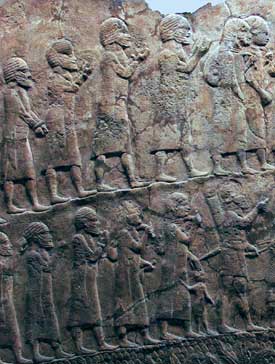
 zoom
zoom
quote:On closer inspection they are not near exactly the same
Originally posted by Tukuler:
[QB] What I never did before was scrutinize
the first panel detailing the Assyrian
armed forces which include mercenaries.
The men wearing head gear that accompany
captive Lachish women and children may
be an Assyrian detachment. Their headgear
are near exactly same as Assyrian archers on

![[Big Grin]](biggrin.gif)
![[Big Grin]](biggrin.gif)
![[Big Grin]](biggrin.gif)

 zoom
zoom

quote:
Originally posted by the lioness,:
.
https://en.wikipedia.org/wiki/Black_Obelisk_of_Shalmaneser_III
Black Obelisk of Shalmaneser III
It is the most complete Assyrian obelisk yet discovered, and is historically significant because it is thought to display the earliest ancient depiction of a biblical figure - Hoshea King of Israel. The traditional identification of "Yaw" as Jehu has been questioned by some scholars, who proposed that the inscription refers to another king, Jehoram of Israel. Its reference to 'Parsua' is also the first known reference to the Persians.
________________________________________________________
Black Obelisk of Shalmaneser III"



Depiction of Hoshea King of Israel giving tribute to King Shalmaneser III of Assyria (2 Kings 17:3), on the Black Obelisk of Shalmaneser III from Nimrud (circa 827 BC) in the British Museum (London).
https://www.britishmuseum.org/explore/highlights/highlight_objects/me/t/black_obelisk_of_shalmaneser.aspx
The Black Obelisk of Shalmaneser III
Neo-Assyrian, 858-824 BC
From Nimrud (ancient Kalhu), northern Iraq
The military achievements of an Assyrian king
The archaeologist Henry Layard discovered this black limestone obelisk in 1846 during his excavations of the site of Kalhu, the ancient Assyrian capital. It was erected as a public monument in 825 BC at a time of civil war. The relief sculptures glorify the achievements of King Shalmaneser III (reigned 858-824 BC) and his chief minister. It lists their military campaigns of thirty-one years and the tribute they exacted from their neighbours: including camels, monkeys, an elephant and a rhinoceros. Assyrian kings often collected exotic animals and plants as an expression of their power.
There are five scenes of tribute, each of which occupies four panels round the face of the obelisk and is identified by a line of cuneiform script above the panel. From top to bottom they are:
Sua of Gilzanu (in north-west Iran)
Jehu of Bit Omri (ancient northern Israel)
An unnamed ruler of Musri (probably Egypt)
Marduk-apil-usur of Suhi (middle Euphrates, Syria and Iraq)
Qalparunda of Patin (Antakya region of Turkey)
The second register from the top includes the earliest surviving picture of an Israelite: the Biblical Jehu, king of Israel, brought or sent his tribute in around 841 BC. Ahab, son of Omri, king of Israel, had lost his life in battle a few years previously, fighting against the king of Damascus at Ramoth-Gilead (I Kings xxii. 29-36). His second son (Joram) was succeeded by Jehu, a usurper, who broke the alliances with Phoenicia and Judah, and submitted to Assyria. The caption above the scene, written in Assyrian cuneiform, can be translated
The tribute of Jehu, son of Omri: I received from him silver, gold, a golden bowl, a golden vase with pointed bottom, golden tumblers, golden buckets, tin, a staff for a king [and] spears.
J.E. Reade, Assyrian sculpture-1 (London, The British Museum Press, 1998)
T.C. Mitchell, The Bible in the British Museu (London, The British Museum Press, 1988)
D. Luckenbill, Ancient records of Assyria and (, 1927 (reprinted 1989))
________________________________
 zoom
zoom
quote:
Originally posted by the lioness,:
quote:that's a lie,
Originally posted by Trollkillah # Ish Gebor:
That's a funny claim since you yourself claimed that Africans never moved out of Africa (during recent time),
quote me saying that
quote:that's a lie,
Originally posted by Trollkillah # Ish Gebor:
you've just said that black is variate. And is found all over the globe. Meaning black is not solely within Africa diverse, but even more so outside of Africa.
quote me saying that
![[Roll Eyes]](rolleyes.gif)
quote:
Originally posted by the lioness,:
quote:I said African types
Originally posted by Trollkillah # Ish Gebor:
quote:Question..., did blacks ever make it to Assyria?
Originally posted by the lioness,:
quote:The Assyrians were African types?
Originally posted by Tukuler:
Well we see here some of Asia's blacks also have nappy hair.
"black" is a social construct term
It is therefore what it means is open to widely varied interpretation and is not, in recent thinking, considered a scientific term ("nappy" isn't either)
"African type" refers to a specific geographic location, Africa
Also, whether an African type person made it to some location 40-50,000 years ago is irrelevant to specific populations in Assyria or Lachish 2,700 years ago
Within that span of time people evolve adpatations to new climates, drift and isolation and admixture may also be at play
![[Roll Eyes]](rolleyes.gif)
quote:--Moshe et al.
8 Cush had a son named Nimrod, who became the world's first great conqueror. 9 By the Lord's help he was a great hunter, and that is why people say, “May the Lord make you as great a hunter as Nimrod!” 10 At first his kingdom included Babylon, Erech, and Accad, all three of them in Babylonia. 11 From that land he went to Assyria and built the cities of Nineveh, Rehoboth Ir, Calah,
12 and Resen, which is between Nineveh and the great city of Calah.
quote:--Moorjani et al.
"A potential issue that could in theory influence our findings is that the exact population contributing to African ancestry in West Eurasians is unknown. To gain insight into the African source populations, we carried out PCA analyses, which suggested that the African ancestry in West Eurasians is at least as closely related to East Africans (e.g. Hapmap3 Luhya (LWK)) as to West Africans (e.g. Nigerian Yoruba (YRI)) (the same analyses show that there is no evidence of relatedness to Chadic populations like Bulala) (Text S5 and Figure S12).
We also used the 4 Population Test to assess whether the tree ((LWK, YRI),(West Eurasian, CEU)) is consistent with the data, and found no evidence for a violation,
which is consistent with a mixture of either West African or East African ancestors or both contributing to the African ancestry in West Eurasians (Table S14; Figure S13). Historically, a mixture of West and East African ancestry is plausible, since African gene flow into West Eurasia is documented from both West Africa during Roman times [34] and from East Africa during migrations from Egypt [7]. It is important to point out, however, that the difficulty of pinpointing the exact African source population is not expected to bias our inferences about the total proportion and date of mixture. The f4 Ancestry Estimation method is unbiased even when we use a poor surrogates for the true ancestral African population (as long as the phylogeny is correct), as we confirmed by repeating analyses replacing YRI with LWK, and obtaining similar results (Table S15).Our ROLLOFF admixture date estimates are also similar whether we use LWK or YRI to represent ancestral African population (Table S15), as predicted by the theory.
quote:-- (Ehret 1995; Ehret et al. 2004; Blench 2006).
"These results indicate that the ancestor of all Semitic languages in our dataset was being spoken in the Near East no earlier than approximately 7400 YBP, after having after having diverged from Afroasiatic in Africa"
(i) Semitic had an Early Bronze Age origin (approx. 5750 YBP) in the Levant, followed by an expansion of Akkadian into Mesopotamia;
(ii) Central and South Semitic diverged earlier than previously thought throughout the Levant during the Early to Middle Bronze Age transition; and
(iii) Ethiosemitic arose as the result of a single, possibly pre-Aksumite, introduction of a lineage from southern Arabia to the Horn of Africa approximately 2800 YBP.

![[Roll Eyes]](rolleyes.gif)

quote:interesting, this was probably accompanied by gene flow in both directions,
Originally posted by Trollkillah # Ish Gebor:
quote:-- (Ehret 1995; Ehret et al. 2004; Blench 2006).
(iii) Ethiosemitic arose as the result of a single, possibly pre-Aksumite, introduction of a lineage from southern Arabia to the Horn of Africa approximately 2800 YBP.

quote:
Originally posted by the lioness,:
.
Trollkillah, will you tell this Tukular character to stop continuing to switch the thread topic
There is no need for this
This is obviously a straight haired black >>>



quote:You couldn't manage to stay on topic. Anyway...
Originally posted by the lioness,:
quote:interesting, this was probably accompanied by gene flow in both directions,
Originally posted by Trollkillah # Ish Gebor:
quote:-- (Ehret 1995; Ehret et al. 2004; Blench 2006).
(iii) Ethiosemitic arose as the result of a single, possibly pre-Aksumite, introduction of a lineage from southern Arabia to the Horn of Africa approximately 2800 YBP.



quote:--Bayazit Yunusbayev, Oleg Balanovsky et al.
Bedouins, Jordanians, Palestinians and Saudi Arabians are located in close proximity to each other, which is consistent with a common origin in the Arabian Peninsula25, whereas the Egyptian, Moroccan, Mozabite Berber, and Yemenite samples are located closer to sub- Saharan populations (Fig. 1a and Supplementary Fig. 2a).
[...]

quote:--Julian Baldick
It is argued that just as there is a common Afroasiatic language family, so too there is a common Afroasiatic family of religions. There is an inner logic to be found in myths, folk-tales, rituals, customs and beliefs as far apart as Yemen and Nigeria which go back to an ancient past shared by the Bible and the pharaohs.
Using the method of comparative mythology, the author sifts through the work of scholars - including anthropologists, religious historians, archaeologists and classical Greek writers and contemporary comments on them by professional Egyptologists - to build his picture of the Afroasiatic heritage, and how much of it is still with us in modern Western thought.
quote:If the topic was Black Obelisk of Shalmaneser III
Originally posted by Tukuler:
Like you don't infiltrate threads with totally
off topic posts. My posts here are very on topic.

quote:Yep, nappy Afro hair is common in Europe too, right?
Originally posted by the lioness,:
quote:If the topic was Black Obelisk of Shalmaneser III
Originally posted by Tukuler:
Like you don't infiltrate threads with totally
off topic posts. My posts here are very on topic.
then, not all but most of your posts were off topic
anyway It's called the Black Obelisk
therefore it's pro black,
no need to worry about the straight hair.
Trollkillah has taught me that such hair is indigenous to Africa
quote:--American Anthropological Association
Physical variations in any given trait tend to occur gradually rather than abruptly over geographic areas. And because physical traits are inherited independently of one another, knowing the range of one trait does not predict the presence of others. For example, skin color varies largely from light in the temperate areas in the north to dark in the tropical areas in the south; its intensity is not related to nose shape or hair texture. Dark skin may be associated with frizzy or kinky hair or curly or wavy or straight hair, all of which are found among different indigenous peoples in tropical regions. These facts render any attempt to establish lines of division among biological populations both arbitrary and subjective.
quote:Lioness chant:
Originally posted by the lioness,:
Looking at this it becomes even more remarkable that someone would think these people look more African than Near Eastern.
And they may not even be native Judeans
^^^^ these are other figures, Lachish familes being deported by the Assyrians, but you don't see them on Egyptsearch. There's a reason for that. Many African Americans prefer to be Hebrew rather than West African. It's one of our ongoing shame based recongigurations, example, people descendants of places like Ghana or Benin calling themsleves "The Asiatic Black Man"
What one notices is that these deported familes don't have the dotted hair and are dressed differently from the dotted hair types. They appear to be a different ethnicity
So are all the above people even Judeans ?
One might say it could be either type or both, yet one group is shown with families and unless I've overlooked something the curly haired figures aren't.
Some scholars have suggested that they might be foreign fighters who were helping to protect the city

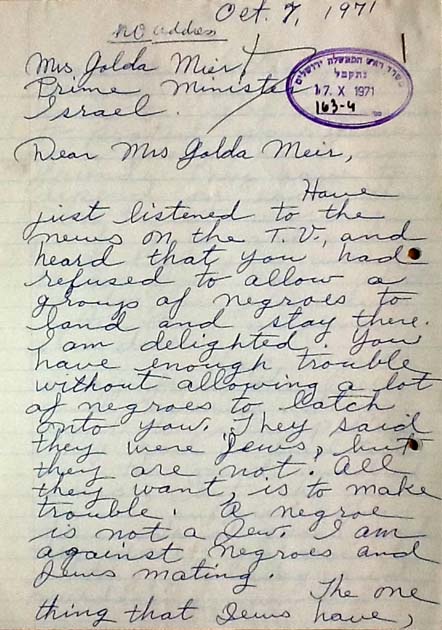
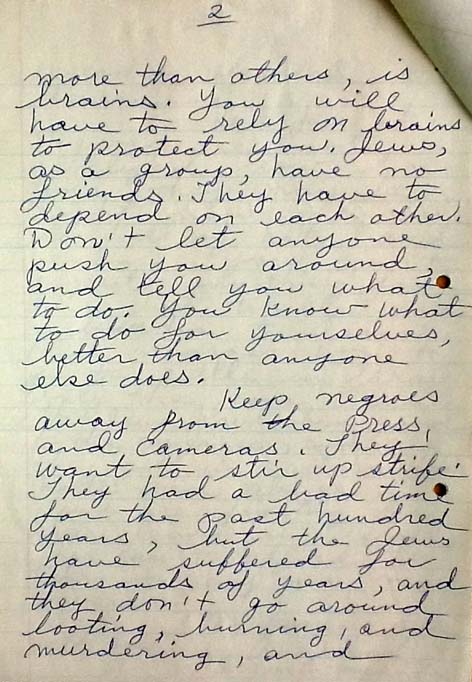


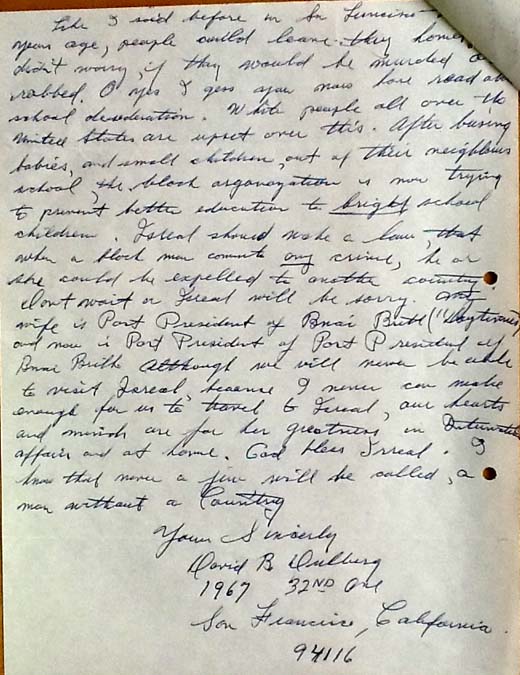

quote:Nice, these are all the scenes attached.
Originally posted by Tukuler:
Running scared?
More more more Lachish
To the fullest!!
Lachish: oldest authentic primary documentation of Israelites (Judah is a subset of Israel)
zoom

quote:◄ 2 Chronicles 32:9 ►
Later, when Sennacherib king of Assyria and all his forces were laying siege to Lachish, he sent his officers to Jerusalem with this message for Hezekiah king of Judah and for all the people of Judah who were there:
quote:Tukuler said nearly the same.
Originally posted by the lioness,:
quote:On closer inspection they are not near exactly the same
Originally posted by Tukuler:
[QB] What I never did before was scrutinize
the first panel detailing the Assyrian
armed forces which include mercenaries.
The men wearing head gear that accompany
captive Lachish women and children may
be an Assyrian detachment. Their headgear
are near exactly same as Assyrian archers on


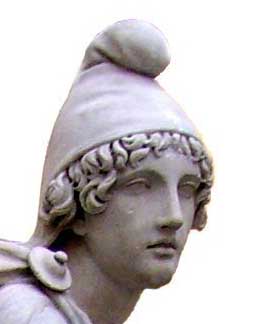


quote:http://www.jewishvirtuallibrary.org/jsource/judaica/ejud_0002_0016_0_15734.html
Originally posted by the lioness,:
PHRYGIA, district in central Asia Minor, part of the Roman province of Asia after the death of Attalus III (133 B.C.E.), the last king of *Pergamum. A Jewish community was established in Phrygia no later than the end of the third century B.C.E. According to Josephus, Antiochus III (the Great) transported 2,000 Jewish families from Mesopotamia and Babylonia to "the fortresses and most important places" of Phrygia and Lydia. These Jews were to serve as military settlers in support of the Seleucid monarchy, as the inhabitants of Phrygia had risen in revolt (cf. II Macc. 8:20: Babylonian Jews in the service of the Seleucid army against the Galatians). Favorable terms were granted the Jewish settlers. They were permitted to live in accordance with their own laws, and each was allotted land on which to build and cultivate. Generous exemptions from taxes were also granted, and Josephus thus considers the episode ample testimony to the friendship of Antiochus toward the Jews. The Jews of Phrygia undoubtedly had strong ties with Jerusalem and the Temple. On two occasions large sums of money which had been gathered in two cities of Phrygia, Apamea, and Laodicea, to be sent to the Temple were confiscated in 62–61 B.C.E. by the Roman governor Flaccus on the charge of illegal export of gold (Cicero, Pro Flacco, 28:68). A number of Jews from Phrygia resided in Jerusalem during the first century C.E. (Acts 2: 10). Several important Jewish inscriptions in Greek have been discovered in Phrygia, mostly from graves. One, dated 248–49 C.E. warns that if anyone should desecrate the tomb, "may the curses written in Deuteronomy [cf. ch. 27–29] be upon him." Nearly all the personal names are Greek, but the epithet "Joudaeos" is used several times and a menorah is carved on one stone. A tomb from Hierapolis, of the second or third century, states that the fee for any future additional internment is a donation to the Jewish community in Jerusalem.
BIBLIOGRAPHY:
Schuerer, Gesch, 3 (19094), 6, 12, 17; V. Tcherikover, Hellenistic Civilization and the Jews (1959), 287f., 501; Schalit, in: JQR, 50 (1959/60), 289–318; Frey, Corpus, 2 (1952), 24–38.

Mithra in a Phrygian cap 2nd cent. ad/c Rome, Italy
(British Museum, London)
Marble bust of Attis wearing Phrygian cap 2nd cent. ad/ce
(Paris)
_____________________________________________
Stones Crying Out and Rock-Witness to the Naratives of the Bible Concerning ...
By Ellen Ranyard
quote:-- Antony Kamm (page 89)
"Maybe jehu himself".
[...]
"Phrygian cap, often worn in north Syria and Asia Minor"
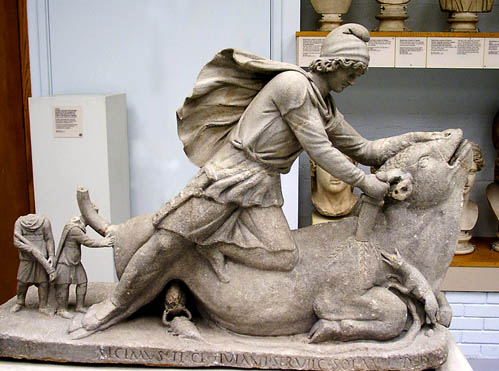
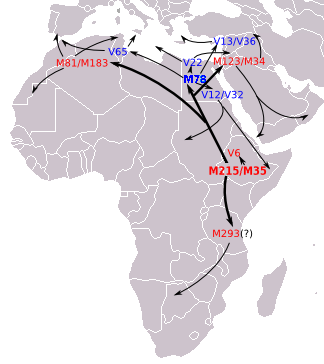
quote:It's pure reality. And deals very much with the subject being discussed here.
Originally posted by the lioness,:
Trollkillah why have you posted racist letters to Golda Meir in this thread?
Why have you attached my name to them ? " Lioness chant:"
that's pure trolling and a very weak minded attempt to instigate an emotional reaction and derail the thread









![[Big Grin]](biggrin.gif)

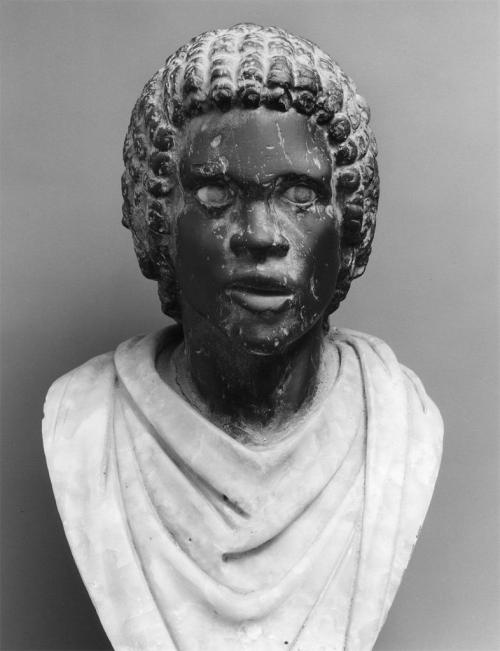
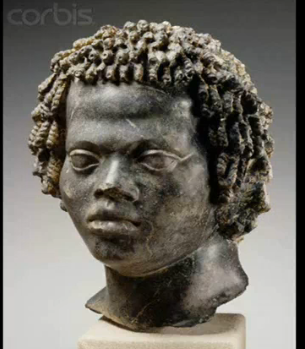

quote:http://images.metmuseum.org/CRDImages/gr/web-large/DP119653.jpg
This vase combines the distinctive neck of the so-called Shape VII oinochoe with a naturalistic head of a young black African boy. His curls and the central rosette were made separately. Vases in figural form were popular items in several Mediterranean cultures. The Etruscans produced both terracotta and metal versions.
![[Big Grin]](biggrin.gif)
quote:^^^^ this shows you don't know what you are talking about
Originally posted by Trollkillah # Ish Gebor:
] For the dumb ass above, the Assyrian art was from thousands of years ago, Muhammad Ali is from when? Time and culture are mandated for cultural expressions. Back then that was how they portrayed Afro texture hair![[Big Grin]](biggrin.gif)
All you are good for is ignoring and denying black peoples history.
Plus not all Afro hair has the same texture.


quote:Dimwit the beard doesn't match, dimwit your theory straight hair is caucasoid, it's dumb. Dimwit posting pictures of random folks to prove a point, is dumb. Dimwit, the lengths you go on a daily basis to erase black peoples history is hilarious. Next time, tell us again about your "race theories" and straight hair. LOL
Originally posted by the lioness,:
quote:^^^^ this shows you don't know what you are talking about
Originally posted by Trollkillah # Ish Gebor:
] For the dumb ass above, the Assyrian art was from thousands of years ago, Muhammad Ali is from when? Time and culture are mandated for cultural expressions. Back then that was how they portrayed Afro texture hair![[Big Grin]](biggrin.gif)
All you are good for is ignoring and denying black peoples history.
Plus not all Afro hair has the same texture.
You say not all Afro hair has the same texture and then below it you have a chart showing curly hair, that's dumb
Multi millions of people of many different ethnities and complexions have curly hair

you theory is all curly haired people are Africans, it's dumb

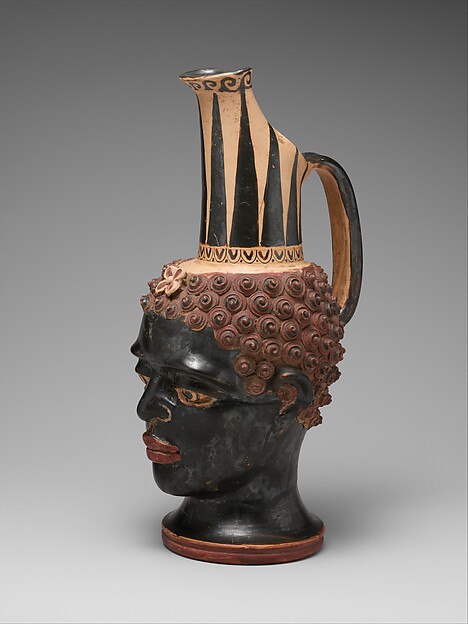
quote:http://www.metmuseum.org/collection/the-collection-online/search/246978
This vase combines the distinctive neck of the so-called Shape VII oinochoe with a naturalistic head of a young black African boy. His curls and the central rosette were made separately. Vases in figural form were popular items in several Mediterranean cultures. The Etruscans produced both terracotta and metal versions.
quote:--Moshe et al.
8 Cush had a son named Nimrod, who became the world's first great conqueror. 9 By the Lord's help he was a great hunter, and that is why people say, “May the Lord make you as great a hunter as Nimrod!” 10 At first his kingdom included Babylon, Erech, and Accad, all three of them in Babylonia. 11 From that land he went to Assyria and built the cities of Nineveh, Rehoboth Ir, Calah,
12 and Resen, which is between Nineveh and the great city of Calah.
quote:--Moorjani et al.
"A potential issue that could in theory influence our findings is that the exact population contributing to African ancestry in West Eurasians is unknown. To gain insight into the African source populations, we carried out PCA analyses, which suggested that the African ancestry in West Eurasians is at least as closely related to East Africans (e.g. Hapmap3 Luhya (LWK)) as to West Africans (e.g. Nigerian Yoruba (YRI)) (the same analyses show that there is no evidence of relatedness to Chadic populations like Bulala) (Text S5 and Figure S12).
We also used the 4 Population Test to assess whether the tree ((LWK, YRI),(West Eurasian, CEU)) is consistent with the data, and found no evidence for a violation,
which is consistent with a mixture of either West African or East African ancestors or both contributing to the African ancestry in West Eurasians (Table S14; Figure S13). Historically, a mixture of West and East African ancestry is plausible, since African gene flow into West Eurasia is documented from both West Africa during Roman times [34] and from East Africa during migrations from Egypt [7]. It is important to point out, however, that the difficulty of pinpointing the exact African source population is not expected to bias our inferences about the total proportion and date of mixture. The f4 Ancestry Estimation method is unbiased even when we use a poor surrogates for the true ancestral African population (as long as the phylogeny is correct), as we confirmed by repeating analyses replacing YRI with LWK, and obtaining similar results (Table S15).Our ROLLOFF admixture date estimates are also similar whether we use LWK or YRI to represent ancestral African population (Table S15), as predicted by the theory.
quote:-- (Ehret 1995; Ehret et al. 2004; Blench 2006).
"These results indicate that the ancestor of all Semitic languages in our dataset was being spoken in the Near East no earlier than approximately 7400 YBP, after having after having diverged from Afroasiatic in Africa"
(i) Semitic had an Early Bronze Age origin (approx. 5750 YBP) in the Levant, followed by an expansion of Akkadian into Mesopotamia;
(ii) Central and South Semitic diverged earlier than previously thought throughout the Levant during the Early to Middle Bronze Age transition; and
(iii) Ethiosemitic arose as the result of a single, possibly pre-Aksumite, introduction of a lineage from southern Arabia to the Horn of Africa approximately 2800 YBP.


quote:It's ironic because the woolly haired husbands their hands are tied together. Those other male's hands are not.
Originally posted by the lioness,:
[QUOTE]Originally posted by Tukuler:
[QB] More Lachish Jewish women with their woolly haired husbands.
zoom
Note some men's garments resemble -alamu (sp).
On closer inspection,
.

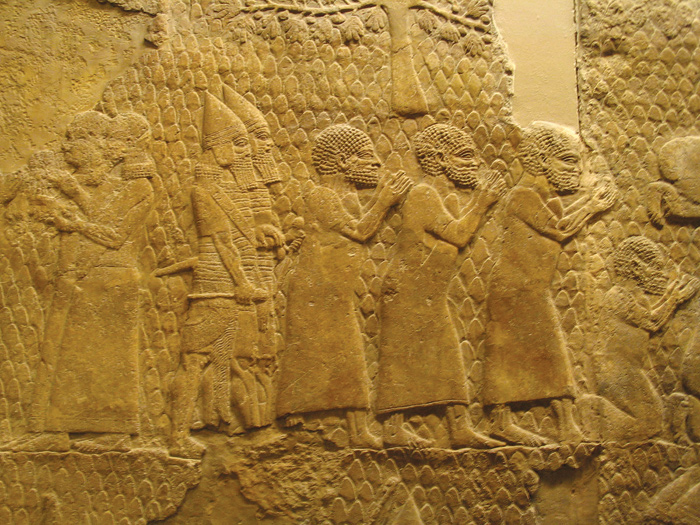

quote:
Originally posted by sero:
In most cultures prisoners and slaves got their hair cropped as a form of humiliation upon their broken manhood/power. The Bible symbolically and literally talks about this form of humiliation performed by the Assyrians.
Isaiah 7:20
In that day the Lord will use a razor hired from beyond the Euphrates River the king of Assyria to shave your heads and private parts, and to cut off your beards also.



quote:
Ivory plaque of lioness mauling an African: the lioness is standing over her victim who has his knees drawn up and is lying back supported by his hands on the ground behind him. The lioness is biting his throat. The African wears a short kilt represented by gold leaf. The tight curls of hair are represented by gilt-topped ivory pegs. In the background are lotus and papyrus flowers, covered in gold leaf and inlaid with lapis lazuli and cornelian. There is also a spot of lapis lazuli inlay on the forehead of the lioness. On top of the plaque are two square mortice holes and an incised letter 'aleph' in West Semitic script, while on the base are two rectangular holes and another incised 'aleph'. This plaque was probably part of a piece of furniture.

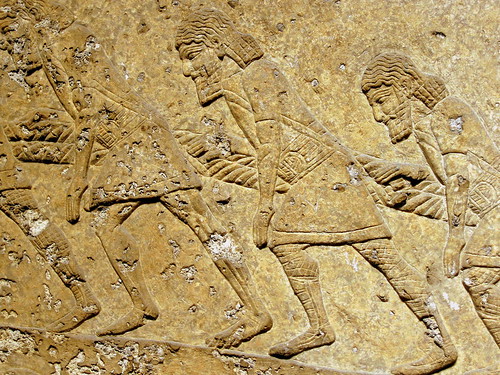
quote:Thanks but there are 13 individual slabs from
Originally posted by Trollkillah # Ish Gebor:
Nice, these are all the scenes attached.

 zoom
zoom
quote:Dimwit the beard doesn't match, dimwit your theory straight hair is caucasoid, it's dumb. Dimwit posting pictures of random folks to prove a point, is dumb. Dimwit, the lengths you go on a daily basis to erase black peoples history is hilarious. Next time, tell us again about your "race theories" and straight hair. LOL
Originally posted by the lioness,:
quote:^^^^ this shows you don't know what you are talking about
Originally posted by Trollkillah # Ish Gebor:
] For the dumb ass above, the Assyrian art was from thousands of years ago, Muhammad Ali is from when? Time and culture are mandated for cultural expressions. Back then that was how they portrayed Afro texture hair![[Big Grin]](biggrin.gif)
All you are good for is ignoring and denying black peoples history.
Plus not all Afro hair has the same texture.
You say not all Afro hair has the same texture and then below it you have a chart showing curly hair, that's dumb
Multi millions of people of many different ethnities and complexions have curly hair

you theory is all curly haired people are Africans, it's dumb


quote:http://www.metmuseum.org/collection/the-collection-online/search/246978
This vase combines the distinctive neck of the so-called Shape VII oinochoe with a naturalistic head of a young black African boy. His curls and the central rosette were made separately. Vases in figural form were popular items in several Mediterranean cultures. The Etruscans produced both terracotta and metal versions.
quote:so according to you both these people have nappy hair, aka afros
Originally posted by Trollkillah # Ish Gebor:


quote:LOL...hot fake Muurish curls...
quote:Dimwit the beard doesn't match, dimwit your theory straight hair is caucasoid, it's dumb. Dimwit posting pictures of random folks to prove a point, is dumb. Dimwit, the lengths you go on a daily basis to erase black peoples history is hilarious. Next time, tell us again about your "race theories" and straight hair. LOL
Originally posted by the lioness,:
quote:
Originally posted by Trollkillah # Ish Gebor:.................
......
.

And I did not make that scheme. Go figure!
........
You've f*ckedup again!
![[Big Grin]](biggrin.gif)
![[Big Grin]](biggrin.gif)
quote:LOL at your "rebuttal". All you have is excessive excuses.
Originally posted by the lioness,:
quote:so according to you both these people have nappy hair, aka afros
Originally posted by Trollkillah # Ish Gebor:


and are therefore "black"
quote:
Originally posted by the lioness,:
I said African types
"black" is a social construct term
It is therefore what it means is open to widely varied interpretation and is not, in recent thinking, considered a scientific term ("nappy" isn't either)
"African type" refers to a specific geographic location, Africa
Also, whether an African type person made it to some location 40-50,000 years ago is irrelevant to specific populations in Assyria or Lachish 2,700 years ago
Within that span of time people evolve adpatations to new climates, drift and isolation and admixture may also be at play
quote:http://www.metmuseum.org/collection/the-collection-online/search/246978
quote:
This vase combines the distinctive neck of the so-called Shape VII oinochoe with a naturalistic head of a young black African boy. His curls and the central rosette were made separately. Vases in figural form were popular items in several Mediterranean cultures. The Etruscans produced both terracotta and metal versions.
quote:--Moshe et al.
8 Cush had a son named Nimrod, who became the world's first great conqueror. 9 By the Lord's help he was a great hunter, and that is why people say, “May the Lord make you as great a hunter as Nimrod!” 10 At first his kingdom included Babylon, Erech, and Accad, all three of them in Babylonia. 11 From that land he went to Assyria and built the cities of Nineveh, Rehoboth Ir, Calah,
12 and Resen, which is between Nineveh and the great city of Calah.
quote:--Moorjani et al.
"A potential issue that could in theory influence our findings is that the exact population contributing to African ancestry in West Eurasians is unknown. To gain insight into the African source populations, we carried out PCA analyses, which suggested that the African ancestry in West Eurasians is at least as closely related to East Africans (e.g. Hapmap3 Luhya (LWK)) as to West Africans (e.g. Nigerian Yoruba (YRI)) (the same analyses show that there is no evidence of relatedness to Chadic populations like Bulala) (Text S5 and Figure S12).
We also used the 4 Population Test to assess whether the tree ((LWK, YRI),(West Eurasian, CEU)) is consistent with the data, and found no evidence for a violation,
which is consistent with a mixture of either West African or East African ancestors or both contributing to the African ancestry in West Eurasians (Table S14; Figure S13). Historically, a mixture of West and East African ancestry is plausible, since African gene flow into West Eurasia is documented from both West Africa during Roman times [34] and from East Africa during migrations from Egypt [7]. It is important to point out, however, that the difficulty of pinpointing the exact African source population is not expected to bias our inferences about the total proportion and date of mixture. The f4 Ancestry Estimation method is unbiased even when we use a poor surrogates for the true ancestral African population (as long as the phylogeny is correct), as we confirmed by repeating analyses replacing YRI with LWK, and obtaining similar results (Table S15).Our ROLLOFF admixture date estimates are also similar whether we use LWK or YRI to represent ancestral African population (Table S15), as predicted by the theory.
quote:-- (Ehret 1995; Ehret et al. 2004; Blench 2006).
"These results indicate that the ancestor of all Semitic languages in our dataset was being spoken in the Near East no earlier than approximately 7400 YBP, after having after having diverged from Afroasiatic in Africa"
(i) Semitic had an Early Bronze Age origin (approx. 5750 YBP) in the Levant, followed by an expansion of Akkadian into Mesopotamia;
(ii) Central and South Semitic diverged earlier than previously thought throughout the Levant during the Early to Middle Bronze Age transition; and
(iii) Ethiosemitic arose as the result of a single, possibly pre-Aksumite, introduction of a lineage from southern Arabia to the Horn of Africa approximately 2800 YBP.


quote:this is not a rebuttal it's a simple question>
Originally posted by the lioness,:
quote:so according to you both these people have nappy hair, aka afros
Originally posted by Trollkillah # Ish Gebor:


and are therefore "black"

quote:nappy hair
Originally posted by Tukuler:
What is Afro hair?
quote:point taken
Originally posted by Tukuler:
Afro is a hairstyle.
I have nappy hair
but I do not have
an Afro.
quote:Trollkillah, do both the sculptures above represent people with nappy hair ?
Originally posted by Trollkillah # Ish Gebor:




quote:Is it nappy?
Originally posted by Tukuler:
The top figure's hair is wavy at root with artificial curls at tip.
The bottom figure has hair that is entirely curly/wooly.

quote:Amazing how you are scared of what is being revealed here
Originally posted by Mike111:
^Amazing how normally sensible people can be suckered into inane conversations by lioness.
quote:You have already answered your own question.
Originally posted by the lioness,:
quote:this is not a rebuttal it's a simple question>
Originally posted by the lioness,:
quote:so according to you both these people have nappy hair, aka afros
Originally posted by Trollkillah # Ish Gebor:


and are therefore "black"
Do both sculptures above represent afro hair ?
If you don't know please say so, so we can move on
quote:You've f*cked up big time.
Originally posted by the lioness,: "black" is a social construct term
It is therefore what it means is open to widely varied interpretation and is not, in recent thinking, considered a scientific term ("nappy" isn't either)
![[Big Grin]](biggrin.gif)
quote:Blah blah...look at his beard. Plus the top of that strangers man's head can't even be seen.
Originally posted by the lioness,:


quote:Is it nappy?
Originally posted by Tukuler:
The top figure's hair is wavy at root with artificial curls at tip.
The bottom figure has hair that is entirely curly/wooly.
http://commons.wikimedia.org/wiki/File:Persian_warriors_from_Berlin_Museum.jpg
^^^ He has that same uncurled portion on the back (and top of his head) as the Persian,
therefore the curled portions of his hair are artifical, correct?
![[Big Grin]](biggrin.gif)
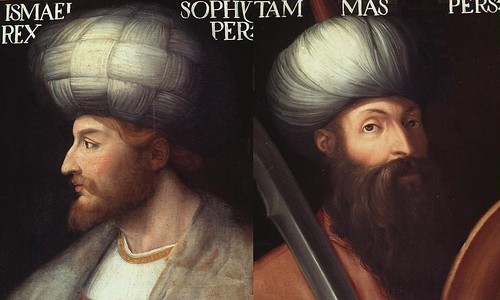
quote:Check this here:
Originally posted by the lioness,:
quote:Amazing how you are scared of what is being revealed here
Originally posted by Mike111:
^Amazing how normally sensible people can be suckered into inane conversations by lioness.



quote:.
Originally posted by Tukuler:
The top figure's hair is wavy at root with artificial curls at tip.












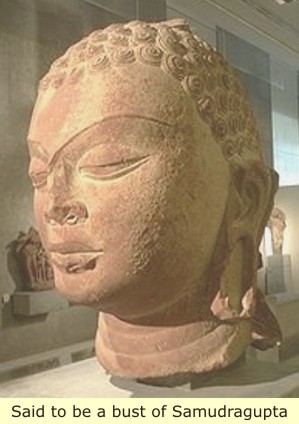
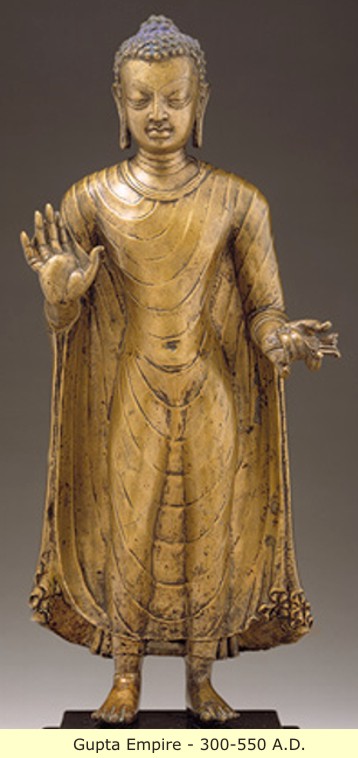


quote:.
Originally posted by Mike111:
... wonder if all of you people are really Albinos from stormfront.
. . .
The pictured ancient hairstyles are they same as is seen today when Blacks wear their hair long with a fillet. What is wrong with you people?
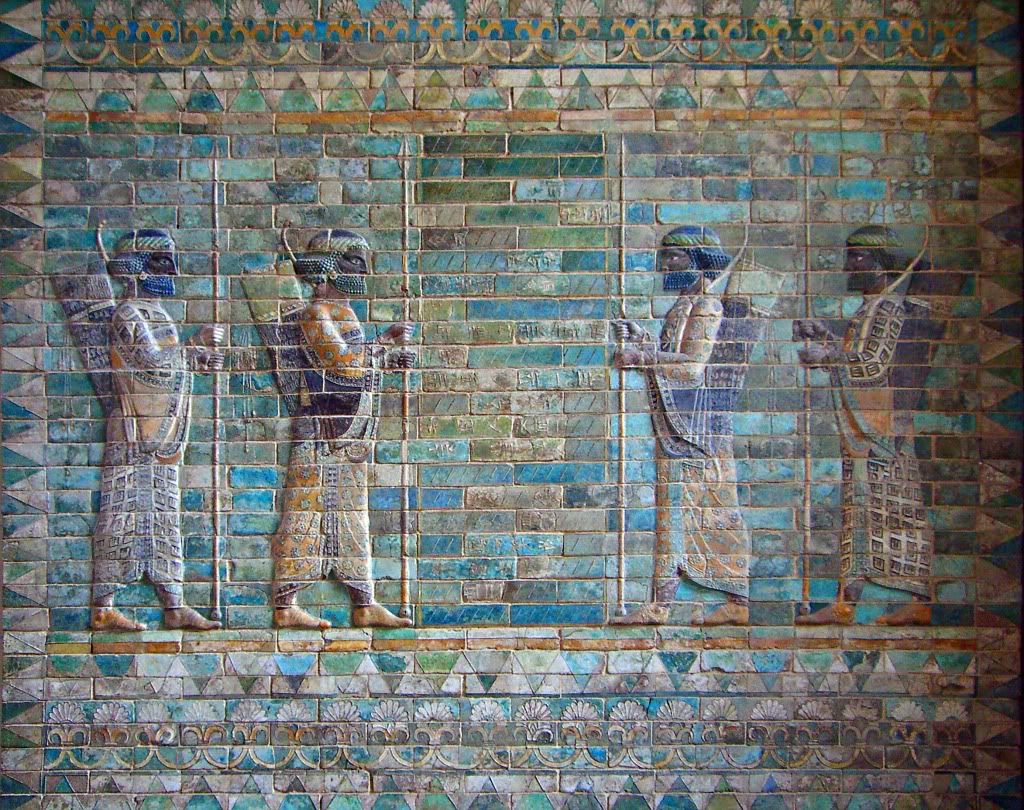
quote:.
Originally posted by the lioness,:

^^^ Here's another one of the Elamite guard figures
Tukuler, has his hair been artifically curled ?




quote:
Originally posted by the lioness,:
quote:.
Originally posted by Tukuler:
The top figure's hair is wavy at root with artificial curls at tip.
,

^^^ Here's another one of the Archers at Persepolis
Tukuler, has his hair been artifically curled ?
quote:Here is a close up of the above>
Originally posted by Tukular
The hair is woolly. Higher resolution reveals the
textile covering held in place by a headband atop
the Elamites' hair which, basing myself on other
images of Elamites, I take to be naturally woolly.
ASSUR RELIEF 10TH-6TH BCE -- Assyrian officer presents a new king to the vanquished Elamites at Madaktu
after the battle of Til Tuba. Stone bas-relief (7th BCE) from the palace of Ashurbanipal in Nineveh, Mesopotamia
(Iraq). British Museum, London, Great Britain
Also, unlike the Persian(?), the Elamite's hair
touching his forehead is woolly. That Persian's
hair at his forehead is wavy ending in artificial
curl. This artificial curling process may have
started in imitation of the elite Elamites of
Susa.
Gaston Maspero
History Of Egypt, Chaldæa, Syria, Babylonia, and Assyria, Volume 4 (of 12)
http://www.gutenberg.org/files/17324/17324-h/17324-h.htm#linkimage-0018
please follow the link [/QB]

quote:I don't know what you mean by " the
Originally posted by Tukular
:
The hair is woolly. Higher resolution reveals the
textile covering held in place by a headband atop
the Elamites' hair which, basing myself on other
images of Elamites, I take to be naturally woolly.


quote:yes, curly hair
Quick witted Greece proclaims in the tanned faces of it's people the gymnasium and the manly wrestling schools. Curly hair about the temples betrays the Syrian.
quote:-woolly hair is a beautiful thing, dark skin is a beautiful thing.
They say : The blacks are
more numerous than the whites. The whites at most consist of the people of Persia, Jibal,
and Khurasan, the Greeks, Slavs, Franks, and Avars, and some few others

quote:
This decorative frieze of polychrome glazed brick shows an army, the men carrying spears, bows and quivers. Are they the royal guards of Darius I (522–486 BC), whom Herodotus called “the Immortals,” or might they represent an idealized image of the Persian people? The frieze is probably inspired by the brick friezes of Babylon, although the technique is different. That may be a legacy from the Middle Elamite Period, which saw the appearance of decoration in glazed siliceous brick.
Archers on parade
The Frieze of Archers had two symmetrical lines of soldiers, parading at a slow march. Each archer’s hands are joined together on the shaft of his spear, and hanging from his shoulders is a bow, its ends in the form of duck’s heads, and a quiver. The butt of the spear, held vertical, rests on the front foot, shod like the other in a laced ankle-boot. The archers wear the long Persian robe, braided and pleated over the legs, the outline of whose ample sleeve describes a curve towards the belted waist. They are bearded, and their thick curly hair is massed at the nape of the neck, held back by a diadem of beaten metal. Each brick is molded from a quart-based body; its outer face is rectangular, but the brick tapers towards the back, a little like a quoin, so as to leave room for mortar when the decorated faces are butted up against each other. The frieze combines low relief and color, with glazes of green, brown, white and yellow separated by fine cloisons of siliceous body.
An inheritance from the Elamite period?
This decorative frieze was certainly inspired by the Processional Way in Babylon, constructed by Nebuchadnezar II (604–562 BC), but the technique is different. The Babylonians used clay for their bricks, rather than the siliceous material employed here. The artists who worked for Darius may have revived a technique developed at Susa by the Elamites in the Late Elamite Period at the end of the second millennium. Polychrome brick decoration in Iran would have a great future in the architecture of the Islamic age.
The Immortals?
Although the British archaeologist W. K. Loftus, the first to excavate at Susa, had identified the main lines of the apadana, he had recognized only isolated motifs, palmettes and rosettes, from its glazed brick decoration. When Marcel Dieulafoy continued his predecessor’s work he discovered enough bricks to make possible the fairly convincing reconstruction displayed at the Louvre: two panels representing a procession of archers, framed by decorative motifs and surmounted by crenellations inspired by the facades of the rock-tombs of Persepolis and Naqsh-e Rustam. The rare inscribed bricks, on which one can still make out the name of Darius, were positioned in the middle. The archers were then assembled as separate panels. While the Lion Frieze was found on the ground at its original position in the East Court of the palace, the exact location of the Frieze of Archers is unknown, countless bricks and fragments having been found more or less all over the place when the apadana was excavated. Their number does suggest a hypothesis: the archers may have been positioned at regular intervals in several registers, over the height of the wall, as at Babylon. They would then have occupied a great part of the exterior walls of the palace, extending over hundreds of metres. How should such a colossal ensemble be understood? Were these men the ‘Immortals,’ the élite regiment of 10,000 men? Or might they rather represent an ideal image, repeated to infinity, of the ‘Persian people,’ a constituent element of the unified empire brought together under the rule of the king, to whom it might have been necessary to accord a special place in the old Elamite capital of Susa?
quote:I have explained to you many times over the many years, that not all "Afro-texture hair" is as "equally kinky". Some is more loose/ soft other more tight, and there is variety in this.
Originally posted by the lioness,:
quote:.
Originally posted by Tukuler:
The top figure's hair is wavy at root with artificial curls at tip.
,
(same picture as top, reversed)
______________________________________________________
.

^^^ Here's another one of the Elamite guard figures
Trollkilah, has his hair been artifically curled ?
Tukuler, has his hair been artifically curled ?
.






quote:Excellent picture.
Originally posted by Mike111:

quote:So, what did your favorite classic Greek writer Herodotus wrote about the Elamites?
Originally posted by the lioness,:
quote:
Originally posted by the lioness,:
quote:.
Originally posted by Tukuler:
The top figure's hair is wavy at root with artificial curls at tip.
,

^^^ Here's another one of the Archers at Persepolis
Tukuler, has his hair been artifically curled ?quote:Here is a close up of the above>
Originally posted by Tukular
The hair is woolly. Higher resolution reveals the
textile covering held in place by a headband atop
the Elamites' hair which, basing myself on other
images of Elamites, I take to be naturally woolly.
ASSUR RELIEF 10TH-6TH BCE -- Assyrian officer presents a new king to the vanquished Elamites at Madaktu
after the battle of Til Tuba. Stone bas-relief (7th BCE) from the palace of Ashurbanipal in Nineveh, Mesopotamia
(Iraq). British Museum, London, Great Britain
Also, unlike the Persian(?), the Elamite's hair
touching his forehead is woolly. That Persian's
hair at his forehead is wavy ending in artificial
curl. This artificial curling process may have
started in imitation of the elite Elamites of
Susa.
Gaston Maspero
History Of Egypt, Chaldæa, Syria, Babylonia, and Assyria, Volume 4 (of 12)
http://www.gutenberg.org/files/17324/17324-h/17324-h.htm#linkimage-0018
please follow the link
^^^ You describe these people as having wooley hair rather than curly.
To me it could be curly or wooley.
Curly hair is found in many ethnicities but wooley hair tends to be found primarily in a more limited range of populations, although there are exceptions.
The Elamites lived in what is now Iran.
The figure at right we get a less common view of an Elamite with this same hair but no beard. To me, with his bulbous chin, his features do not resemble necessarily in particular one of the world's populations that has wooley hair. Do you agree?
quote:I don't know what you mean by " the
Originally posted by Tukular
:
The hair is woolly. Higher resolution reveals the
textile covering held in place by a headband atop
the Elamites' hair which, basing myself on other
images of Elamites, I take to be naturally woolly.
textile covering held in place"
Look at that two figure close up, they have head bands only, their hair is showing above it at the top of their heads.
Maybe you mean this figure has textile covering the top of his head above the headband>>>

I think not but I suppose it's possible. Like with the other figures it appears to me he's just wearing a headband.
But never mind the top of his head, below the headband at the back of his head is a scoop shaped portion of hair that is not curled, it is the same color as the curled portion and does not look like cloth.
It looks just like this:

The painted relief above looks nearly like a painted version of this unpainted relief.
I don't see how anybody could say that the curls on the unpainted relief are artificially made but the painted relief figure has real curls.
In my opinion the ASSUR RELIEF 10TH-6TH BCE you posted are as listed Elamites, however the painted relief, the '"Frieze of the Archers of the Guard" at Persepolis, Susa are not Elamites they are Persians.
So, in my opinion. the painted and unpainted reliefs are both Persian archers.
Surprise, I also believe that hair of both figures hair is naturally curly (although not woolly.) The curls are big and loose rather than tightly curled and the wavy straight portions are either stretched out by the head gear , matted down or >the straight are the artificial parts.
I had been calling them Elamites but no longer.
Now I will just call them the "Frieze of the Archers". I am not absolutely sure but I now think they may be Persians rather than Elamites.
Note also the ASSUR RELIEF Elamites do not have that scoop portion at the back of their heads like these archers.
That doesn't necessarily make it wooley either. To me it could be woolly but it could also be just more tightly curled than the archers but not certainly woolly.
So if all the archers are Persians and the Frieze of the Archers are also Persian, were the Persians dark skinned?
-maybe, or maybe they had a range of skin tones
They don't strike me as African types, Why should they, it's Iran.
There are some blacks in Iran right now, however they they to be broad nosed and as far as I know trace their roots back to the Zanj or other Africans who came into to the region several hundred years or less. The medieval Islamic writer Al-Jahiz of Bashra may fhave been in part iof this ethnicity
However If we return to the Black Obelisk of Shalmaneser III figures, or the Lachish figures they are unpainted so color doesn't apply.
As per Persians Manilius Astronomica many hundreds of year later, he describes tanned Greeks and neighboring Syrians thus:
quote:yes, curly hair
Quick witted Greece proclaims in the tanned faces of it's people the gymnasium and the manly wrestling schools. Curly hair about the temples betrays the Syrian.
More hundreds of years later Al-Jahiz states:
quote:-woolly hair is a beautiful thing, dark skin is a beautiful thing.
They say : The blacks are
more numerous than the whites. The whites at most consist of the people of Persia, Jibal,
and Khurasan, the Greeks, Slavs, Franks, and Avars, and some few others
People with woolly hair can treat their hair in various ways to make it have a curly shape, that is larger curls then it's natural form or in some cases dredlocked.
But once it is in this form and depicted on a sculpture, at this point you can't tell it apart from other etncities who also have culry hair that is not woolly.
Louvre remarks below
'"Frieze of the Archers of the Guard" at Persepolis Susa

http://www.louvre.fr/en/oeuvre-notices/frieze-archers
quote:[/QB]
This decorative frieze of polychrome glazed brick shows an army, the men carrying spears, bows and quivers. Are they the royal guards of Darius I (522–486 BC), whom Herodotus called “the Immortals,” or might they represent an idealized image of the Persian people? The frieze is probably inspired by the brick friezes of Babylon, although the technique is different. That may be a legacy from the Middle Elamite Period, which saw the appearance of decoration in glazed siliceous brick.
Archers on parade
The Frieze of Archers had two symmetrical lines of soldiers, parading at a slow march. Each archer’s hands are joined together on the shaft of his spear, and hanging from his shoulders is a bow, its ends in the form of duck’s heads, and a quiver. The butt of the spear, held vertical, rests on the front foot, shod like the other in a laced ankle-boot. The archers wear the long Persian robe, braided and pleated over the legs, the outline of whose ample sleeve describes a curve towards the belted waist. They are bearded, and their thick curly hair is massed at the nape of the neck, held back by a diadem of beaten metal. Each brick is molded from a quart-based body; its outer face is rectangular, but the brick tapers towards the back, a little like a quoin, so as to leave room for mortar when the decorated faces are butted up against each other. The frieze combines low relief and color, with glazes of green, brown, white and yellow separated by fine cloisons of siliceous body.
An inheritance from the Elamite period?
This decorative frieze was certainly inspired by the Processional Way in Babylon, constructed by Nebuchadnezar II (604–562 BC), but the technique is different. The Babylonians used clay for their bricks, rather than the siliceous material employed here. The artists who worked for Darius may have revived a technique developed at Susa by the Elamites in the Late Elamite Period at the end of the second millennium. Polychrome brick decoration in Iran would have a great future in the architecture of the Islamic age.
The Immortals?
Although the British archaeologist W. K. Loftus, the first to excavate at Susa, had identified the main lines of the apadana, he had recognized only isolated motifs, palmettes and rosettes, from its glazed brick decoration. When Marcel Dieulafoy continued his predecessor’s work he discovered enough bricks to make possible the fairly convincing reconstruction displayed at the Louvre: two panels representing a procession of archers, framed by decorative motifs and surmounted by crenellations inspired by the facades of the rock-tombs of Persepolis and Naqsh-e Rustam. The rare inscribed bricks, on which one can still make out the name of Darius, were positioned in the middle. The archers were then assembled as separate panels. While the Lion Frieze was found on the ground at its original position in the East Court of the palace, the exact location of the Frieze of Archers is unknown, countless bricks and fragments having been found more or less all over the place when the apadana was excavated. Their number does suggest a hypothesis: the archers may have been positioned at regular intervals in several registers, over the height of the wall, as at Babylon. They would then have occupied a great part of the exterior walls of the palace, extending over hundreds of metres. How should such a colossal ensemble be understood? Were these men the ‘Immortals,’ the élite regiment of 10,000 men? Or might they rather represent an ideal image, repeated to infinity, of the ‘Persian people,’ a constituent element of the unified empire brought together under the rule of the king, to whom it might have been necessary to accord a special place in the old Elamite capital of Susa?





quote:.
Originally posted by the lioness,:

quote:.
Originally posted by Tukuler:
The top figure's hair is wavy at root with artificial curls at tip.
quote:what African? No one knows what you are talking about, try to be clear
Originally posted by Mike111:
Lioness I can understand trying to muddy the waters: but the African, is it that they are just so out of touch out there in the desert?



quote:Yepper and that's why my hi-resolution image showing that
Originally posted by Trollkillah # Ish Gebor:
the top of that strangers man's head can't even be seen.![[Big Grin]](biggrin.gif)




quote:^The hair texture of the people above is by far not the same wooly texture.
Originally posted by sero:
He actually looks Dravidian.


quote:I don't know, but what I do know is this...and unfortunately you didn't show what your favorite classic Greek writer Herodotus wrote about the Elamites!
Originally posted by the lioness,:
Trollkillah do you agree or disgree with Tukular?
quote:.
Originally posted by the lioness,:

quote:.
Originally posted by Tukuler:
The top figure's hair is wavy at root with artificial curls at tip.
Trollkillah do you agree or disgree with Tukular that the above depicts artifiical curls
or are you uncertain?
I know you won't answer this because you are a coward that copies what other people say
Go ahead spam some more, I don't deal with cowards


quote:--Moshe et al.
8 Cush had a son named Nimrod, who became the world's first great conqueror. 9 By the Lord's help he was a great hunter, and that is why people say, “May the Lord make you as great a hunter as Nimrod!” 10 At first his kingdom included Babylon, Erech, and Accad, all three of them in Babylonia. 11 From that land he went to Assyria and built the cities of Nineveh, Rehoboth Ir, Calah,
12 and Resen, which is between Nineveh and the great city of Calah.
quote:--Moorjani et al.
"A potential issue that could in theory influence our findings is that the exact population contributing to African ancestry in West Eurasians is unknown. To gain insight into the African source populations, we carried out PCA analyses, which suggested that the African ancestry in West Eurasians is at least as closely related to East Africans (e.g. Hapmap3 Luhya (LWK)) as to West Africans (e.g. Nigerian Yoruba (YRI)) (the same analyses show that there is no evidence of relatedness to Chadic populations like Bulala) (Text S5 and Figure S12).
We also used the 4 Population Test to assess whether the tree ((LWK, YRI),(West Eurasian, CEU)) is consistent with the data, and found no evidence for a violation,
which is consistent with a mixture of either West African or East African ancestors or both contributing to the African ancestry in West Eurasians (Table S14; Figure S13). Historically, a mixture of West and East African ancestry is plausible, since African gene flow into West Eurasia is documented from both West Africa during Roman times [34] and from East Africa during migrations from Egypt [7]. It is important to point out, however, that the difficulty of pinpointing the exact African source population is not expected to bias our inferences about the total proportion and date of mixture. The f4 Ancestry Estimation method is unbiased even when we use a poor surrogates for the true ancestral African population (as long as the phylogeny is correct), as we confirmed by repeating analyses replacing YRI with LWK, and obtaining similar results (Table S15).Our ROLLOFF admixture date estimates are also similar whether we use LWK or YRI to represent ancestral African population (Table S15), as predicted by the theory.
quote:-- (Ehret 1995; Ehret et al. 2004; Blench 2006).
"These results indicate that the ancestor of all Semitic languages in our dataset was being spoken in the Near East no earlier than approximately 7400 YBP, after having after having diverged from Afroasiatic in Africa"
(i) Semitic had an Early Bronze Age origin (approx. 5750 YBP) in the Levant, followed by an expansion of Akkadian into Mesopotamia;
(ii) Central and South Semitic diverged earlier than previously thought throughout the Levant during the Early to Middle Bronze Age transition; and
(iii) Ethiosemitic arose as the result of a single, possibly pre-Aksumite, introduction of a lineage from southern Arabia to the Horn of Africa approximately 2800 YBP.


quote:.
Originally posted by sero:
He actually looks Dravidian.
quote:.
Originally posted by Trollkillah # Ish Gebor:
Main Entry: ulot·ri·chous
Pronunciation: \-rə̇kəs\
Function: adjective
Etymology:
New Latin Ulotrichi (plural) division of humankind having crisp or woolly hair
(from Greek oulotrich-, oulothrix having curly or woolly hair,
from oulos curly, woolly + trich-, thrix hair) + English -ous; akin to Greek eilein to roll, eilyein to roll, wrap — more at trich-, voluble
: exhibiting ulotrichy : having woolly or crisp hair
http://www.merriam-webster.com/dictionary/ulotrichous
the lioness productions team f*cked up again.

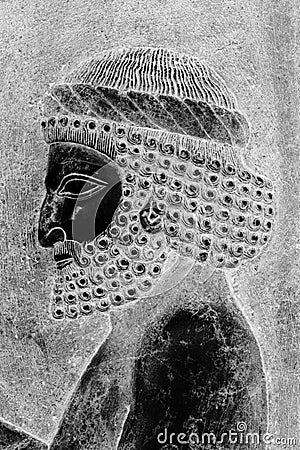

quote:Tukular looses credibility here
Originally posted by Tukuler:
quote:Yepper and that's why my hi-resolution image showing that
Originally posted by Trollkillah # Ish Gebor:
the top of that strangers man's head can't even be seen.![[Big Grin]](biggrin.gif)
the Elamite's hair beard sideburn and forelock are all woolly.
you know, the one Lyin'Ass don't like and refuses to reference and acts like he can't
see yet wants to turn his textile head cover under the headband into straight hair.







quote:
Originally posted by Tukuler:
Dumbass bitch
The textile covers the top of the head as well the back.
Do you think there's only one Elamite Immortal that ever got depicted?
It's over obvious what is hair and what is not hair.
Only fake thing 'round here is your fake ass.



quote:yes, if you are stupid
Originally posted by Tukuler:
Curly and wooly are the same
quote:.
Originally posted by Tukuler:
quote:.
Originally posted by Trollkillah # Ish Gebor:
Main Entry: ulot·ri·chous
Pronunciation: \-rə̇kəs\
Function: adjective
Etymology:
New Latin Ulotrichi (plural) division of humankind having crisp or woolly hair
(from Greek oulotrich-, oulothrix having curly or woolly hair,
from oulos curly, woolly + trich-, thrix hair) + English -ous; akin to Greek eilein to roll, eilyein to roll, wrap — more at trich-, voluble
: exhibiting ulotrichy : having woolly or crisp hair
http://www.merriam-webster.com/dictionary/ulotrichous
the lioness productions team f*cked up again.
And continues the same.
That's why I dubbed it
Lyin'Ass Phuckuptions
trying to escape woolly
by suggesting curly
It's only a matter of nap count
www.egyptsearch.com/forums/ultimatebb.cgi?ubb=get_topic;f=8;t=005141#000029




quote:He makes up a "textile" add on to a headband that has no scholarly source to support it yet calls it a fact
Originally posted by Tukuler:
OK, it may not be stiff cloth but whatever it is
it's not hair of any kind no way no shape no how.
Not trying to convince Lyin'Ass because she doesn't
care for facts he only cares to make anything even
remotely black to be limited to sub-Sahara Africa.
Intelligent lurkers and surfers though quiet are
surely not falling for his obvious face saving
melanophobic bullshit.
quote:this type of certainty is a mark of foolishness
Originally posted by Tukuler:
OK, it may not be stiff cloth but whatever it is
it's not hair of any kind no way no shape no how.
quote:Yep, you've f*ckedup again. Now show us what your favorite "poster boy" Herodotus wrote about the Elamites.
Originally posted by the lioness,:
According to Herodotus these are a form of Ethiopian


quote:Yep, you're right not all curly is wooly, but curly can be wooly. And we are having a conversation on woolly hair texture, remember? So in that context curly and woolly are the same.
Originally posted by the lioness,:
quote:yes, if you are stupid
Originally posted by Tukuler:
Curly and wooly are the same
otherwise you would know all woolly hair is curly
but not all curly hair is woolly




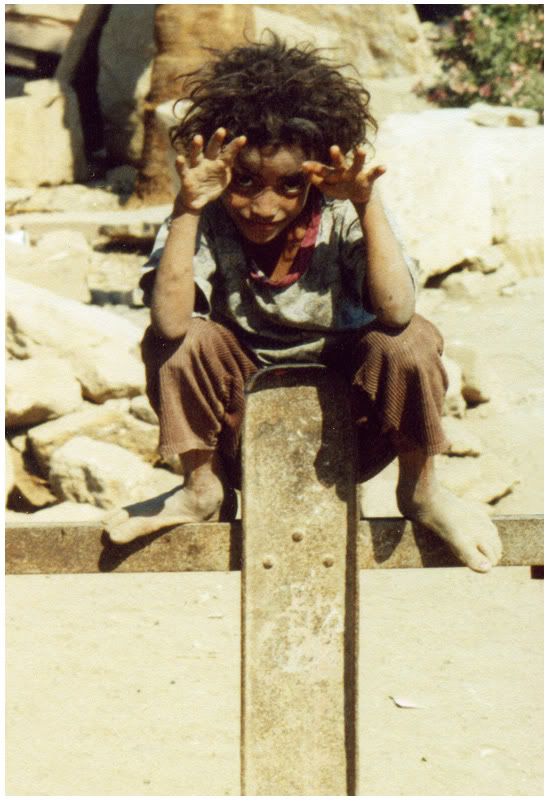
quote:More of your baseless idiotic iterating rantings. And it really leads nowhere, just a bottomless pit. If it's "not a headband" according to you, then tell what it is?lol
Originally posted by the lioness,:
^^^^ This is a close up of what scholars are confident is an Elamite from a larger scene Tukuliar posted.
Elam was an ancient civilization centered in the far west and southwest of modern-day Iran.
Notice he doesn't look that similar to this archer, differences in the hair are obvious
(sorry for more good color quality photos)
^ Tukular has ZERO sources to back his claim that this man has anything other than a headband on his head
Scholars are not certain what ethnicity these archers are
The hair on this archer, resembles this >

Relief of a warrior at the ancient ruins of Persepolis, Iran.
(notice that there is even a small row of curls along the forehead)
he's got the sidburns that Tukular keeps trying to BS on
and the point that he is still too thick to get, is that if there was cloth hanging down form that headband it would be covering up a portion of hair that on other very similar figures at Persepolis that have straight hair in that section while the rest of their hair and beards are curly
It is so very obvious
quote:Royal City of Susa: Ancient Near Eastern Treasures in the Louvre
The ancient city of Susa (biblical Shushan) lay at the edge of the Iranian plateau, not far from the great cities of Mesopotamia. A strategically located and vital center, Susa absorbed diverse influences and underwent great political fluctuations during the several thousand years of its history. When French archaeologists began to excavate its site in the nineteenth century, the astonishing abundance of finds greatly expanded our understanding of the ancient Near East. The artifacts were taken to Paris through diplomatic agreement and became a centerpiece of the Louvre's great collection of Near Eastern antiquities. These works are rarely loaned, but a remarkable selection that includes many undisputed masterpieces, brought to The Metropolitan Museum of Art for exhibition, is presented in this comprehensive publication.
Susa was settled about 4000 B.C. and has yielded striking pottery finds from that prehistoric period. A rich production followed of objects for daily use, ritual, and luxury living, finely carved in various materials or fashioned of clay. Monumental sculpture was made in stone or bronze, and dramatic friezes were composed of brilliantly glazed bricks. Among the discoveries are tiny, intricately carved cylinder seals and splendid jewelry. Clay balls marked with symbols offer fascinating testimony to the very beginnings of writing; clay tablets from later periods bearing inscriptions in cuneiform record political history, literature, business transactions, and mathematical calculations.
A very important group of finds from Susa is made up of objects brought back as booty from conquests in Mesopotamia. These works, many of them the royal monuments of Akkadian and Babylonian monarchs—for instance, the great stele of Naram-Sin—are among the best known of all objects from the ancient Near East. Altogether, the exhibition presents more than two hundred objects found at Susa, produced over a period of about 3500 years. They come from all periods of the site's settlement, from it earliest history to its adornment as a major city of the opulent Achaemenid Persian empire.
Eighteen French and American scholars have contributed essays to this volume on subjects that include the history of art in ancient Iran from prehistoric settlement through the Achaemenid period; the history of the excavations at Susa; the development of writing; seals and sealings; royal and religious structures at Susa; objects brought from Mesopotamia; brick decoration; popular art; and cuneiform texts. Recent results of ongoing research into the archaeology of Susa are discussed. Analyses of specific techniques are included as well as reports on the conservation of objects. Each work in the exhibition is illustrated and fully described, with references to relevant publications.
quote:--Moshe et al.
8 Cush had a son named Nimrod, who became the world's first great conqueror. 9 By the Lord's help he was a great hunter, and that is why people say, “May the Lord make you as great a hunter as Nimrod!” 10 At first his kingdom included Babylon, Erech, and Accad, all three of them in Babylonia. 11 From that land he went to Assyria and built the cities of Nineveh, Rehoboth Ir, Calah,
12 and Resen, which is between Nineveh and the great city of Calah.
quote:--Moorjani et al.
"A potential issue that could in theory influence our findings is that the exact population contributing to African ancestry in West Eurasians is unknown. To gain insight into the African source populations, we carried out PCA analyses, which suggested that the African ancestry in West Eurasians is at least as closely related to East Africans (e.g. Hapmap3 Luhya (LWK)) as to West Africans (e.g. Nigerian Yoruba (YRI)) (the same analyses show that there is no evidence of relatedness to Chadic populations like Bulala) (Text S5 and Figure S12).
We also used the 4 Population Test to assess whether the tree ((LWK, YRI),(West Eurasian, CEU)) is consistent with the data, and found no evidence for a violation,
which is consistent with a mixture of either West African or East African ancestors or both contributing to the African ancestry in West Eurasians (Table S14; Figure S13). Historically, a mixture of West and East African ancestry is plausible, since African gene flow into West Eurasia is documented from both West Africa during Roman times [34] and from East Africa during migrations from Egypt [7]. It is important to point out, however, that the difficulty of pinpointing the exact African source population is not expected to bias our inferences about the total proportion and date of mixture. The f4 Ancestry Estimation method is unbiased even when we use a poor surrogates for the true ancestral African population (as long as the phylogeny is correct), as we confirmed by repeating analyses replacing YRI with LWK, and obtaining similar results (Table S15).Our ROLLOFF admixture date estimates are also similar whether we use LWK or YRI to represent ancestral African population (Table S15), as predicted by the theory.
quote:~Andrew Kitchen, Christopher Ehret2, Shiferaw Assefa2 and Connie J. Mulligan
Our statistical tests of alternative Semitic histories support an initial divergence of Akkadian from ancestral Semitic over competing hypotheses (e.g. an African origin of Semitic). We estimate an Early Bronze Age origin for Semitic approximately 5750 years ago in the Levant, and further propose that contemporary Ethiosemitic languages of Africa reflect a single introduction of early Ethiosemitic from southern Arabia approximately 2800 years ago.
[…]
Semitic languages (Akkadian, Aramaic, Ge'ez, ancient Hebrew and Ugaritic) combined with archaeological evidence for the sampling dates of the epigraphic data (the time at which the materials were inscribed).

"These results indicate that the ancestor of all Semitic languages in our dataset was being spoken in the Near East no earlier than approximately 7400 YBP, after having after having diverged from Afroasiatic in Africa"
(i) Semitic had an Early Bronze Age origin (approx. 5750 YBP) in the Levant, followed by an expansion of Akkadian into Mesopotamia;
(ii) Central and South Semitic diverged earlier than previously thought throughout the Levant during the Early to Middle Bronze Age transition; and
(iii) Ethiosemitic arose as the result of a single, possibly pre-Aksumite, introduction of a lineage from southern Arabia to the Horn of Africa approximately 2800 YBP.

quote:
Originally posted by the lioness,:
quote:He makes up a "textile" add on to a headband that has no scholarly source to support it yet calls it a fact
Originally posted by Tukuler:
OK, it may not be stiff cloth but whatever it is
it's not hair of any kind no way no shape no how.
Not trying to convince Lyin'Ass because she doesn't
care for facts he only cares to make anything even
remotely black to be limited to sub-Sahara Africa.
Intelligent lurkers and surfers though quiet are
surely not falling for his obvious face saving
melanophobic bullshit.
That is proof he's a lair
I think he knows he's lying because otherwise he would be quiet for a while looking for a source to back it up.
But he knows he's bullshytting
Some of these veterans are obsolete, need to be put out to pasture
He calls me "melanophobic" when the subject is hair, lol
quote:this type of certainty is a mark of foolishness
Originally posted by Tukuler:
OK, it may not be stiff cloth but whatever it is
it's not hair of any kind no way no shape no how.
A more reasonable thing to say is you don't know if it's hair or not
--and again, if it's not hair then you don't know what type of hair is under it


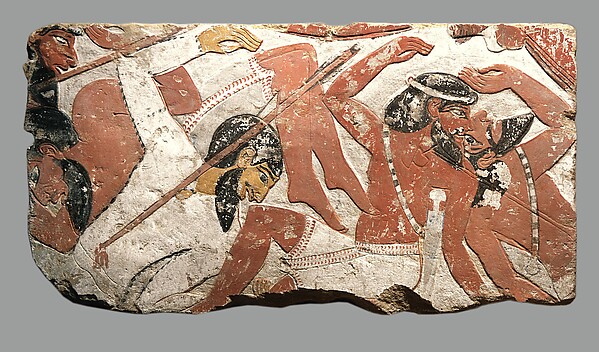

![[Wink]](wink.gif)



quote:
Originally posted by Trollkillah # Ish Gebor:
These works are rarely loaned, but a remarkable selection that includes many undisputed masterpieces, brought to The Metropolitan Museum of Art for exhibition, is presented in this comprehensive publication.
Susa was settled about 4000 B.C. and has yielded striking pottery finds from that prehistoric period. A rich production followed of objects for daily use, ritual, and luxury living, finely carved in various materials or fashioned of clay.
quote:Trollkillah were the people of Susa long term residents of the Mesopotamia going back tens of thousands of years of years or were they Africans who settled there 4-5,000 years ago ?
Originally posted by Trollkillah # Ish Gebor:
In your eyes everybody looks Dravidian.^
Anyway, what it does tell us is what the original Semites looked like.
"Mari was settled in the 5th millennium BCE."
http://looklex.com/e.o/mari.htm

quote:Trollkillah, isn't it possible that this is a straight haired Black Anatolian?
Originally posted by the lioness,:
[QB] .
https://en.wikipedia.org/wiki/Black_Obelisk_of_Shalmaneser_III
Black Obelisk of Shalmaneser III
It is the most complete Assyrian obelisk yet discovered, and is historically significant because it is thought to display the earliest ancient depiction of a biblical figure - Hoshea King of Israel. The traditional identification of "Yaw" as Jehu has been questioned by some scholars, who proposed that the inscription refers to another king, Jehoram of Israel. Its reference to 'Parsua' is also the first known reference to the Persians.

quote:Darius' so-called 'Frieze of the Archers'
Originally posted by the lioness,:
their thick curly hair is massed at the nape of
the neck, held back by a diadem of beaten metal.
[...]
The artists who worked for Darius may have revived
a technique developed at Susa by the Elamites in the
Late Elamite Period at the end of the second millennium.
[...]
Were these men the ‘Immortals,’ the élite regiment of 10,000
men? Or might they rather represent an ideal image, repeated
to infinity, of the ‘Persian people,’ a constituent element
of the unified empire brought together under the rule of the
king, to whom it might have been necessary to accord a special
place in the old Elamite capital of Susa?


quote:You are hilarious, funny. While I already posted the below along. And yet you have to show us your favorite greek poster boy writer Herodotus on the Elamite, and for a fact we know that the Susa/ Elamite "in general" don't look like the modern people who settle that region nowadays. These questions need to be answered. But to answer your question, most likely it's a combination of both. Considering the post-Natufian settlements.
Originally posted by the lioness,:
quote:
Originally posted by Trollkillah # Ish Gebor:
These works are rarely loaned, but a remarkable selection that includes many undisputed masterpieces, brought to The Metropolitan Museum of Art for exhibition, is presented in this comprehensive publication.
Susa was settled about 4000 B.C. and has yielded striking pottery finds from that prehistoric period. A rich production followed of objects for daily use, ritual, and luxury living, finely carved in various materials or fashioned of clay.quote:Trollkillah were the people of Susa long term residents of the Mesopotamia going back tens of thousands of years of years or were they Africans who settled there 4-5,000 years ago ?
Originally posted by Trollkillah # Ish Gebor:
In your eyes everybody looks Dravidian.^
Anyway, what it does tell us is what the original Semites looked like.
"Mari was settled in the 5th millennium BCE."
http://looklex.com/e.o/mari.htm

quote:--Moshe et al.
8 Cush had a son named Nimrod, who became the world's first great conqueror. 9 By the Lord's help he was a great hunter, and that is why people say, “May the Lord make you as great a hunter as Nimrod!” 10 At first his kingdom included Babylon, Erech, and Accad, all three of them in Babylonia. 11 From that land he went to Assyria and built the cities of Nineveh, Rehoboth Ir, Calah,
12 and Resen, which is between Nineveh and the great city of Calah.
quote:--Moorjani et al.
"A potential issue that could in theory influence our findings is that the exact population contributing to African ancestry in West Eurasians is unknown. To gain insight into the African source populations, we carried out PCA analyses, which suggested that the African ancestry in West Eurasians is at least as closely related to East Africans (e.g. Hapmap3 Luhya (LWK)) as to West Africans (e.g. Nigerian Yoruba (YRI)) (the same analyses show that there is no evidence of relatedness to Chadic populations like Bulala) (Text S5 and Figure S12).
We also used the 4 Population Test to assess whether the tree ((LWK, YRI),(West Eurasian, CEU)) is consistent with the data, and found no evidence for a violation,
which is consistent with a mixture of either West African or East African ancestors or both contributing to the African ancestry in West Eurasians (Table S14; Figure S13). Historically, a mixture of West and East African ancestry is plausible, since African gene flow into West Eurasia is documented from both West Africa during Roman times [34] and from East Africa during migrations from Egypt [7]. It is important to point out, however, that the difficulty of pinpointing the exact African source population is not expected to bias our inferences about the total proportion and date of mixture. The f4 Ancestry Estimation method is unbiased even when we use a poor surrogates for the true ancestral African population (as long as the phylogeny is correct), as we confirmed by repeating analyses replacing YRI with LWK, and obtaining similar results (Table S15).Our ROLLOFF admixture date estimates are also similar whether we use LWK or YRI to represent ancestral African population (Table S15), as predicted by the theory.
quote:-- (Ehret 1995; Ehret et al. 2004; Blench 2006).
"These results indicate that the ancestor of all Semitic languages in our dataset was being spoken in the Near East no earlier than approximately 7400 YBP, after having after having diverged from Afroasiatic in Africa"
(i) Semitic had an Early Bronze Age origin (approx. 5750 YBP) in the Levant, followed by an expansion of Akkadian into Mesopotamia;
(ii) Central and South Semitic diverged earlier than previously thought throughout the Levant during the Early to Middle Bronze Age transition; and
(iii) Ethiosemitic arose as the result of a single, possibly pre-Aksumite, introduction of a lineage from southern Arabia to the Horn of Africa approximately 2800 YBP.


quote:Yeah, it's beautiful isn't?
Originally posted by the lioness,:

Bust, Roman-Ethiopian woman

quote:Could be, the headwear was common in the region (Northern part). Other than that the images tell nothing, as far as I'm concerned.
Originally posted by the lioness,:
quote:Trollkillah, isn't it possible that this is a straight haired Black Anatolian?
Originally posted by the lioness,:
[QB] .
https://en.wikipedia.org/wiki/Black_Obelisk_of_Shalmaneser_III
Black Obelisk of Shalmaneser III
It is the most complete Assyrian obelisk yet discovered, and is historically significant because it is thought to display the earliest ancient depiction of a biblical figure - Hoshea King of Israel. The traditional identification of "Yaw" as Jehu has been questioned by some scholars, who proposed that the inscription refers to another king, Jehoram of Israel. Its reference to 'Parsua' is also the first known reference to the Persians.
quote:Helmet with divine figures beneath a bird with outstretched wings, 14th century B.C.; Middle Elamite period
This example of military headgear is elaborately decorated with three figures on the front. The central one is a male water deity who holds a flowing vase at his chest. He has a multiple horned crown, a beard, curled hair, and a mountainlike or scale pattern on the lower body like the one on the background. The top of the garment crisscrosses his chest. He is flanked by two female deities with horned crowns who hold their hands up in supplication. Their robes are flounced and they wear necklaces and bracelets. Hovering over the figures is a raptor-like bird with carefully delineated feathers. At the back is a decorated tube that may have held an actual feather plume. All of these elements were carved from bitumen and overlaid with silver and then gold foil with incised decoration, a technique that, along with the style and types of the figures, point to Elam as the source. The water god might be either the Elamite Inshushinak or Napirisha, similar to Ea, the Mesopotamian god of the sweet waters.
Such a helmet would have been worn by a warrior of high rank, and perhaps on special occasions rather than in actual battle. The representations of protective and important deities could certainly have been apotropaic for the wearer.
quote:Is this to try to trick me into doing the research for you ???
Originally posted by Trollkillah # Ish Gebor:
[ And yet you have to show us your favorite greek poster boy writer Herodotus on the Elamite,
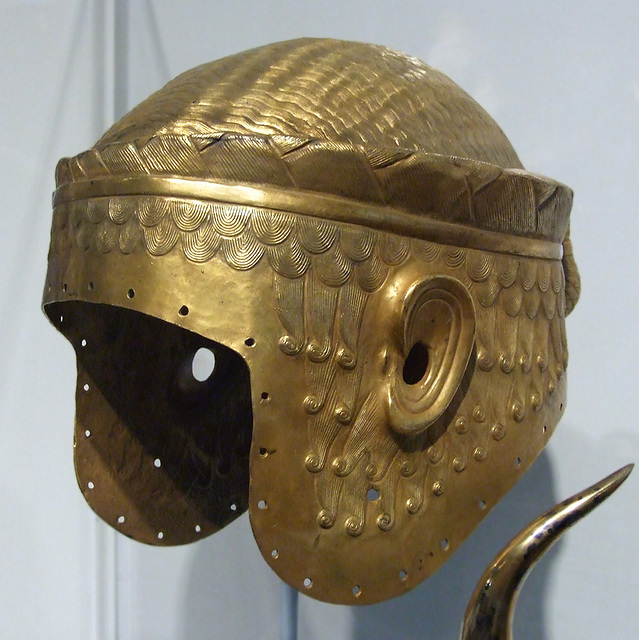
quote:Ok, I'll help out with a close up on the center figure
Originally posted by Trollkillah # Ish Gebor:
Let's research Susa / Elam headgear,
quote:Helmet with divine figures beneath a bird with outstretched wings, 14th century B.C.; Middle Elamite period
This example of military headgear is elaborately decorated with three figures on the front. The central one is a male water deity who holds a flowing vase at his chest. He has a multiple horned crown, a beard, curled hair, and a mountainlike or scale pattern on the lower body like the one on the background. The top of the garment crisscrosses his chest. He is flanked by two female deities with horned crowns who hold their hands up in supplication. Their robes are flounced and they wear necklaces and bracelets. Hovering over the figures is a raptor-like bird with carefully delineated feathers. At the back is a decorated tube that may have held an actual feather plume. All of these elements were carved from bitumen and overlaid with silver and then gold foil with incised decoration, a technique that, along with the style and types of the figures, point to Elam as the source. The water god might be either the Elamite Inshushinak or Napirisha, similar to Ea, the Mesopotamian god of the sweet waters.
Such a helmet would have been worn by a warrior of high rank, and perhaps on special occasions rather than in actual battle. The representations of protective and important deities could certainly have been apotropaic for the wearer.
Southwestern Iran
Bronze; gold foil over bitumen; H. 6 1/2 in. (16.5 cm)
Fletcher Fund, 1963 (63.74)
SEE COMPLETE RECORD .
http://www.metmuseum.org/toah/works-of-art/63.74

quote:Herodotus is your favorite classical writer. Aren't you aware of his writings on the Elam? It's not a trick, it's an acknowledgement.
Originally posted by the lioness,:
quote:Is this to try to trick me into doing the research for you ???
Originally posted by Trollkillah # Ish Gebor:
[ And yet you have to show us your favorite greek poster boy writer Herodotus on the Elamite,
funny thing is that he didn't mention the Elamites, lol
quote:Herodotus didn't write about Elam so why continue being silly ?
Originally posted by Trollkillah # Ish Gebor:
quote:Herodotus is your favorite classical writer. Aren't you aware of his writings on the Elam? It's not a trick, it's an acknowledgement.
Originally posted by the lioness,:
quote:Is this to try to trick me into doing the research for you ???
Originally posted by Trollkillah # Ish Gebor:
[ And yet you have to show us your favorite greek poster boy writer Herodotus on the Elamite,
funny thing is that he didn't mention the Elamites, lol
quote:http://news.nationalgeographic.com/news/2008/11/081103-hebrew-text_2.html
Oldest Hebrew Text Is Evidence for Bible Stories?
It's not known whether the Judeans or the Philistines controlled the strategic fortress overlooking the Elah Valley, which was surrounded by nearly 3,000-foot-long (700-meter-long) fortifications built of massive stones.
But Garfinkel believes the site was most likely the westernmost outpost maintained by the Kingdom of Judea, which controlled land in southwest Asia and Palestine and was a predecessor to the Kingdom of Israel.
For instance, pottery at the fortress is similar to that found at other Israelite sites, and there are no pig remains—an indicator that often distinguishes Israelite from Philistine sites.
The newfound Hebrew text has also added new evidence of Judean rule, since key words indicate the text is most likely Hebrew.
(Related: "4,000-Year-Old Tombs Found Near Jerusalem Mall" [November 21, 2006].)
Proving the Bible?
Garfinkel believes the Elah site and newfound writing could provide historic evidence of the United Monarchy in the tenth century B.C.
That's when King David is said to have united Judea and Israel, establishing a large kingdom that stretched between the Nile River in present-day Egypt and the Euphrates in Iraq, according to the Bible.
Though most researchers don't believe this kingdom existed, evidence from the site and pottery shard seems to support the idea of a strong central administration based in nearby Jerusalem, as detailed in the Bible, Garfinkel said.
(Related: "Jerusalem Tunnel Linked to Bible" [September 11, 2003].)
"There is a big debate if the biblical tradition is accurate history or mythology written hundreds of years later … But this is the first time in the archaeology of Israel we have evidence that in the time of King David such heavily fortified cities were built."
ABC Evolution
The ancient text may also shed light on the evolution of the world's alphabetic languages.
"This is the first time that we have a Proto-Canaanite inscription dated in [the context of] an archaeological site from the tenth century B.C.," Garfinkel said.
"This is a major contribution to the understanding of writing in the world."
The evolution of alphabetic scripts, which had their origins in Proto-Canaanite some 3,700 years ago, was one of humankind's greatest intellectual achievements, experts say.
"This allowed everyone to read and write. Before this, Sumerian scripts and Egyptian hieroglyphs were very complicated writing techniques … only trained scribes could read and write in the ancient Near East," Garfinkel said.
Archaeological Doubts
Tel Aviv University archaeologist Israel Finkelstein, who is not involved in the Elah excavations, agreed the site is very important, but has significant concerns with Garfinkel's interpretations of the findings.
Immediately drawing ties between the site and the Kingdom of Judea is a mistake, he said—and it might well have been Philistine in origin.
Also, due to the small number of samples, the carbon-14 dating of the site is also not as precise as it should be, he added.
"We need to wait for more samples. It's not enough to date the site based on two [olive pits]," he said.
He also expressed doubts about the centerpiece of Garfinkel's findings—the text.
"I am prepared to predict that it will be very difficult to determine whether the text is, in fact, Hebrew. There will be evidence indicating various possibilities," he said.
"In the nature of its discovery, this [piece of pottery] is also not unusual. There is a group of late Proto-Canaanite [pottery shards] from the same chronological phase that have been found in various sites on the coastal plain—none of them were discovered in Judea proper."
quote:But Herodotus traveled to west Asia, didn't he?
Originally posted by the lioness,:
quote:Herodotus didn't write about Elam so why continue being silly ?
Originally posted by Trollkillah # Ish Gebor:
quote:Herodotus is your favorite classical writer. Aren't you aware of his writings on the Elam? It's not a trick, it's an acknowledgement.
Originally posted by the lioness,:
quote:Is this to try to trick me into doing the research for you ???
Originally posted by Trollkillah # Ish Gebor:
[ And yet you have to show us your favorite greek poster boy writer Herodotus on the Elamite,
funny thing is that he didn't mention the Elamites, lol
quote:I didn't ask for help, but since you're on this quest...you'll may explain what these figurines represent. From the Helmet with divine figures beneath a bird with outstretched wings, 14th century B.C.; Middle Elamite period.
Originally posted by the lioness,:
quote:Ok, I'll help out with a close up on the center figure
Originally posted by Trollkillah # Ish Gebor:
Let's research Susa / Elam headgear,
quote:Helmet with divine figures beneath a bird with outstretched wings, 14th century B.C.; Middle Elamite period
This example of military headgear is elaborately decorated with three figures on the front.
The central one is a male water deity who holds a flowing vase at his chest. He has a multiple horned crown, a beard, curled hair, and a mountainlike or scale pattern on the lower body like the one on the background. The top of the garment crisscrosses his chest. He is flanked by two female deities with horned crowns who hold their hands up in supplication. Their robes are flounced and they wear necklaces and bracelets. Hovering over the figures is a raptor-like bird with carefully delineated feathers. At the back is a decorated tube that may have held an actual feather plume. All of these elements were carved from bitumen and overlaid with silver and then gold foil with incised decoration, a technique that, along with the style and types of the figures, point to Elam as the source. The water god might be either the Elamite Inshushinak or Napirisha, similar to Ea, the Mesopotamian god of the sweet waters.
Such a helmet would have been worn by a warrior of high rank, and perhaps on special occasions rather than in actual battle. The representations of protective and important deities could certainly have been apotropaic for the wearer.
Southwestern Iran
Bronze; gold foil over bitumen; H. 6 1/2 in. (16.5 cm)
Fletcher Fund, 1963 (63.74)
SEE COMPLETE RECORD .
http://www.metmuseum.org/toah/works-of-art/63.74

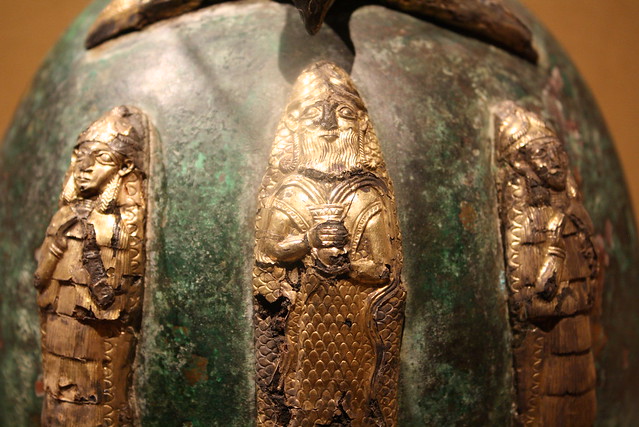


quote:I think we are getting somewhere,
Originally posted by the lioness,:
http://www.iranicaonline.org/articles/cissians-gk
CISSIANS is a name for the Susians, the Elamite inhabitants of Susiana (Strabo 15.3.2; Stephanus Byzantius, s.v. Soûsa); the Cissians were mentioned by several Greek authors, the earliest of whom was Aeschylus, who called Susa (mégʾ ástu Sousídos “the great city of Susiana”) tò Kissíōn pólisma “the town of the Cissians” (Persae 120; cf. 17).
Herodotus provided many details on the Cissians
______________________________
wikipedia:
Kassites
Herodotus was almost certainly[citation needed] referring to Kassites when he described "Asiatic Ethiopians" in the Persian army that invaded Greece in 492 BC. Herodotus was presumably[citation needed] repeating an account that had used the name "Cush", or something similar, to describe the Kassites; the similar name "Kush" was also, purely by coincidence, a name for Ethiopia. A similar confusion of Kassites with Ethiopians is evident in various ancient Greek accounts of the Trojan war hero Memnon, who was sometimes described as a "Cissian" and founder of Susa, and other times as Ethiopian. According to Herodotus, the "Asiatic Ethiopians" lived not in Cissia, but to the north, bordering on "Paricanians" who in turn bordered on the Medes. The Kassites were not geographically linked to Kushites and Ethiopians, nor is there any documentation describing them as similar in appearance, and the Kassite language is regarded as a language isolate, utterly unrelated to any language of Ethiopia or Kush/Nubia,[9] although more recently a possible relationship to the Hurro-Urartian family of Asia Minor has been proposed.[10] However, the evidence for its genetic affiliation is meager due to the scarcity of extant texts.
_______________________________________
http://www.egyptsearch.com/forums/ultimatebb.cgi?ubb=reply;f=8;t=008814;replyto=000000
Herodotus, The Persian Wars
Translated by George Rawlinson (1858–60)
Book VII
[7.70] The eastern Ethiopians -
for two nations of this name served in the army - were marshalled with the Indians.
They differed in nothing
from the other Ethiopians,
save in their language, and the character of their hair.
For the eastern Ethiopians have straight hair,
while they of Libya are more woolly-haired than any other people in the world.
![[Cool]](cool.gif)




quote:Nice post,
Originally posted by the lioness,:
http://www.iranchamber.com/history/achaemenids/achaemenid_army.php

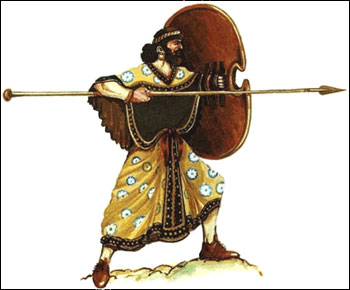
quote:Btw, I once heard the Miley Cyrus is of Iranian descent. Those Iranians who settled in Greece.
History of Iran: Achaemenid Army
Achaemenid Army
By: Professor A. Sh. Shahbazi
These life sized "Immortal Guard" in richly ornamental robes wear the twisted headband typical of native Iranians from Susa.The Achaemenian/Achaemenid Army is well known through descriptions by Herodotus, Xenophon, and Arrian as well as by illustrations on Persepolitan and Greco-Persian monuments. Of particular importance for the topic are the Greek representations of Persian warriors and the evidence of the so-called Alexander Sarcophagus from Sidon. The Persians whom Cyrus the Great united did not possess a professional army: as in days of old, the "people" of a region was represented by its backbone, the "military force," so the two words were used synonymously in one Old Persian term, kara (cognate with Lithuanian karias/karis "war, army," Gothic harjis "army," and German Heer "army,"), a sense still retained in the New Persian term kas-o kar "relatives and supporters."
At first the Achaemenid army consisted wholly of Iranian warriors, and even when other regions were subjugated, Iranian formed the nucleus of the imperial army. Darius the Great advises his successor: "If thus thou shalt think: `May I not feel fear of (any) other,' protect this Persian kara; if the Persian kara shall be protected, thereafter by the will of Ahuramazda happiness shall come down uninterruptedly and eternally upon this royal house". With the expansion of the petty kingdom of Persis into a world-empire embracing all Iranian groups from Central Asia to the Danube, a standing army was formed from Persians, Medes, and closely related peoples, and an imperial army was organized by incorporating warriors of all subject nations. Persepolitan representations, and official Persian economic and military documents ultimately used by Herodotus prove that the closer a nation was to the Persians, the more it shared in the domination of the empire by paying less tribute but contributing more soldiers. Thus, the Medes who had the second position in the empire furnished more soldiers than others and indeed many of the imperial generals were chosen from the Medes (Mazares, Harpagus, Taxmaspada, Datis, etc.). Then came the Sacians, Bactrians, Hyrcanians, and other East Iranian groups.
The general term for the professional army was spada. This consisted of infantry (pasti), cavalry (asabari "horse-borne," and occasionally usabari "camel-borne"), and charioteers (only the noblest warriors used the then obsolete but symbolic chariot), and a large number of camp followers. From the moment they met the Greeks, the Iranians incorporated subject or mercenary Greeks in their army. As the time went by, not only Iranian satraps in Asia Minor but also the King of Kings employed Greek mercenaries, each of whom received free board and a monthly wage (a gold Daric per month in 401 BCE). By the time of Alexander, these mercenaries had become a regular part of the spada and their leaders had been incorporated into Iranian aristocracy. They played a major role in Greco-Iranian cultural relations, and helped an eastward expansion of Greek culture.
The size of the imperial army was never as large as the Greeks exaggerated. Careful examination of topography, logistics, organization of the spada, and official battle orders enable historians to arrive at reasonable figures for Iranian forces. Thus, Xerxes' 3,000,000 fighting men or 2,641,610 soldiers and an equal number of attendants are reduced to 70,000 infantry and 9,000 horsemen; the 900,000-strong army of Artaxerxes II at Cunaxa was in reality no more than 40,000, and the 1,040,000 soldiers of Darius III at Gaugamela is brought down to 34,000 cavalry and some infantry. Unfortunately, historians have seldom paid attention to these overstatements, accordingly, their judgements of Iranian tactics, strategy, and motives have been impaired by faulty calculations.
The organization of the spada was based on a decimal system "far superior to anything on the Greek side" and was not employed in any Asiatic army until the Mongols. Ten men composed a company under a daθapati; ten companies made up a battalion under a θatapati; ten battalions formed a division under a hazarapati; and ten divisions comprised a corps under a *baivarapati. The whole spada was led by a supreme commander (probably spadapati, although a generalissimo with full civil authority was called karana [Greek karanos]), who was either the King of Kings himself or a trusted close relative or friend (e.g., Mazares the Mede led Cyrus the Great’s army and Datis the Mede that of Darius of the Great at Marathon). A characteristic of the Achaemenid period is that commanders and dignitaries participated in actual fighting, and many of them lost their lives in action.
The training of the Iranian nobility was arduous. As a youth, the Iranian was schooled-in companies of fifty-in running, swimming, horse grooming, tilling the land, tending the cattle, making various handicrafts, and getting accustomed to standing at watch; he would be trained in the arts of the chase (both afoot and on horseback), archery, throwing the spear and javelin, and of sustaining forced marches in unfriendly climate. At twenty he started his military profession which lasted till the age of The training of the Iranian nobility was arduous. As a youth, the Iranian was schooled-in companies of fifty-in running, swimming, horse grooming, tilling the land, tending the cattle, making various handicrafts, and getting accustomed to standing at watch; he would be trained in the arts of the chase (both afoot and on horseback), archery, throwing the spear and javelin, and of sustaining forced marches in unfriendly climate. At twenty he started his military profession which lasted till the age of fifty as a foot soldier or a rider. The elitist groups were trained for both tasks. Thus, Darius says proudly: "Trained am I both with hands and with feet. As a horseman I am a good horseman. As a bowman I am a good bowman both afoot and on horseback. As a spearman I am a good spearman both afoot and on horseback". The foot soldier carried a short sword (acinaces), a spear with wooden shaft and metal head and butt, a quiver full of arrows of reed with bronze or iron heads, and a bow about one meter long with ends formed in animals' heads, and a case which combined the bow-case and quiver-holder. A symbol of kingship and the Iranian national arm, the bow was held in the hand of the King of Kings on his tomb and coins. Battle-axe was also used, especially by North Iranians. For protection, the infantryman relied on his wicker shield (made of sticks evidently threaded through a wet sheet of leather capable of stopping arrows). The shield was either small and crescent-shaped or large and rectangular; the latter could be planted in the ground allowing the archer to discharge his arrows from behind it. Some guards carried the large "figure-of-eight" -shaped shield known as the Boeotian, while the Gandharans carried round shields not dissimilar to those of Greek hoplites. Some Iranians wore metal helmets, but only the Egyptians and the Mesopotamian contingents wore armour for body protection.
The elite infantry had variegated costumes: either the fluted hat, short cape over a shirt, pleated skirt and strapped shoes of the Elamite court dress, or the conical felt hat, tight-fitting tunic and trousers and boots of the Median cavalry suit. One division of the infantry comprised "one thousand spearmen, the noblest and bravest of the Persians" who formed a special royal guard; their spears had golden apples as butts from which they were called the Apple-bearers. As a prince, Darius served in this guard of spearmen under Cambyses. Their commander was the hazarapati of the empire, who, as the officer next to the emperor, possessed vast political power. All members of this guard fell at Plataea defending their position. One corps of the spada consisted of ten thousand elite Iranian foot soldiers, the so-called "Immortal Guard", whose "number was at no time either greater or less than 10,000". These had variegated costumes and acted as the Imperial Guards. "Of these one thousand carried spears with golden pomegranate at the lower end instead of spikes; and these encircled the other nine thousand, who bore on their spears pomegranates of silver".
The cavalry had been instrumental in conquering subject lands, and it retained its importance to the last days of the Achaemenid empire. The horseman was equipped more or less like the foot soldier; but he carried two javelins, one for throwing and one for fending-at least this was the case in Xenophon's time. Some wore metal helmets and padded linen corselets covered with metal scales. A Babylonian document dated to the second year of Darius II lists the requirements of a horseman as follows: a horse along with its girdle and bridle, a helmet, a cuirass of iron, a bronze shield, 120 arrows, a mace of iron, and two iron spears. There were also units of camel-borne troops, and some riding chariots and scythed-chariots, but these were very seldom effective against massed infantry. At Gaugamela 15 elephants were also present but their action is not recorded. Various divisions bore particular standards (Herodotus 9.59), but the imperial banner was a golden eagle with outstretched wings borne on a spear at the side of the commander-in-chief of the army.
Apart from the standing army, the rest of the levies were recruited when the need arose, and it took a long time, sometimes years, to muster a grand army. There were many Iranian garrisons in important centres of the empire, and satraps and governors also had their guards and local levies, but these could not be depleted to form an army on short notice because the danger of revolt was always present. Tribal troops, especially from East Iran, were more readily available. Levies were summoned to a recruiting station (*handaisa) where they were marshaled and reviewed. Campaigns usually started in early spring. Provisions were stored at various magazines along the route of the army, and were also brought with it in baggage-trains. Royal and religious emblems accompanied the centre of the army where the commander had his position: the eagle standard and the holy fire in portable fire-holders attended by Magi chanting hymns, and the sacred chariots of Miθra, Ahura Mazda and others. Mounted scouts were sent in advance to watch the enemy's movements. There was also an excellent system of communication: couriers on the royal road changed horses at short intervals and speedily conveyed their messages to their destinations; also by their light and mirror signals the King of Kings in Susa and Ecbatana received the news from the whole empire-it is claimed-on the same day. Fire signals communicating the news from towers and heights were widely used with good results. Fortified gates were set up in narrow passes leading into various provinces not only for custom checks but also for stopping the advance of an enemy.
The Iranians disliked night marches and did not attack at night; their daily marches were, however, in slow pace because of the heavy baggage-train which often comprised litters for conveying the wives and concubines of the commanders. When night fell, they encamped in a flat area, and if they were approaching the enemy, they dug a ditch and set up ramps of sand-bags around it. Rivers were forded by using rafts, boat-bridges, or inflated skins or simply by riding across on horses and camels.
Before the battle (hamarana), a council of war was held and plans of action discussed. The line of battle was usually drawn up as follows: the foot archers were stationed in the front, flanked by cavalry and supported by light-armed and heavier-armed infantry. The commander-in-chief occupied the centre, observing the lines and directing the actions from an elevated point, where he was best protected, and his orders were received by both wings at the same time. When the battle was joined the archers discharged their arrows, and the slingers threw their stone missiles (lead missiles with longer range became fashionable from 400 BCE, and an actual lead bullet bearing the name of Tissaphernes in Greek has survived). The aim was to throw the enemy lines into confusion. The effective range of the Persian archer was about 120 yards. Then the heavier infantry with spear and sword moved in, supported by cavalry attacking the flanks.
These tactics worked well against Asiatic armies, but failed against heavy-armed Greek infantry (hoplites) and Macedonian phalanxes: the arrows were simply stopped by the body armour and the huge shield of the hoplites, and once the hand to hand combat began, no amount of personal bravery could compensate for the Iranians' lack of armour and their inferior offensive weapons. At the battle of Plataea, for instance, a fierce hand-to-hand combat raged between the Iranians and the Greek hoplites: The Iranians "many times seized hold of the Greek spears and broke them; for in boldness and warlike spirit the Iranians were not a whit inferior to the Greeks; but they were without shields, untrained, and far below the enemy in respect of skill in arms. Sometimes singly, sometimes in bodies of ten, now fewer and now more in number, they dashed forward upon the Spartan ranks, and so perished". Another weakness of the Iranians was the attitude towards their commander: with an able and farsighted general, they displayed unsurpassed courage, but the same men took to disorderly flight as soon as the commander was killed or forced to flee. Knowing that the King of Kings was the heart of his army, Cyrus the Younger ordered Clearchus-his Greek mercenary leader-to attack the centre where the King of Kings was stationed: "and if," he said, "we are victorious there, our whole task [of defeating his army] is accomplished,".
Cyrus the Younger who knew both the Iranian and Greek armies, tactics and strategies, nearly succeeded in removing Iran's military weaknesses. He supplemented his Asiatic force with a large army of Greek hoplites, formed battalions of heavy cavalry which wore helmets. Breast-plates, and thigh-guards (this protected the sides of the horse as well), and carried a Greek sword in addition to their own arms; their horses too were protected with frontlets and breast-pieces. He made effective use of the coordination of heavy cavalry and heavy infantry-an art which later Agesilaus and especially Alexander employed to the fullest and with the best results. It must be remembered, however, that the effectiveness of the Persian shock cavalry was severely hampered by the lack of stirrup and the saddle. "Encumbered with a corslet of scale armour and poised precariously atop his steed, the horseman kept his seat only through the pressure of his knees. He will have been in serious danger of being unhorsed whenever he delivered a blow with his saber or came within reach of an enemy soldier".
The Iranians gave quarter to the adversary who requested it, and usually treated their captives with respect and kindness. Noble prisoners were accorded due honour, and princes treated royally. Even rebellious peoples were deported only to be given new lands and houses and enrolled as ordinary subjects. Personal valour was greatly esteemed, and special boons were conferred on brave servants of the empire. Records of battles were kept, detailing the course of an engagement and casualty figures. The commander-in-chief's scribe wrote down distinguished deeds of warriors: "During the whole battle Xerxes sat at the base of the hill..., and whenever he saw any of his own captains perform any worthy exploit he inquired concerning him, and the man's name was taken down by his scribe, together with the names of his father and city". In the same way Darius recorded the names of his six helpers, together with those of their fathers and nationality, adding: "Thou who shalt be king hereafter, protect well the family of these men". In 335 BCE both Athens and Thebes sought Iranian help, and the ambassadors of the latter city were received with the greatest honour at the Imperial court and their wishes were granted on the account that their forebears had rendered military assistance to Xerxes 150 years earlier.


quote:Yeah, apparently the population was differed from today's populations living in these regions, after the slaughter and slew.
Originally posted by the lioness,:
http://www.sothebys.com/en/auctions/ecatalogue/2010/antiquities-from-the-collection-of-the-late-clarence-day-n08723/lot.33.html
A NEO-ASSYRIAN GYPSUM ALABASTER RELIEF FRAGMENT, PROBABLY FROM THE NORTH PALACE OF ASHURBANIPAL AT NINEVEH, REIGN OF ASHURBANIPAL, 669-631 B.C.
SOTHEBY'S LOT SOLD. $ 290,500 USD
__________________________________________








quote:
Originally posted by the lioness,:

http://mznappytrini.blogspot.com/2011/02/natural-hair-meetup-in-iran.html
Natural Hair meetup.... in Iran
Loved this so much!
Curl's Gathering
The Gathering of people who have curly hair that took place in Mellat Park in Tehran, Iran on 21 jan 2011. The people in this gathering all had curly hair. It's a beautiful video on how simple things can bring people together for a fun time.
https://fa-ir.facebook.com/MooFerferia
https://www.facebook.com/MooFerferia/photos/a.159552797392806.41774.159544064060346/872490939432318/?type=1&theater
quote:.
Originally posted by Just call me Jari:
^^^^
Roxanne

quote:That these necessarily represent afro textured hair
Originally posted by the lioness,:
Now moving on, revisiting the question of whether or not the Lachish figures above have afro hair or curly hair


quote:You have posted these already a dozen times. Yet, you have failed to, or rather ignore the actual evidence being prompted. In which you literally make yourself look dumber than dumb. And it's actually pathetic, the lights you'll go, will you're digging a hole deeper and deeper, for yourself. Trying to pass this off as "scientific evaluation" is merely laughable.
Originally posted by the lioness,:

http://mznappytrini.blogspot.com/2011/02/natural-hair-meetup-in-iran.html
Natural Hair meetup.... in Iran
Loved this so much!
Curl's Gathering
The Gathering of people who have curly hair that took place in Mellat Park in Tehran, Iran on 21 jan 2011. The people in this gathering all had curly hair. It's a beautiful video on how simple things can bring people together for a fun time.
https://fa-ir.facebook.com/MooFerferia


quote:Royal City of Susa: Ancient Near Eastern Treasures in the Louvre
Susa was settled about 4000 B.C. and has yielded striking pottery finds from that prehistoric period.
quote:--Moshe et al.
8 Cush had a son named Nimrod, who became the world's first great conqueror. 9 By the Lord's help he was a great hunter, and that is why people say, “May the Lord make you as great a hunter as Nimrod!” 10 At first his kingdom included Babylon, Erech, and Accad, all three of them in Babylonia. 11 From that land he went to Assyria and built the cities of Nineveh, Rehoboth Ir, Calah,
12 and Resen, which is between Nineveh and the great city of Calah.
quote:--Moorjani et al.
"A potential issue that could in theory influence our findings is that the exact population contributing to African ancestry in West Eurasians is unknown. To gain insight into the African source populations, we carried out PCA analyses, which suggested that the African ancestry in West Eurasians is at least as closely related to East Africans (e.g. Hapmap3 Luhya (LWK)) as to West Africans (e.g. Nigerian Yoruba (YRI)) (the same analyses show that there is no evidence of relatedness to Chadic populations like Bulala) (Text S5 and Figure S12).
We also used the 4 Population Test to assess whether the tree ((LWK, YRI),(West Eurasian, CEU)) is consistent with the data, and found no evidence for a violation,
which is consistent with a mixture of either West African or East African ancestors or both contributing to the African ancestry in West Eurasians (Table S14; Figure S13). Historically, a mixture of West and East African ancestry is plausible, since African gene flow into West Eurasia is documented from both West Africa during Roman times [34] and from East Africa during migrations from Egypt [7]. It is important to point out, however, that the difficulty of pinpointing the exact African source population is not expected to bias our inferences about the total proportion and date of mixture. The f4 Ancestry Estimation method is unbiased even when we use a poor surrogates for the true ancestral African population (as long as the phylogeny is correct), as we confirmed by repeating analyses replacing YRI with LWK, and obtaining similar results (Table S15).Our ROLLOFF admixture date estimates are also similar whether we use LWK or YRI to represent ancestral African population (Table S15), as predicted by the theory.
quote:-- (Ehret 1995; Ehret et al. 2004; Blench 2006).
"These results indicate that the ancestor of all Semitic languages in our dataset was being spoken in the Near East no earlier than approximately 7400 YBP, after having after having diverged from Afroasiatic in Africa"
(i) Semitic had an Early Bronze Age origin (approx. 5750 YBP) in the Levant, followed by an expansion of Akkadian into Mesopotamia;
(ii) Central and South Semitic diverged earlier than previously thought throughout the Levant during the Early to Middle Bronze Age transition; and
(iii) Ethiosemitic arose as the result of a single, possibly pre-Aksumite, introduction of a lineage from southern Arabia to the Horn of Africa approximately 2800 YBP.


quote:In fact it was the link by the lioness, which I laid out here.but it's good your informing people on this. I don't know in what you based that he is Turkish, but could it be because of Uralic?
Originally posted by Mike111:
Trollkillah # Ish Gebor - Surely you must know that the man quoted above:
History of Iran: Achaemenid Army
Achaemenid Army
By: Professor A. Sh. Shahbazi
Is nothing but another stupid, lying, Turk mulatto whom the academic world ignores.
Hint: the word "Iranian" that he uses so often, had no meaning until 1935.
In 1935 the Iranian government requested those countries with which it had diplomatic relations, to call Persia "Iran". The suggestion for the change is said to have come from the Iranian ambassador to Germany, who came under the influence of the Nazis. At the time Germany was in the grip of racial fever and cultivated good relations with nations of "Arian" blood. It is said that some German friends of the ambassador persuaded him that, as with the advent of Reza Shah, Persia had turned a new leaf in its history. It was only fitting that the country be called "Iran." This would not only signal a new beginning, and bring home to the world, the new era in history, but would also signify the NOW Arian race of its population, as "Iran" is a cognate of "Arian"/Aryan and derived from it.

quote:Some sources mention the bust as being of an Achaemenid woman.
Originally posted by Swenet:
quote:That these necessarily represent afro textured hair
Originally posted by the lioness,:
Now moving on, revisiting the question of whether or not the Lachish figures above have afro hair or curly hair
can be easily falsified by the existence of Assyrian
figures with decimated short-cropped hair, whose
hair looks grossly no different from these Lachish
figures (see the Assyrian[?] figure in the middle,
below).
It goes without saying, but with no proper controls
in place (i.e. showing that short-cropped Assyrian
hair was NOT like the Lachish hairdos) one has no
way of ascertaining whether or not the Lachish folks
were depicted as having afro textured hair.
In the side-view it's clear that the curls only
appear in the cross section of each hair strand
(as with the Assyrian beards and scalp hair strands).
Along their length, the hair strands are straight,
as shown by the cylindrical tube-like shapes of
the individual hair strands.


quote:yes, I agree
Originally posted by Swenet:
It goes without saying, but with no proper controls
in place (i.e. showing that short-cropped Assyrian
hair was NOT like the Lachish hairdos) one has no
way of ascertaining whether or not the Lachish folks
were depicted as having afro textured hair.
quote:What is unbelievable is that you'll post in a snap how "multiple back to Africa migrations" have taken place, and how Eurasians entered Africa, spread "all over Africa", yet with no evidence to back it up.
Originally posted by the lioness,:
It's unbelievable how when people had posted photos of African Americans suggesting similarity to ancient Mesopotamians nobody had a problem.
Yet when actual Iranian people are posted with similar hair, it's a problem
quote:Sure, now all of as sudden you'll claim it's not Afro-texture hair.
Originally posted by the lioness,:

quote:yes, I agree
Originally posted by Swenet:
It goes without saying, but with no proper controls
in place (i.e. showing that short-cropped Assyrian
hair was NOT like the Lachish hairdos) one has no
way of ascertaining whether or not the Lachish folks
were depicted as having afro textured hair.
quote:As told before neo-Assyria and Assyrians had several ethnic groups and populations. So, keep ignoring the obvious and rather come up with multiple choice BS questions. From the image I likely know what hair texture the Assyrian had, when I'll find a picture of some one with similar hair texture, I'll post it.
Originally posted by the lioness,:
Above, an Assyrian conqueror and Judaens captured in 701 BC in the town of Lachish in Israel
We see that the portion on the Assyrian's hair marked "A" is the exact same texture as the Judaen's hair
which of the below statements is true ??
1) The Assyrian had woolly hair. It's marked "A"
The portion marked "B" has been artificially straightened
2) The Assyrian had straight hair with a slight wave. It's marked "B"
The portion marked "A" and his beard have been artificially curled
to look like woolly hair
3) The Assyrian had curly hair marked "A" It was not originally woolly, just curly.
The portion marked "B" has been artificially straightened
4) The Assyrian had straight hair with a slight wave. It's marked "B"
The portion marked "A" and his beard have been artificially curled
to look like curly hair but not curly hair which was originally woolly

quote:~Harper, Prudence O., Joan Aruz, and Françoise Tallon, eds. (1992)
Susa was settled about 4000 B.C. and has yielded striking pottery finds from that prehistoric period.
quote:~Moshe et al.
8 Cush had a son named Nimrod, who became the world's first great conqueror. 9 By the Lord's help he was a great hunter, and that is why people say, “May the Lord make you as great a hunter as Nimrod!” 10 At first his kingdom included Babylon, Erech, and Accad, all three of them in Babylonia. 11 From that land he went to Assyria and built the cities of Nineveh, Rehoboth Ir, Calah,
12 and Resen, which is between Nineveh and the great city of Calah.
quote:~Moorjani et al.
"A potential issue that could in theory influence our findings is that the exact population contributing to African ancestry in West Eurasians is unknown. To gain insight into the African source populations, we carried out PCA analyses, which suggested that the African ancestry in West Eurasians is at least as closely related to East Africans (e.g. Hapmap3 Luhya (LWK)) as to West Africans (e.g. Nigerian Yoruba (YRI)) (the same analyses show that there is no evidence of relatedness to Chadic populations like Bulala) (Text S5 and Figure S12).
We also used the 4 Population Test to assess whether the tree ((LWK, YRI),(West Eurasian, CEU)) is consistent with the data, and found no evidence for a violation,
which is consistent with a mixture of either West African or East African ancestors or both contributing to the African ancestry in West Eurasians (Table S14; Figure S13). Historically, a mixture of West and East African ancestry is plausible, since African gene flow into West Eurasia is documented from both West Africa during Roman times [34] and from East Africa during migrations from Egypt [7]. It is important to point out, however, that the difficulty of pinpointing the exact African source population is not expected to bias our inferences about the total proportion and date of mixture. The f4 Ancestry Estimation method is unbiased even when we use a poor surrogates for the true ancestral African population (as long as the phylogeny is correct), as we confirmed by repeating analyses replacing YRI with LWK, and obtaining similar results (Table S15).Our ROLLOFF admixture date estimates are also similar whether we use LWK or YRI to represent ancestral African population (Table S15), as predicted by the theory.
quote:~Andrew Kitchen, Christopher Ehret2, Shiferaw Assefa2 and Connie J. Mulligan
Our statistical tests of alternative Semitic histories support an initial divergence of Akkadian from ancestral Semitic over competing hypotheses (e.g. an African origin of Semitic). We estimate an Early Bronze Age origin for Semitic approximately 5750 years ago in the Levant, and further propose that contemporary Ethiosemitic languages of Africa reflect a single introduction of early Ethiosemitic from southern Arabia approximately 2800 years ago.
[…]
Semitic languages (Akkadian, Aramaic, Ge'ez, ancient Hebrew and Ugaritic) combined with archaeological evidence for the sampling dates of the epigraphic data (the time at which the materials were inscribed).

"These results indicate that the ancestor of all Semitic languages in our dataset was being spoken in the Near East no earlier than approximately 7400 YBP, after having after having diverged from Afroasiatic in Africa"
(i) Semitic had an Early Bronze Age origin (approx. 5750 YBP) in the Levant, followed by an expansion of Akkadian into Mesopotamia;
(ii) Central and South Semitic diverged earlier than previously thought throughout the Levant during the Early to Middle Bronze Age transition; and
(iii) Ethiosemitic arose as the result of a single, possibly pre-Aksumite, introduction of a lineage from southern Arabia to the Horn of Africa approximately 2800 YBP.






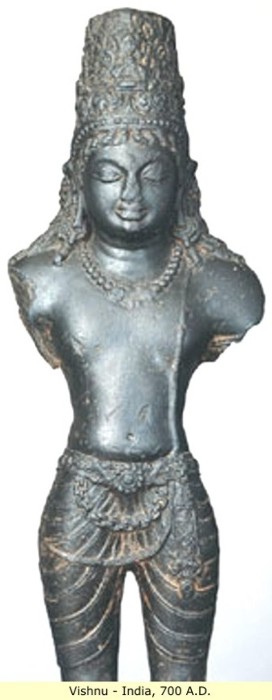
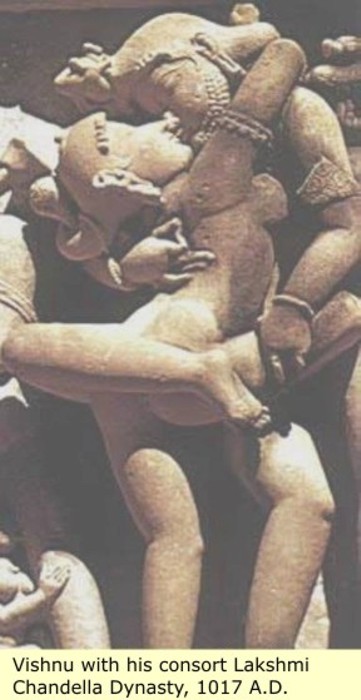
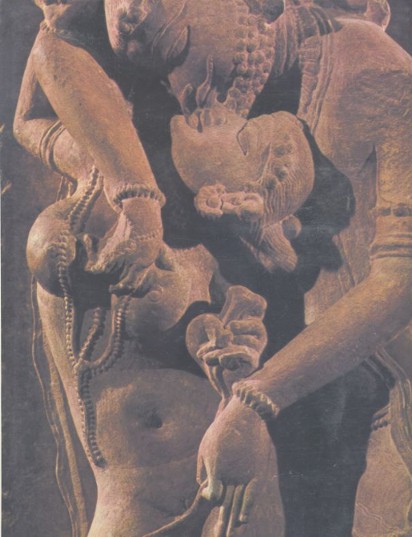
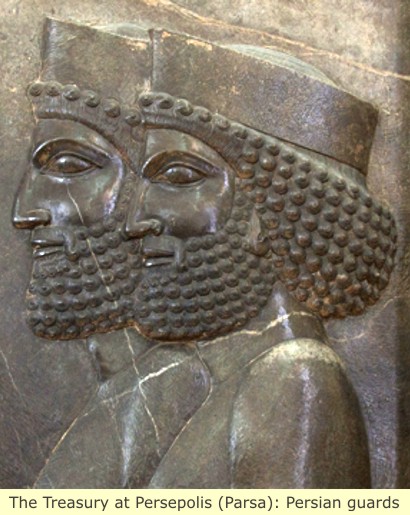
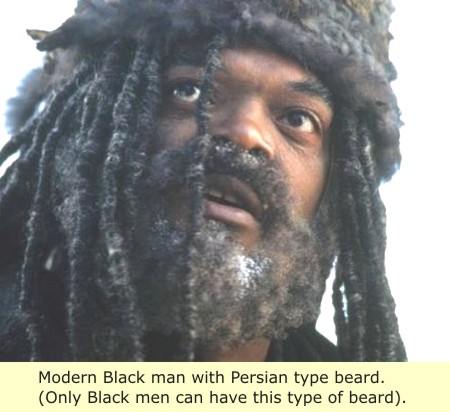
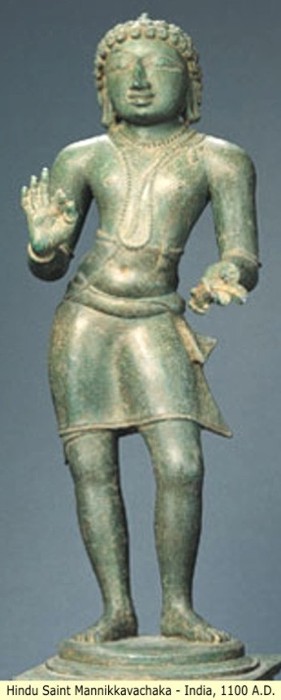

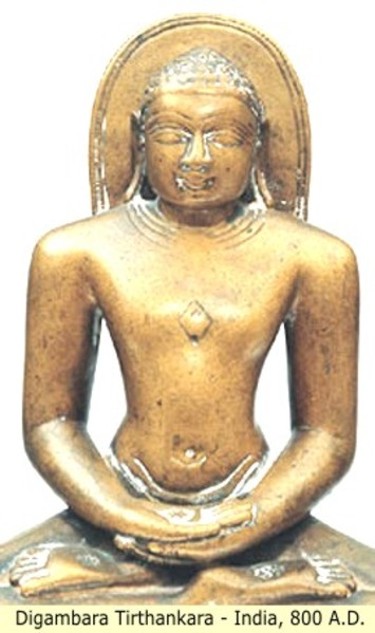

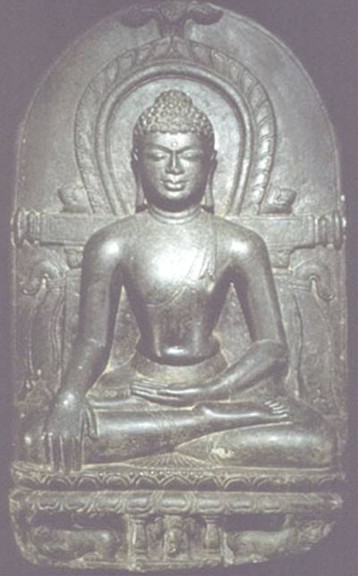

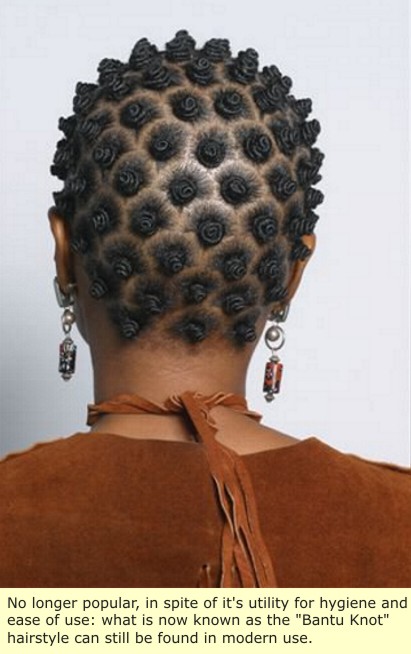
quote:
Originally posted by the lioness,:


quote:~Moorjani et al.
In summary, we have documented a contribution of sub-Saharan African genetic material to many West Eurasian populations in the last few thousand years. A priority for future work should be to identify the source populations for this admixture. [...]
Source of African ancestry in West Eurasians may include some East African ancestors. In order to identify the source of the African ancestry in Levantines, Southern Europeans and Jews, we performed PCA Projection with all three possible pairs of African populations (Bulala, Kenyan Luhya (LWK) and Yoruba (YRI)) along with HapMap Chinese (CHB), and then plotted the mean values of all the samples from each West Eurasian population, African Americans (ASW) and North African (Mozabites) onto the first PC and second PC. These admixed West Eurasian populations align along a gradient that points more at (a) YRI than Bulala, and (b) LWK than Bulala suggesting little evidence for Chadic ancestry in West Eurasians, (c) The PCA suggests more relatedness to LWK than to YRI, suggesting that there may be some East African related ancestry in these West Eurasian populations.

quote:
Originally posted by zarahan- aka Enrique Cardova 31 December, 2012 :
quote:
"A striking finding from our study is the consistent detection of
3–5% sub-Saharan African ancestry in the 8 diverse Jewish groups
we studied,
* Ashkenazis (from northern Europe),
* Sephardis (from Italy, Turkey and Greece), and
* Mizrahis (from Syria, Iran and Iraq).
This pattern has not been detected in previous analyses of
mitochondrial DNA and Y chromosome data [7], and although it
can be seen when re-examining published results of STRUCTURE-
like analyses of autosomal data, it was not highlighted in
those studies, or shown to unambiguously reflect sub-Saharan
African admixture [15,38]. We estimate that the average date of
the mixture of 72 generations (~2,000 years assuming 29 years per
generation [30]) is older than that in Southern Europeans or other
Levantines.
The point estimates over all 8 populations are between
1,600–3,400 years ago, but with largely overlapping confidence
intervals. It is intriguing that the Mizrahi Irani and Iraqi Jews—
who are thought to descend at least in part from Jews who were
exiled to Babylon about 2,600 years ago [39,40]—share the signal
of African admixture. (An important caveat is that there is
significant heterogeneity in the dates of African mixture in various
Jewish populations.) A parsimonious explanation for these
observations is that they reflect a history in which many of the
Jewish groups descend from a common ancestral population which
was itself admixed with Africans, prior to the beginning of the
Jewish diaspora that occurred in 8th to 6th century BC [41]."
--Moorjani 2011
^^Indeed. This debunks the claim that there was no sub-Saharan gene
flow into Palestine/Middle East during Biblical times.
"Here, we apply genomic methods to show that the proportion of African ancestry in
many Southern European groups is 1%–3%, in Middle Eastern groups is 4%–15%, and in\
Jewish groups is 3%–5%. "
--Moorjani
^^It would be more accurate to say that the proportion of African ancestry being
referred to is primarily WEST AFRICAN ancestry, specifically centered on the Yorbua.
But the Yorbua are not the only "sub Saharan" group of Africans. Peoples of Ethiopia
and Somalia and large parts of Chad and the Sudan are located below the Sahara
and are thus "sub-Saharan" Africans. Studies using them to trace gene flow into
Europe or the Middle East are just as valid as using West African Yorbua.
SOme racists in Hitler's time did charge Jews with having the blood
of "inferior stocks", specifically "negro blood." Well their latter day racist
"aryan" brethren could no doubt claim a link of Jews with said "negro blood"
and cite the above as "proof."
“[Nazi] Lectures, films, and history books taught these
girls about a political and biological danger posed by
Jews.. All told, there was "racial degeneration" during
the Republic, resulting from the presence and dominance of
Jews. Since his time in Palestine, the Jew was
said to have absorbed Negro blood and to have a
particular affinity to those French colonial
Negroes.."
--Michael Kater 2006 Hitler Youth, pg 100
"In his Foundations of the Nineteenth Century (1899) .. Houston
Chamberlain classified Jews as "a mongrel race, which
always retains this mongrel character." For Chamberlain,
who was also admired by Hitler, the most recent
“hybridization” of the Jews was the “admixture of
Negro blood with Jewish in the Diaspora of Alexandria—
of which many a man of Jewish persuasion at this
day offers living proof" (CHamberlain as cited in Gilman 1986,7).
--Baum and Samuels, 2011. Antisemitism Explained. p 19
Dienekes said:
Another idea is to see whether frequency differences between A and B are correlated with frequency differences between Sub-Saharans and another Eurasian population unrelated to either A or B. Differences between Caucasoids and Sub-Saharans are (in part) due to divergence between Sub-Saharans and ancestral Eurasians. Suppose, for example, that we've identified a group (e.g., Papuans) unlikely to have admixed with Caucasoids. If B differs from A (over many markers) in the same direction that Sub-Saharans differ from Papuans, this is consistent with the notion that B has some Sub-Saharan admixture that A lacks. This is the basis of the 4-population test.
Note that because of symmetry, a highly negative value in their 4-population test (x, CEU, Papuan, YRI) indicates Sub-Saharan admixture, while a highly positive one would indicate "Papuan" admixture! The authors do observe positive values, suggesting that some northern European populations are Papuan-shifted even with respect to CEU, most notably Russia with a Z-score of 11.4. Thankfully, we are spared a paper on Papuan admixture in Russia.
^^Irrelevant. The study did not focus on Papuans but Africans. The comparison
falls flat and does not change the fact of the African admixture. And a positive
shift would not at all have anything to do with a direct "Papuan admix" towards
Europeans, but rather a signal towards Asian genetic elements. Europeans, depending
on the measure used, signal genetically more towards Asians as Cavalli Sforza and
others show, in terms of being a hybrid population.
Dienkes says:
Much more can be said, but let's summarize: the model of Moorjani et al. (2011) fails because:
1 It does not account for the West-East Eurasian axis, folding everything onto the North European-Sub-Saharan African one
2 It undersamples African diversity by excluding both North African and East African populations
Perhaps I'll add more in the future, but I believe I've already said enough to cast serious doubt on this paper'
^^Wrong. It did not have to account for any West-East axis. The study question relates to
the level of African admixture in different European and Middle Eastern populations,
and samples Palestinians, Jews, Mediterranean's (like Italians and Spaniards) and
Swiss-French. The study is not concerned with distant East Eurasians like Chinese
and does not need to sample them to be valid. Far from failing, the study is confirmed
by others that show clear African gene flow into Europe and the Middle East from ancient
times.
And sure it undersamples African diversity, but that does not change the fact of the
African admixture which cannot be airbrushed away.
DIenkes has "serious doubts" because it shows his beloved "Caucasoids" to
be "mixed" - using classical race schema he subscribes to- a hybrid population
as also shown by Cavalli-Sforza previously. Moorjani has not "failed" in showing
the presence of admixture.


quote:
Originally posted by Tukuler:
I've always wondered why ES drummed up the statement
because to me the statement makes no sense at all.
It isn't rooted in time and its scientific basis is undiscernable.
quote:^^Indeed. This debunks the claim that there was no sub-Saharan gene
The point estimates over all 8 populations are between
1,600–3,400 years ago, but with largely overlapping confidence
intervals. It is intriguing that the Mizrahi Irani and Iraqi Jews—
who are thought to descend at least in part from Jews who were
exiled to Babylon about 2,600 years ago [39,40]—share the signal
of African admixture. (An important caveat is that there is
significant heterogeneity in the dates of African mixture in various
Jewish populations.) A parsimonious explanation for these
observations is that they reflect a history in which many of the
Jewish groups descend from a common ancestral population which
was itself admixed with Africans, prior to the beginning of the
Jewish diaspora that occurred in 8th to 6th century BC [41]."
--Moorjani 2011
quote:You're welcome, unfortunately these authors didn't que-in outgoing stems such as the Natufians in the Levant or Africans Europe entered via the Iberia.
Originally posted by the lioness,:
http://genetics.med.harvard.edu/reich/Reich_Lab/Welcome_files/2011Moorjani_PLOS.pdf
Discussion
The finding of African ancestry in Southern Europe dating to ~55 generations ago, or ~1,600 years ago assuming 29 years per generation [30], needs to be placed in historical context. The historical record documents multiple interactions of African and European populations over this period. One potential opportunity for African gene flow was during the period of Roman occupation of North Africa that lasted until the early 5th century AD, and indeed tomb inscriptions and literary references suggest that trade relations continued even after that time [31], [32]. North Africa was also a supplier of goods and products such as wine and olive oil to Italy, Spain and Gaul from 200–600 AD, and Morocco was a major manufacturer of the processed fish sauce condiment, garum, which was imported by Romans [33]. In addition, there was slave trading across the western Sahara during Roman times [7], [34]. Another potential source of some of the African ancestry, especially in Spain and Portugal, is the invasion of Iberia by Moorish armies after 711 AD [35], [36]. If the Moors already had some African ancestry when they arrived in Southern Europe, and then admixed with Iberians, we would expect the admixture date to be older than the date of the invasion, as we observe.
The signal of African mixture that we detect in Levantines (Bedouins, Palestinians and Druze) – an average of 32 generations or ~1000 years ago – is more recent than the signal in Europeans, which might be related to the migrations between North Africa and Middle East that have occurred over the last thousand years, and the proximity of Levantine groups geographically to Africa. Syria and Palestine were under Egyptian political control until the 16th century AD when they were conquered by the Ottoman Empire. This is in concordance with our proposed dates. In addition, the Arab slave trade is responsible for the movement of large numbers of people from Africa across the Red Sea to Arabia from 650 to 1900 AD and probably even prior to the Islamic times [7], [37]. We caution that our sampling of the Middle East is sparse, and it will be of interest to study African ancestry in additional groups from this region
Introduction
The history of human migrations from Africa into West Eurasia is only partially understood. Archaeological and genetic evidence indicate that anatomically modern humans arrived in Europe from an African source at least 45,000 years ago, following the initial dispersal out of Africa [1], [2]. However, it is known that Southern Europeans and Levantines (people from modern day Palestine, Israel, Syria and Jordan) have also inherited genetic material of African origin due to subsequent migrations. One line of evidence comes from Y-chromosome [3] and mitochondrial DNA analyses [4]–[6]. These have identified haplogroups that are characteristic of sub-Saharan Africans in Southern Europeans and Levantines but not in Northern Europeans [7]. Auton et al. [8] presented nuclear genome-based evidence for sharing of sub-Saharan African ancestry in some West Eurasians, by identifying a North-South gradient of haplotype sharing between Europeans and sub-Saharan Africans, with the highest proportion of haplotype sharing observed in south/southwestern Europe. However, none of these studies used genome-wide data to estimate the proportion of African ancestry in West Eurasians, or the date(s) of mixture. Throughout this report, we use “African mixture” to refer to gene flow into West Eurasians since the divergence of the latter from East Asians; thus, we are not referring to the much older dispersal out of Africa ~45,000 years ago but instead to migrations that have occurred since that time.
special thanks to Trollkillah for the article
![[Big Grin]](biggrin.gif)
quote:POST-NATUFIAN, dude, POST-NATUFIAN.
Originally posted by the lioness,:
The Natufian culture existed from 13,000
to 9,500-9,800 B.C.
quote:I agree, there is and was no protest by black academics. There need to be more in the field. And yes, I do see that lioness is holding on to Eurocentric fantasies.
Originally posted by Mike111:
Trollkillah # Ish Gebor, you disappoint me: lioness is but a degenerate nobody, desperately trying to hold onto an Albino fantasy.
Please peruse the source study linked below, and take careful note of the various Albino institutions of great renown, involved in the study.
There is no letup, they are still trying to bury you!
BTW - Did you notice the nonsensical assumptions of the study? Where is the protest of Black academics? The Albino people are still free to say whatever they like, identify things and people as they wish, and there is still no organized truth-telling. Oddly enough, I was just looking at middle eastern artwork where they shamelessly do the same thing, note my new thread.
http://genetics.med.harvard.edu/reich/Reich_Lab/Welcome_files/2011Moorjani_PLOS.pdf
quote:You're not taking into account that different peoples often portray themselves differently (in terms of body proportions etc). Since the Egyptians were Africans, I don't see why they wouldn't have been able to grow beards. Why shouldn't they?
Originally posted by the lioness,:
quote:You mean to tell be these short legged Israelites and Assyrians
Originally posted by Snakepit1:
quote:Different haircut & different style of clothing. Remember that they EASILY passed for Egyptian when they wore Egyptian attire, as scripture states when Joseph passed for one (his brothers didn't recognize him, remember?) , Moses passed for one (being brought up by Egyptians, and being mistaken for one in Midian) and the whole congregation of Israel & Egyptians were described as being Egyptian when they went up to Jordan to bury Jacob.
Originally posted by the lioness,:
these short legged bearded people don't resemble Egyptians
They looked virtually indistinguishably from one another, phenotypically speaking. The Levitical laws are a testament to this (yellow/blonde-limp hair & white skin being equated to a curse/plague (leprosy) ) fact also.
There's no use discussing the phenotypical appearance to any of the indigenous peoples of North East Africa (which is what Arabia/Levant/Mesopotamia really is) .
Figure 1.--This Assyrian carving at Lachish shows Hebrews being led into exile by Sargon's son Sennacherib after Hezekiah's failed revolot (701 BC).

Assyrirans with Hebrew cpatives

look like Egyptians
SETI I, at
Abydos
RAMESSES II, Karnak

RAMESSES II, Karnak
^^^ look at how long and thin they are compared to the short stubby Assyrians and Hebrews who look similar
and the Assyrians and some of the Hebrews had big full curly beards that I'm not even sure the ancient Egyptians could grow
(assuming the Lacish art is realistically accuurate, it may not be)
quote:A relief isn't a picture and wasn't meant to be totally realistic.
Originally posted by the lioness,:
[QB] [IMG]




quote:--Avshalom Zoossmann-Diskin1,2,3 et al.
"The origin of Eastern European Jews revealed by autosomal, sex chromosomal and mtDNA polymorphisms"
The origin of Eastern European Jews, (EEJ) by far the largest and most important Ashkenazi population, and their affinities to other Jewish and European populations are still not resolved.
Studies that compared them by genetic distance analysis of autosomal markers to European Mediterranean populations revealed that they are closer to Europeans than to other Jewish populations [1-3].
In contrast, according to the Y-chromosomal haplogroups EEJ are closest to the non-Jewish populations of the Eastern Mediterranean (table 3, figure 4).
"EEJ are the largest and most investigated Jewish community, yet their history as Franco-German Jewry is known to us only since their appearance in the 9th century, and their subsequent migration a few hundred years later to Eastern Europe [4,5]. Where did these Jews come from? It seems that they came to Germany and France from Italy [5-8].
It is also possible that some Jews migrated northward from the Italian colonies on the northern shore of the Black Sea [9]. All these Jews are likely the descendents of proselytes.
Conversion to Judaism was common in Rome in the first centuries BC and AD. Judaism gained many followers among all ranks of Roman Society [10-13]."
The autosomal genetic distance analysis presented here clearly demonstrates that the investigated Jewish populations do not share a common origin.
The resemblance of EEJ to Italians and other European populations portrays them as an autochthonous European population.
**The demographic histories of three Jewish populations exemplify how different demographic patterns make the uniparental markers more reliable for Iraqi (Babylonian) Jews and Yemenite Jews and less reliable for EEJ. Both Yemenite Jews and Iraqi Jews resemble populations from their regions of origin according to autosomal markers [1,3,30-32].
**Babylonian Jews numbered more than a million in the first century AD [35], and constituted the majority of the population in the area between the Euphrates and the Tigris in the 2nd-3rd centuries AD [36]. Gilbert [37] estimates that by 600 AD there were 806,000 Jews in Mesopotamia, and according to Sassoon [38] it was inhabited by about a million Jews in the 7th century. In the 14th century the estimates for Baghdad alone range from 70,000 to hundreds thousands [38].
*By comparing the structure of the STRs network among the various Ashkenazi populations and among the various European non-Jewish populations they reached the conclusion that a single male founder introduced this haplogroup into Ashkenazi Jews in the first millennium.
quote:http://www.msnbc.msn.com/id/10827385/ns/technology_and_science-science/
Millions of Jews traced to four women
Study identifies genetic signatures for 3.5 million Ashkenazi Jews
NEW YORK — About 3.5 million of today’s Ashkenazi Jews — 40 percent of the total Ashkenazi population — are descended from just four women, a genetic study indicates.
Those women apparently lived somewhere in Europe within the last 2,000 years, but not necessarily in the same place or even the same century, said lead author Dr. Doron Behar of the Rambam Medical Center in Haifa, Israel.
He did the work with Karl Skorecki of the Technion-Israel Institute of Technology and others.
Each woman left a genetic signature that shows up in their descendants today, he and colleagues say in a report published online by the American Journal of Human Genetics. Together, their four signatures appear in about 40 percent of Ashkenazi Jews, while being virtually absent in non-Jews and found only rarely in Jews of non-Ashkenazi origin, the researchers said.
They said the total Ashkenazi population is estimated at around 8 million people. The estimated world Jewish population is about 13 million.
Ashkenazi Jews are a group with mainly central and eastern European ancestry. Ultimately, though, they can be traced back to Jews who migrated from Israel to Italy in the first and second centuries, Behar said. Eventually this group moved to Eastern Europe in the 12th and 13th centuries and expanded greatly, reaching about 10 million just before World War II, he said.
Maternal lineages traced
The study involved mitochondrial DNA, called mtDNA, which is passed only through the mother. A woman can pass her mtDNA to grandchildren only by having daughters. So mtDNA is “the perfect tool to trace maternal lineages,” Behar said Thursday in a telephone interview.
His study involved analyzing mtDNA from more than 11,000 samples representing 67 populations.
Mike Hammer, who does similar research at the University of Arizona, said he found the work tracing back to just four ancestors “quite plausible ... I think they’ve done a really good job of tackling this question.”
But he said it’s not clear the women lived in Europe.
“They may have existed in the Near East,” Hammer said. “We don’t know exactly where the four women were, but their descendants left a legacy in the population today, whereas ... other women’s descendants did not.”
Behar said the four women he referred to did inherit their genetic signatures from female ancestors who lived in the Near East. But he said he preferred to focus on these later European descendants because they were at the root of the Ashkenazi population explosion.
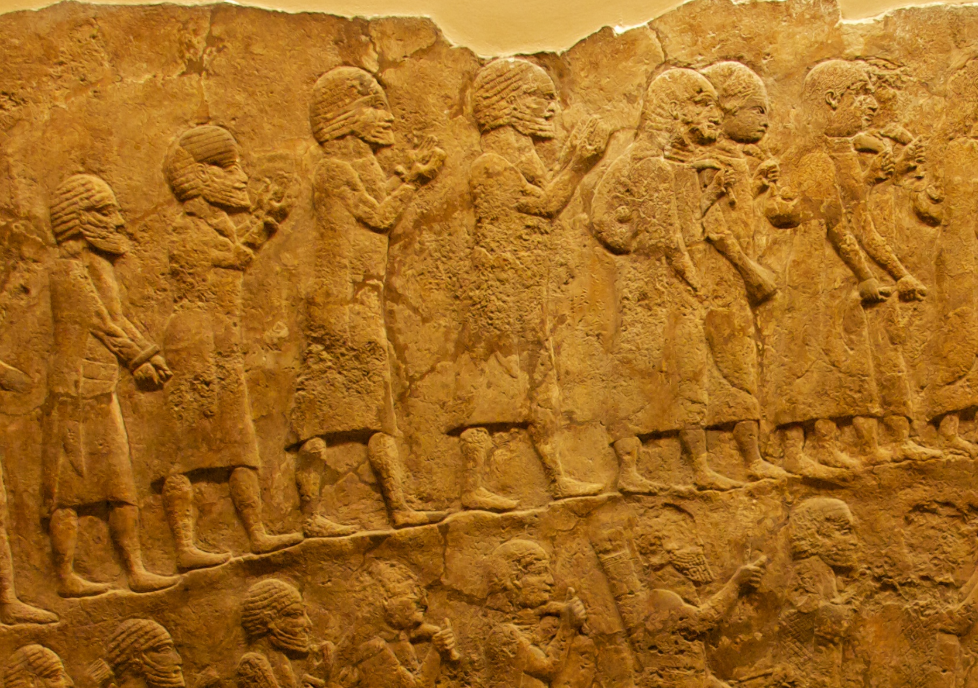

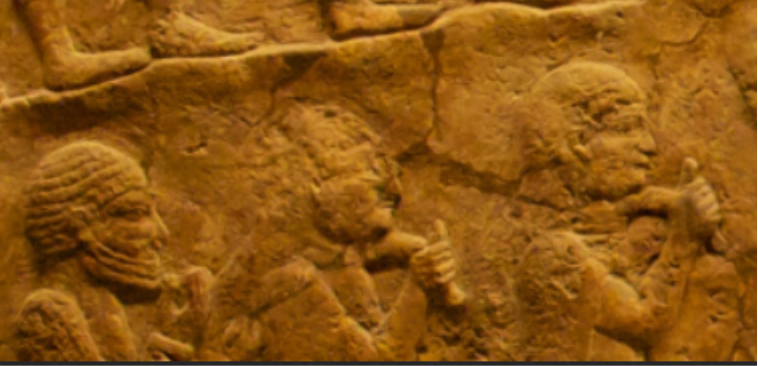
quote:Differences in detail lead to supposing the individuals are actually from Ukku.
The prisoners, who have probably been captured during one of Sennacherib's campaigns in Iran or eastern Turkey,
quote:
Originally posted on p3 of this thread by Tukuler:
More Lachish Jewish women with their woolly haired husbands?
zoom
Ah, or is it people of a city called Ukku?
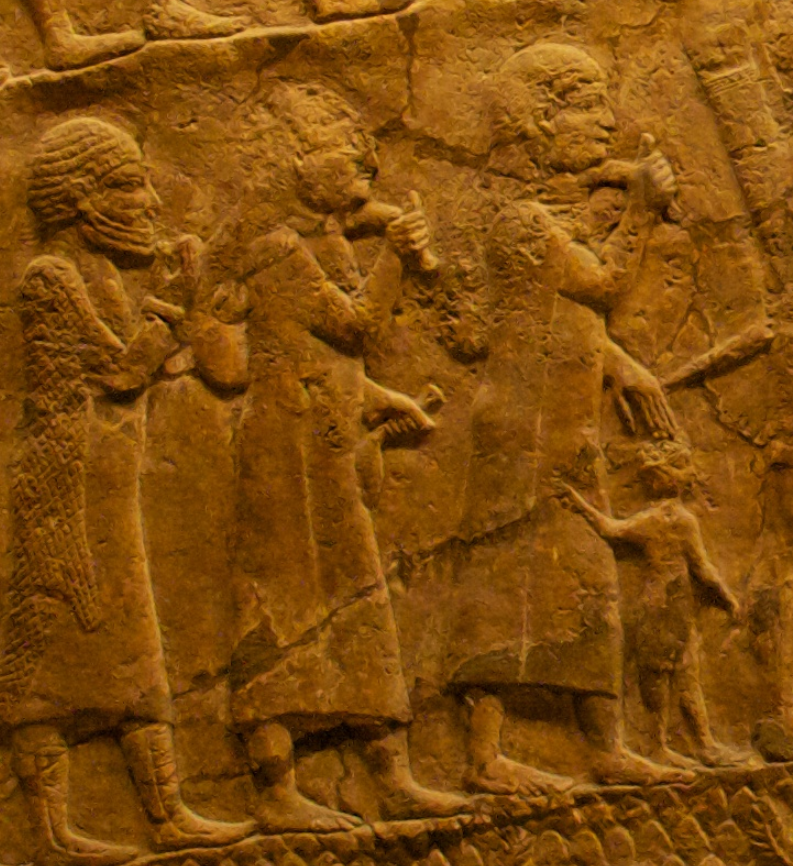
quote:You've got jokes, terrible jokes.
Originally posted by real expert:
A relief isn't a picture and wasn't meant to be totally realistic.
Here an Ashkenazi Jew Johanathan looking similar like these captives in the assyrian relief.

Here very like enslaved Hebrews with different hairstyle on an Assyrian relief. Some of them wear the same headdress and clothing like the captured Hebrews in the Lachish relief.



quote:~Cornelius Tacitus (AD 55 - 117), The Histories by Cornelius Tacitus.
Many assure us that the Jews are descended from those Ethiopians who were driven by fear and hatred to emigrate from their home country when Cepheus was king. There are some who say that a motley collection of landless Assyrians occupied a part of Egypt, and then built cities of their own, inhabiting the lands of the Hebrews and the nearer parts of Syria. Others again find a famous ancestry for the Jews in the Solymi who are mentioned with respect in the epics of Homer: this tribe is supposed to have founded Jerusalem (4) and named it after themselves.
quote:~Fernández, E. et al., MtDNA analysis of ancient samples from Castellón (Spain): Diachronic variation and genetic relationships, International Congress Series, vol. 1288 (April 2006), pp. 127-129.
“Haplogroup L2a1 was found in two specimens from the Southern Levant Pre-Pottery Neolithic B site at Tell Halula, Syria, dating from the period between ca. 9600 and ca. 8000 BP or 7500-6000 BCE”
quote:https://www.britannica.com/place/Jericho-West-Bank
Jericho, Arabic Arīḥā, town located in the West Bank. Jericho is one of the earliest continuous settlements in the world, dating perhaps from about 9000 BCE. Archaeological excavations have demonstrated Jericho’s lengthy history.
quote:~Jones, E. R., G. Gonzalez-Fortes, S. Connell, V. Siska, A. Eriksson, R. Martiniano, R. L. McLaughlin, et al. 2015.
“Populations for which the ancient Caucasus genomes are best ancestral approximations include those of the Southern Caucasus and interestingly, South and Central Asia. Western Europe tends to be a mix of early farmers and western/eastern hunter-gatherers while Middle Eastern genomes are described as a mix of early farmers and Africans.
[…]
Caucasus hunter-gatherer contribution to subsequent populations. We next explored the extent to which Bichon and CHG contributed to contemporary populations using outgroup f3(African; modern, ancient) statistics, which measure the shared genetic history between an ancient genome and a modern population since they diverged from an African outgroup.
Discussion
Given their geographic origin, it seems likely that CHG and EF are the descendants of early colonists from Africa who stopped south of the Caucasus, in an area stretching south to the Levant and possibly east towards Central and South Asia. WHG, on the other hand, are likely the descendants of a wave that expanded further into Europe. The separation of these populations is one that stretches back before the Holocene, as indicated by local continuity through the Late Palaeolithic/Mesolithic boundary and deep coalescence estimates, which date to around the LGM and earlier.”
quote:They made no exceptions, many children can be seen. Btw, can you show an entire white/ European population looking like the Lachish males with Afro-textured hair, who are being persecuted? I ask so, considering the fact that you posted the individual Richard Simmons a few years back as a proximity for the Lachish. And how does it register with this?
Originally posted by the lioness,:
with child here

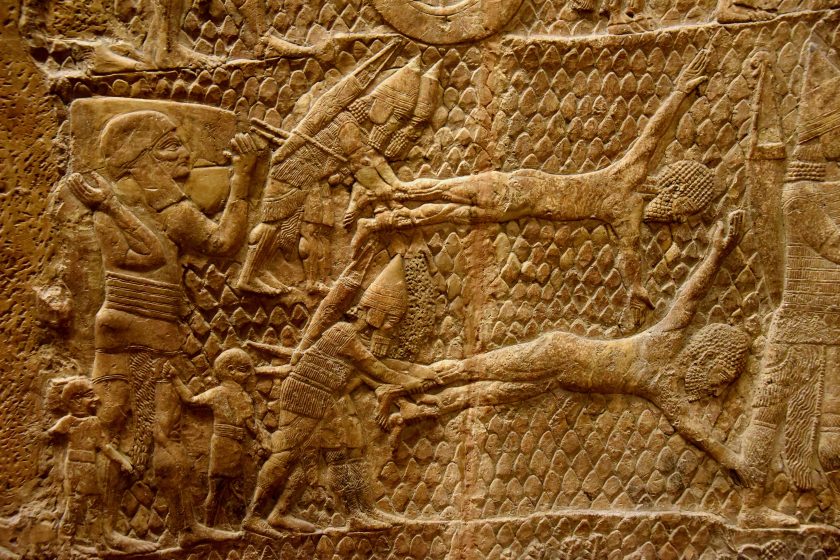
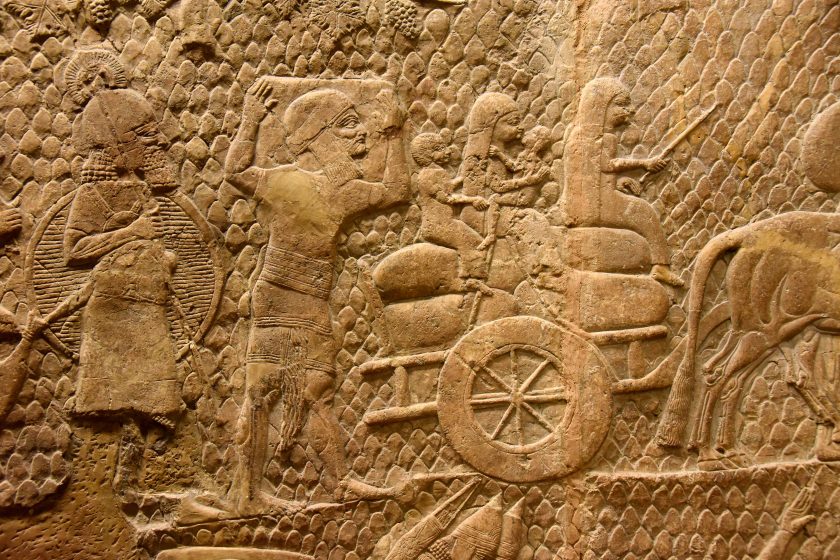
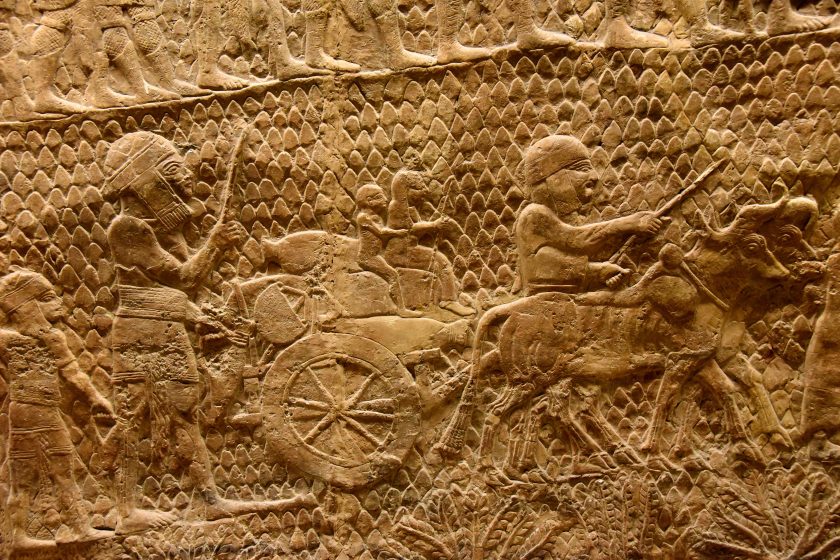
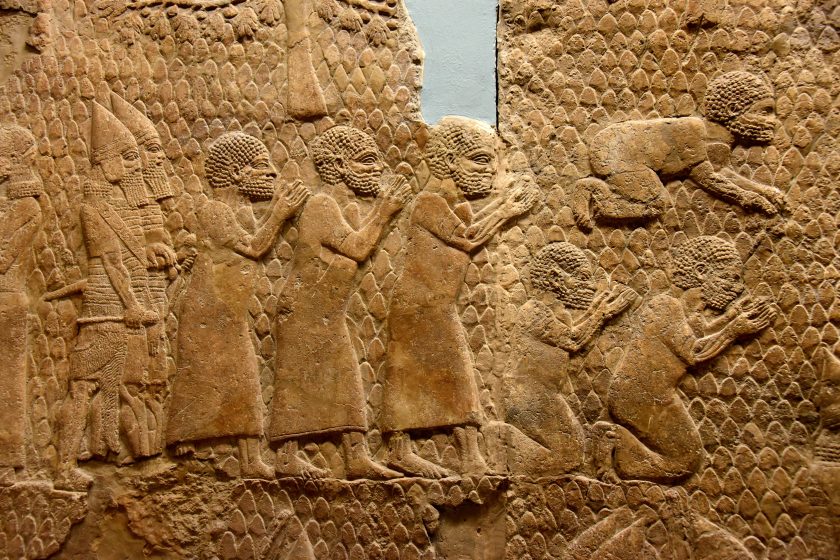
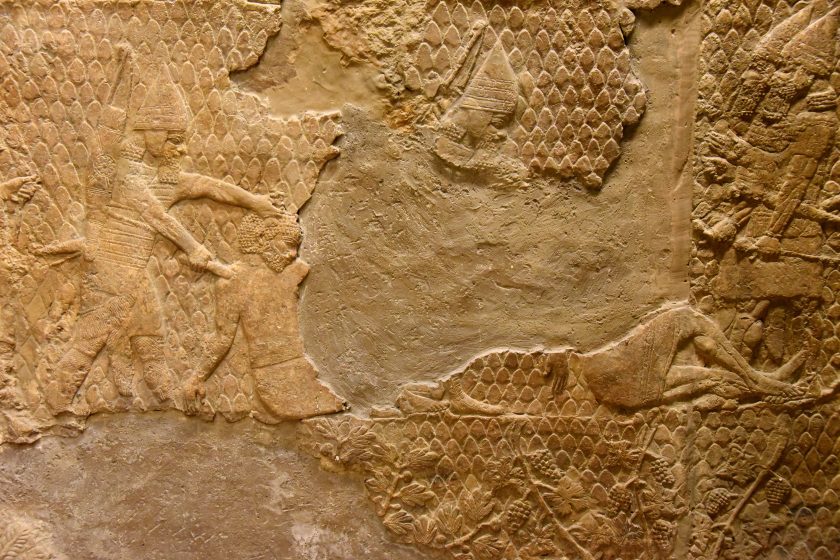
quote:What is your opinion on this following?
Originally posted by Tukuler:
quote:Differences in detail lead to supposing the individuals are actually from Ukku.
The prisoners, who have probably been captured during one of Sennacherib's campaigns in Iran or eastern Turkey,
Their dress for instance resembles that of Alammu another place Sennacherib beat down.
The Lachish 'wallpaper' is below the individuals.
What's the order of conquest between Lukku Alammu and Lachish per Sennacherib's chronicles?
quote:
Originally posted on p3 of this thread by Tukuler:
More Lachish Jewish women with their woolly haired husbands?
http://www.odysseyadventures.ca/articles/lachish_slides/lachishSiege01dPrisoners.jpg
[…]
Ah, or is it people of a city called Ukku?
quote:~Kevin Burrell, (p.164)
Herodotus called Susa "the city of Memnon," Herodotus describes two tall statues with Egyptian and Ethiopian dress that some, he says, identify as Memnon; he disagrees, having previously stated that he believes it to be Sesostris.
quote:~D.T. Potts, New York University
In discussing the royal road from Sardis to Susa, Herodotus also referred to ‘the king’s abode called Memnonian’ and said of Susa, ‘that is the city called Memnonian.’16 The association between Cissia, Tithonus and Memnon was also explicit in Strabo who wrote, ‘Susis also is almost a part of Persis. It lies between Persis and Babylonia, and has a very considerable city, Susa....It is said to have been founded by Tithonus, the father of Memnon. Its compass was 120 stadia. Its shape was oblong. The Acropolis was called Memnonium. The Susians have the name also of Cissii.’17
Writing of a fragment believed to originate in Aeschylus’ Memnon, West noted, ‘The speaker, prob- ably Priam himself, is interrogating the newcomer and has learned that he is a native of Ethiopia; he finds no fault with that, but awaits further clarification.
quote:~George G. Cameron, The History of Early Iran
There is some evidence leading to the belief that a protonegroid population once extended westward from India along the shores of the Persian Gulf. Individuals of that group seem to be portrayed on seventh century B.C. reliefs of an Assyrian king. 38 Greek authors speak of "Ethiopians" in the southeast of the land; 39 their modern descendants possess copper skins, straight hair, and round skulls.
So far as it is possible to determine, in ancient times there were longheaded races in Iran preceding the Nordic peoples. The basis for this belief is found in the appearance, in Mesopotamia, of a brown Eurafrican type of man. Our present evidence concerning him is indeed scanty, but seems to suggest a remote physical connection with India. 41 It is possible that these longheads themselves were Sumerians, or were related to them, for it has been said that one can still.
Our present evidence concerning him is indeed scanty, but seems to suggest a remote 41 38 Cf. the upper register of the Ashurbanipal relief in E. Pottier, Les Antiquites assyriennes (du Mus6e du Louvre) (Paris, 1917), PI. 23; for details cf. Victor Place, Ninive et V Assyrie, Vol. Ill (Paris, 1867), PI. 59, No. 1. Or seeH. R. Hall, Babylonianand Assyrian Sculpture in the British Museum (Paris and Brussels, 1928), PI. XLIV . Finally, cf. the Achae- menian reliefs from Susa in M. Dieulafoy, Uacropole de Suse (Paris, 1893), Pis. V and VI.
Herodotus vii. 70;Strabo xv, 1,13, and 24.
*° Dieulafoy, Uacropole de Suse, p. 28. 41 Buxton in L. H. Dudley Buxton and D. Talbot Rice, "Report on the Human Remains Found at Kish," Journal of the Royal Anthropological Institute, LXI (1931), 57-119, esp. pp. 84 ff. century B .C . reliefs of an Assyrian king. thors speak of "Ethiopians" in the southeast of the land;39 their modern descendants possess copper skins, straight hair, and round skulls.
ever, safe to say that these peoples never constituted an important or a large element in the population.
quote:https://etc.ancient.eu/photos/siege-lachish-reliefs-british-museum/
By 701 BCE the Assyrian kings, based in Nineveh (modern-day Mosul Governorate, Iraq), built their enormous empire. It stretched from modern-day Iran to Egypt and covered most of the modern-day Middle East.
quote:https://www.ancient.eu/nineveh/
The city was best known through the Christian era (and still is) by the central role it plays in the biblical Book of Jonah. The Book of Jonah was written between 500-400 BCE depicting events from hundreds of years earlier in the reign of the Hebrew King Jeroboam II (786-746 BCE).
quote:https://en.wikipedia.org/wiki/Lachish_reliefs
The Lachish reliefs are a set of Assyrian palace reliefs narrating the story of the Assyrian victory over the kingdom of Judah during the siege of Lachish in 701 BCE. Carved between 700-681 BCE, as a decoration of the South-West Palace of Sennacherib in Nineveh (in modern Iraq) […]
The events surrounding the conquest of Lachish are recorded in an unparalleled number of sources for the 8th century BCE; in the Hebrew Bible, the Lachish reliefs, Assyrian cuneiform prisms and in the archeological excavations at Lachish.[7] Sennacherib's conquests of Judean cities, without the capital Jerusalem, are mentioned in the Bible, the book of Kings, Book of Chronicles and in the book of Isaiah.
"Later, when Sennacherib king of Assyria and all his forces were laying siege to Lachish, he sent his officers to Jerusalem with this message for Hezekiah king of Judah and for all the people of Judah who were there"-(II Chronicles 32:9)
"Now it came to pass in the fourteenth year of King Hezekiah that Sennacherib king of Assyria came up against all the fortified cities of Judah and took them." - (Isaiah 36:1-2)
quote:http://www.bibleodyssey.org/en/people/related-articles/life-under-empire
The Ezra and Nehemiah traditions also show Jews who were given significant posts by Persian rulers. Yet Ezra states that the Jews of the province of Yehud are “slaves” in the Persian Empire (Ezra 9:7-9). Some of the hardships suffered by the people are outlined in Neh 5, though whether their lot was different then than it was in other periods is an open question (since crop failure, borrowing, and losing loan collateral were problems experienced throughout history). [...]
In other texts, individuals with Yahwistic names were small holders or lower-rank officials. We also have an archive of texts relating to the house of Murashu, a business and financial establishment of the Persian period that employed Jews as servants or agents. The Jews seem to have been well integrated into society. Apart from Antiochus IV, persecutions of Jewish communities seem to have been local rather than imperial actions, until the Roman Empire became Christianized.
quote:https://en.wikipedia.org/wiki/Murashu_family
The Murashu tablets provide a glimpse into what life was like for fifth-century Jewish descendants of the Babylonian Exile and captivity. After the Persian king Cyrus the Great captured Babylon in 539 BCE, he allowed and helped finance the return of Jews to Judea with the Edict of Cyrus in 538. The Murashu tablets are dated to this period after Jews were allowed to return to Judea. The fact that the banking house "Murashu & Sons" conducted business with Jews who decided to remain in Nippur rather than return to Judea suggests that life in Persian-controlled Nippur was at least somewhat tolerable for Jews.[20]
quote:https://www.louvre.fr/en/oeuvre-notices/frieze-archers
This decorative frieze of polychrome glazed brick shows an army, the men carrying spears, bows and quivers. Are they the royal guards of Darius I (522–486 BC), whom Herodotus called “the Immortals,” or might they represent an idealized image of the Persian people?
This decorative frieze was certainly inspired by the Processional Way in Babylon, constructed by Nebuchadnezar II (604–562 BC)
quote:https://en.wikipedia.org/wiki/Nebuchadnezzar_II
During the Siege of Jerusalem, Nebuchadnezar captured King Jehoiachin along with prominent citizens and craftsman and appointed Zedekiah as King of Judah in his place, the latter rebelled and attempted to organize opposition among the small states in the region but his capital, Jerusalem, was taken in 587 BC (the events are described in the Bible's Books of Kings and Book of Jeremiah).[6]
quote:I don't do sprawling walls of text, Ish.
Originally posted by Ish Gebor:
What is your opinion on this following?


quote:^ to make the images show, go back to the images and right click
Originally posted by SMirk92:
None of The ancient civilizations of West Asia(Middle East) Were Black, White or even Contemporary Asiatic. The Sumerians, Elamites, Canaanites, Assyrians, Babylonians Were all a Mixture of Dravidian and African and later Asiatic but the initial Racial makeup was Mixed Dravidian/African. if you want a living example of what most of Ancient West Asia looked like then look to The Mehri People of Yemen today who are a Mixture of African and Dravidian.


quote:I don't know the amount of mental gymnastics you had to pull off in order to write what you just did, but as the artwork(s) show, the curl pattern is much tighter, i.e it's African textured hair. Even Stevie Wonder can see that. Try again.
Originally posted by Archeopteryx:
Curly hair is not exclusive for Africans, it can be found among Europeans and Middle Easterners too

If you travel in Europe you can see it with your own eyes.
Also even straight haired people can curl their hair, so a curly head on an old work of art do not indicate that the depicted person is African.
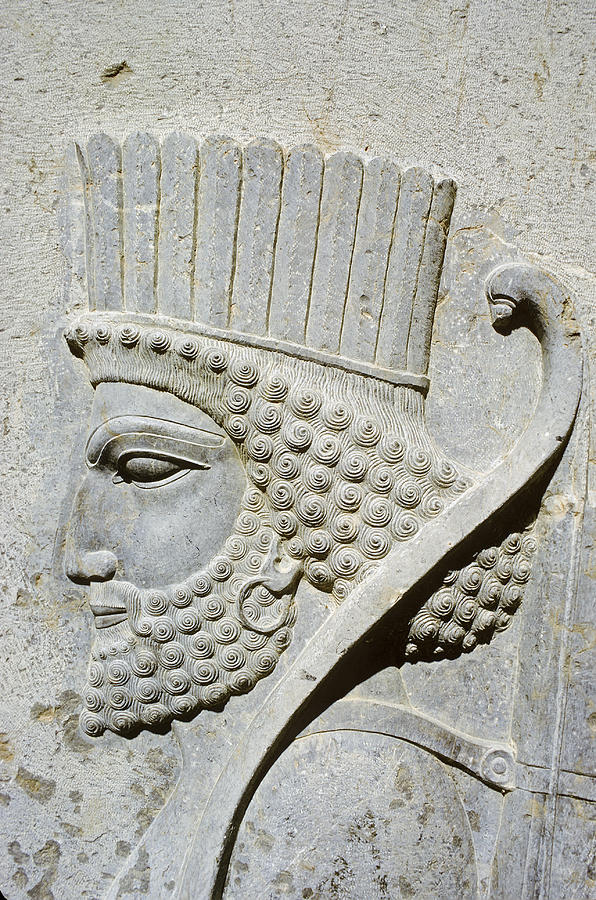
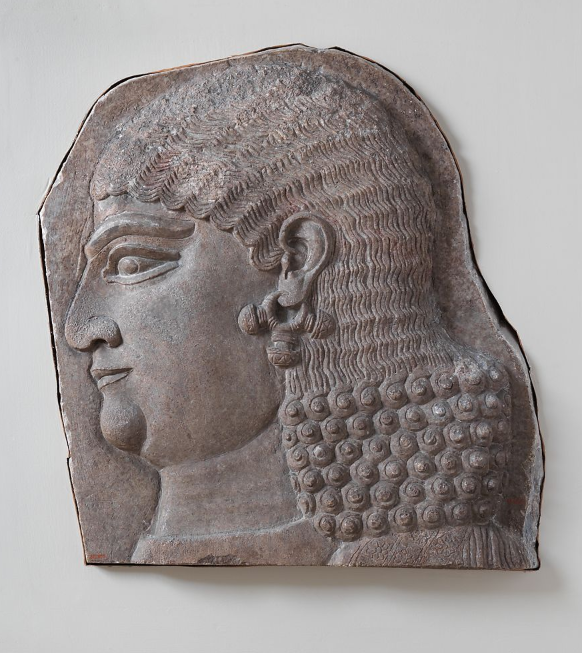
quote:Plus Europeans do not speak an Afran (Afroasiatic) language.
Originally posted by Snakepit1:
quote:I don't know the amount of mental gymnastics you had to pull off in order to write what you just did, but as the artwork(s) show, the curl pattern is much tighter, i.e it's African textured hair. Even Stevie Wonder can see that. Try again.
Originally posted by Archeopteryx:
Curly hair is not exclusive for Africans, it can be found among Europeans and Middle Easterners too

If you travel in Europe you can see it with your own eyes.
Also even straight haired people can curl their hair, so a curly head on an old work of art do not indicate that the depicted person is African.
quote:Ok, I try to write new ones about subjects that are interesting instead.
Originally posted by the lioness,:
Archeopteryx, please don't overdo bumping up old topics,
thanks
![[Smile]](smile.gif)
quote:Case in point is, there is more traced than "just" curly hair. All this has been discussed over the years.
Originally posted by Archeopteryx:
The pic in question was just an illustration that curly hair is not exclusive for Africans.
And most of all it is hard to determine on old artwork how loose or tightly peoples curls were. Many pictures are somewhat stylized, so one can not always determine peoples race only by pictures. Many seem to take old artwork very literally. But if one does that one must also accept people with horns, blue people and many other oddities. Best way to know what hair they had is to find intact bodies with hair preserved. Next best way is to find DNA where we also can determine "race" and perhaps hair texture. Art is not the best way, it leaves room for many interpretations. You must be very well versed in the artistic codes and symbolism in a specific culture to be able to interpret its art correctly.
It is just wishful thinking to interpret every person in ancient art as an African. Fantasy and wishful thinking. Some black Americans so very much want to be some other people so they forget their own west African roots. It is a pity for those roots are more interesting than all dreams about black Israelites, black Olmecs and other products of imagination.


quote:
Originally posted by Archeopteryx:
Some black Americans so very much want to be some other people so they forget their own west African roots. It is a pity for those roots are more interesting than all dreams about black Israelites, black Olmecs and other products of imagination.
quote:
Originally posted by Tukuler:
Oh, we're pretty sure of the Lachish art.
Art becomes doubtful only where blx r nvolved.
Yet somehow all other art reflects correctly.
Scattered modern ndividuals here and there mean nothing.
All Judaean men of Lachish have wooly hair.
There is no modern Israeli city of all woolly haired men.

quote:Yes both whites and blacks have loved to immerse themselves in fantasies and dreams, inspired by biblical stories.
Wishful European thinking has produced a plethora of biblical idylls wherein Levantine people are depicted as Euros. That's how much some yte Euros want to forget their roots and be some other ppl --or shall we forget these yte Israelite dreams.



quote:A very good thesis.. that matches the above.. Israel beginnings are with Egyptian mercenaries...VERY INTERESTING but when you watch listen to what he DOES NOT say or what he hesitates to say about "who" where hired Egyptian soldiers..
Originally posted by Tukuler:
Noted racists Nott & Gliddon also didn't want to accept Lachish depictions for what they delineate.
Oh, we're pretty sure of the Lachish art.
Art becomes doubtful only where blx r nvolved.
Yet somehow all other art reflects correctly.
Scattered modern ndividuals here and there mean nothing.
All Judaean men of Lachish have wooly hair.
There is no modern Israeli city of all woolly haired men.
Anyway roundup of current Jewish DNA includes a ~4% indistinguishable Afr ancestry going back to Babylonian captivity times.
The sources are posted above on this page
The earliest `Am Yisra'el spoke an African language and became a people on the African tectonic plate and, of course were not NW Euros nor continental Afrs.
Judea skin colour was within African brown complexions as noted by contemporaneous classical authors.
We have a Palestinian and old French Jewish self-descriptions as black & beautiful and plum black .
One authoritative self-description say neither Germanic yte nor Sudanic blk, but in between.
`Am Yisra'el hair texture and skin colour is what it is.
Blk Amers got nothing to do with it.
Ancient Israel was a Levantine ppl varying in looks from SyroLebanese to SudanoEgyptian naturally.
HellenoRoman Judea got some of its looks from N Med converts.
These ppl have married and mated with every ppl they came in contact with.
Patai, Raphael & Jennifer
The myth of the Jewish race
Scribner: New York, 1975
Wait lemme save this pg b4 this whole thread gets axed too.
quote:LOL The Abrahamic religions come for proto-Afran cultures. These cultures first arose in Africa,
Originally posted by Archeopteryx:
quote:Yes both whites and blacks have loved to immerse themselves in fantasies and dreams, inspired by biblical stories.
Wishful European thinking has produced a plethora of biblical idylls wherein Levantine people are depicted as Euros. That's how much some yte Euros want to forget their roots and be some other ppl --or shall we forget these yte Israelite dreams.
But one can still wonder why the descendants of West African slaves want to mimic the fantasies of their former oppressors instead of researching their own West African historical roots.
quote:~Andrew Kitchen, Christopher Ehret2, Shiferaw Assefa2 and Connie J. Mulligan
Our statistical tests of alternative Semitic histories support an initial divergence of Akkadian from ancestral Semitic over competing hypotheses (e.g. an African origin of Semitic). We estimate an Early Bronze Age origin for Semitic approximately 5750 years ago in the Levant, and further propose that contemporary Ethiosemitic languages of Africa reflect a single introduction of early Ethiosemitic from southern Arabia approximately 2800 years ago.
[…]
Semitic languages (Akkadian, Aramaic, Ge'ez, ancient Hebrew and Ugaritic) combined with archaeological evidence for the sampling dates of the epigraphic data (the time at which the materials were inscribed).

"These results indicate that the ancestor of all Semitic languages in our dataset was being spoken in the Near East no earlier than approximately 7400 YBP, after having after having diverged from Afroasiatic in Africa"
(i) Semitic had an Early Bronze Age origin (approx. 5750 YBP) in the Levant, followed by an expansion of Akkadian into Mesopotamia;
(ii) Central and South Semitic diverged earlier than previously thought throughout the Levant during the Early to Middle Bronze Age transition; and
(iii) Ethiosemitic arose as the result of a single, possibly pre-Aksumite, introduction of a lineage from southern Arabia to the Horn of Africa approximately 2800 YBP.
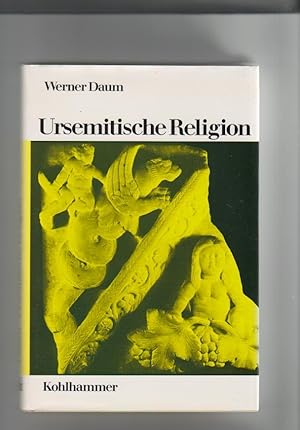


![[Big Grin]](biggrin.gif)
quote:Ok? And how was "Black African" hair portrayed during ancient times?
Originally posted by Archeopteryx:
People with this kind of look still exist in the Middle East. One does not have to go to Africa to find curly hair
...
...
…
All the Blacks that supposedly lived in ancient Israel seems to fail to show up when it concerns actual physical remains. Also as mentioned the sample of ancient Jewish hair that exist is not even black and seems not indicate any Black African.
Actual physical remains trumps artistic representations (which often are stylized and follow different artistic and cultural codes) but even the images can not be proven to show African black people.
![[Roll Eyes]](rolleyes.gif)



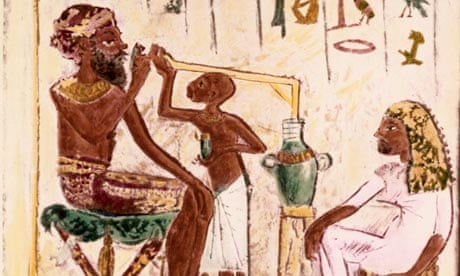
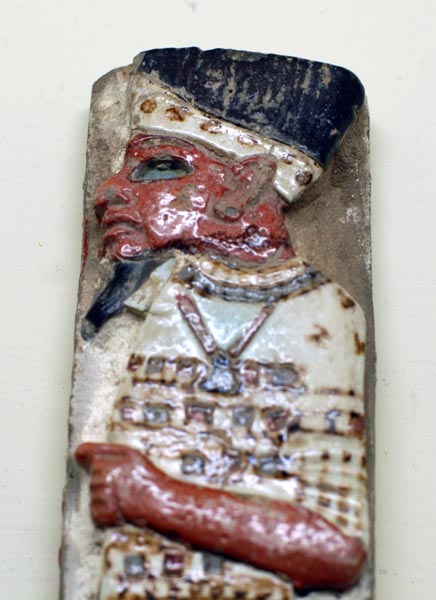
quote:This is the same guy, and the question is, why you keep lying?
Originally posted by Archeopteryx:
Middle Eastern men can many times be rather curly haired which everyone who has actually been there might have seen.
DNA studies have also showed that Jews and other Middle Easterners have some common traits genetically. Considering the geographical location of Israel one ought not to be very surprised.
If one shall return to the ancient art works so, even if one must be careful in interpreting them, many of the men in the old representations rather reminds of this man than of stereotypical African people.
…

quote:You are getting desperate. You love to show the world one type. But not these:
Originally posted by Archeopteryx:
Middle Eastern men can many times be rather curly haired which everyone who has actually been there might have seen.

quote:That is actually not the case.
Originally posted by Archeopteryx:
DNA studies have also showed that Jews and other Middle Easterners have some common traits genetically. Considering the geographical location of Israel one ought not to be very surprised.
quote:You are getting desperate with your photos. You have some explaining to do.
Originally posted by Archeopteryx:
If one shall return to the ancient art works so, even if one must be careful in interpreting them, many of the men in the old representations rather reminds of this man than of stereotypical African people.
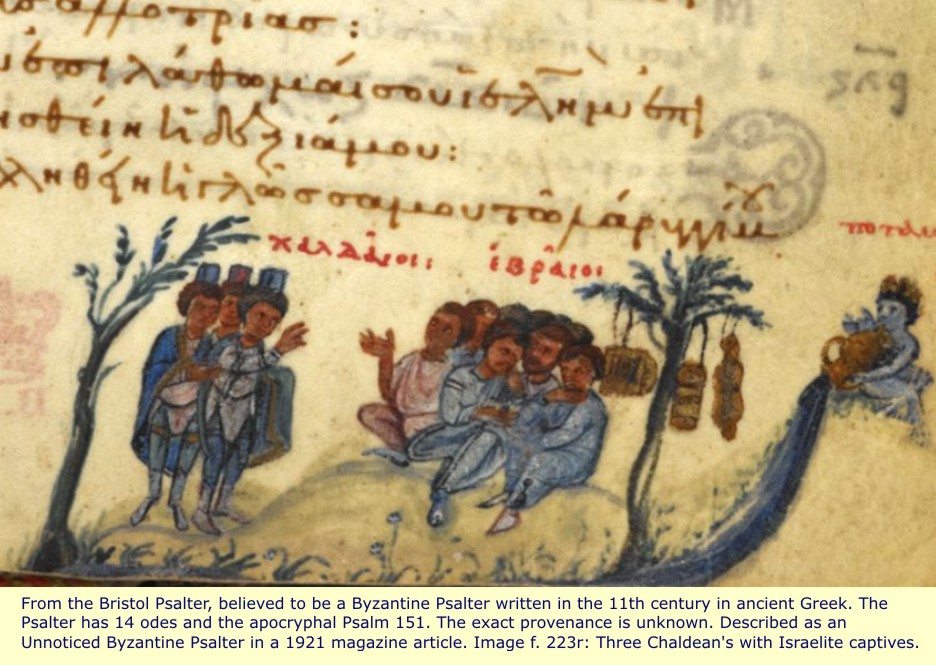
quote:
Originally posted by Andromeda2025:
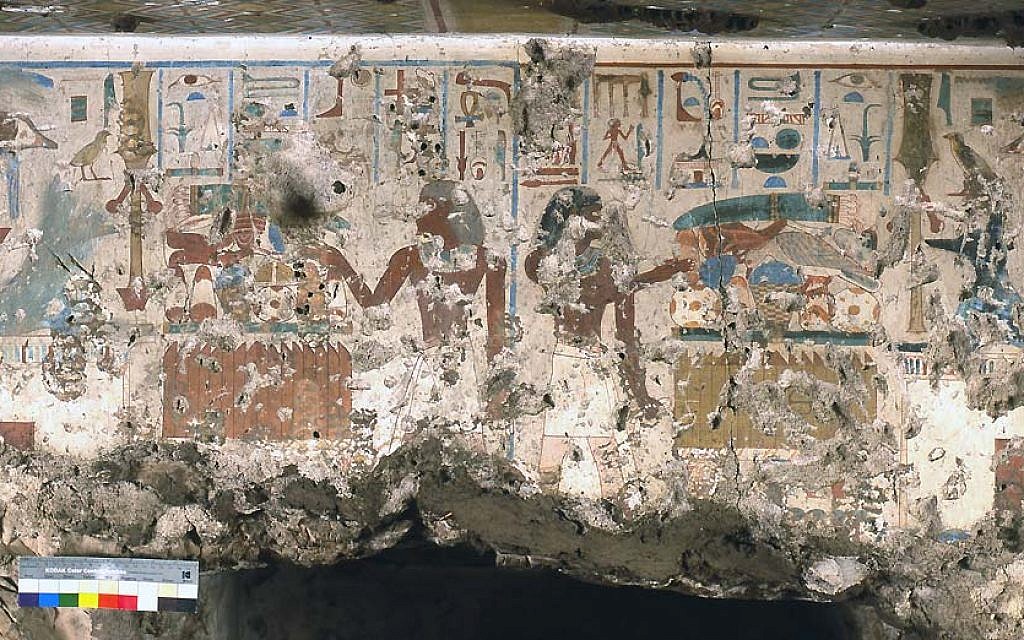
Newly deciphered Egyptian symbols on a 3,400-year-old limestone ostracon from Luxor’s Tomb of Senneferi appears to be the first written evidence of the ABC letter order of the early Semitic alphabet, according to a University of British Columbia Egyptologist.
In his article, “A Double Abecedary? Halaham and ‘Abgad on the TT99 Ostracon,” Prof. Thomas Schneider concludes that a small (approximately 10 x 10 centimeters, or about 4 x 4 inches) double-sided limestone flake was used by Egyptian scribes as a mnemonic device to remember the letter orders of not one, but two forms of early Semitic alphabets.
On one side of the flake is Schneider’s recent discovery: the transliteration into cursive Egyptian writing of the sounds that signify the beginnings of today’s Hebrew alphabet (Aleph, Bet, Gimel). On the other, a contemporary, though now lesser-known letter order, called “Halaḥam,” which was deciphered in 2015, on the same limestone flake, by Leiden University’s Dr. Ben Haring.
https://www.timesofisrael.com/first-written-record-of-semitic-alphabet-from-15th-century-bce-found-in-egypt/
quote:Archeopteryx is a bit unaware of basic history, so it needs to be deciphered into multiple parts for him/ her.
Originally posted by the lioness,:
If people make their own topics, their posting will me unrestricted but if it's in another person's topic will be limited to how many big posts in a row
quote:this is inflammatory, people don't like to be identified as descendants slaves I and also irrelevant) and told how to think.
Originally posted by Archeopteryx:
But one can still wonder why the descendants of West African slaves want to mimic the fantasies of their former oppressors instead of researching their own West African historical roots.


quote:People of West African descent can talk about what they want. Just like how you feel that you can put your nose in anything.
Originally posted by Archeopteryx:
About hair, as I said, to determine exactly how the ancient Israels looked like using art is not always the best way. Actual remains are better. So we need to test more remains before we can be sure of anything.
Concerning hair there are very few samples of ancient preserved hair from Israel, but there are at least a sample of about 2000 years old male hair. It is not mentioned as typical African, and it is not even black. The idea of the ancient Israelites as all black and curly headed seems not to be corroborated by science.
The Only Ancient Jewish Male Hair Ever Found
Biblical archaeology
But the main question remains: Why do some Black Americans want to borrow other peoples heritage just to enhance themselves? Be proud instead of your true West African heritage, and let other peoples be proud over their heritage.
![[Embarrassed]](redface.gif)
quote:~Avshalom Zoossmann-Diskin1,2,3 et al.
"Conversion to Judaism was common in Rome in the first centuries BC and AD. Judaism gained many followers among all ranks of Roman Society [10-13]."
quote:(Cornelius Tacitus (AD 55 - 117), The Histories by Cornelius Tacitus.)
Many assure us that the Jews are descended from those Ethiopians who were driven by fear and hatred to emigrate from their home country when Cepheus was king. There are some who say that a motley collection of landless Assyrians occupied a part of Egypt, and then built cities of their own, inhabiting the lands of the Hebrews and the nearer parts of Syria. Others again find a famous ancestry for the Jews in the Solymi who are mentioned with respect in the epics of Homer: this tribe is supposed to have founded Jerusalem (4) and named it after themselves.
quote:(Carney D. Matheson et al., Molecular Exploration of the First-Century Tomb of the Shroud in Akeldama, Jerusalem)
The haplotypes for the Tomb of the Shroud individuals are commonly distributed throughout the North of Africa and the Middle East through to Eastern Europe.
[…]
A recent hypothesis [45] suggests that leprosy may have first appeared in the region not with Alexander but sometime earlier (circa 400 B.C.E or later), with diseased young slaves conveyed from India to Egypt on cargo ships. More recently a review of the origins and spread of leprosy has identified an East African origin with various routes of migration out of Africa into the Middle East and beyond [46].
https://journals.plos.org/plosone/article/figure/image?size=large&id=10.1371/journal.pone.0008319.t003
https://journals.plos.org/plosone/article/figure/image?size=large&id=10.1371/journal.pone.0008319.t005
quote:http://www.nbcnews.com/id/19378819/ns/technology_and_science-science/t/new-research-questions-some-masada-remains/
Zias concluded the hair belonged not to a Jewish woman but to a foreign woman who fell captive in the hands of Jewish fighters.
quote:https://www.biblicalarchaeology.org/daily/ancient-cultures/ancient-israel/the-only-ancient-jewish-hair-ever-found/

There seems to be an unwritten axiom, those who seek never find, and those who find were not seeking. I have participated in over 20 seasons of excavation at five different sites over the past 25 years and I can’t count the times when suddenly, “out of the blue,” one of our students, volunteers, or a staff member suddenly finds something significant–and totally unexpected! Such was the case with the 15 line ostracon at Qumran in 1996, the engraved 1st-century menorah we found at Sepphoris in 1999 or the mysteriously inscribed stone vessel at Mt Zion in 2009.
quote:https://www.ynetnews.com/articles/0,7340,L-4891062,00.html
“Ziv said that many Jewish-Ethiopian customs go against modern Jewish practice, but perfectly align with customs and rituals described on scrolls found in the Qumran caves and in books dating back to the Second Temple Period. The Qumran Caves are where the Dead Sea Scrolls were found, which include the third oldest Hebrew Bible ever found.”
quote:https://muse.jhu.edu/article/491385/summary
“The Book of Enoch was known since the eighteenth century when travelers became familiar with it. The book was preserved in Ethiopic (Ge'ez) and the research on the Enochic texts was mostly based on the Ethiopic version of the text until the discovery of the Dead Sea Scrolls. Texts that relate to Enoch are vast within the Qumran collection.”
quote:http://orthochristian.com/94812.html
ETHIOPIAN BIBLE IS OLDEST AND MOST COMPLETE ON EARTH
quote:(Carolyn Perry, July 26, 2012, The Sabaean Temple of Almaqah in Addi Akaweh (Tigray), Ethiopia)
Dr Pawel Wolf gave the MBI Al Jaber Public Lecture at the British Museum this year as part of the annual Seminar for Arabia Studies. The lecture was entitled 'Colonisation or Culture Transfer? The Almaqah temple of Wuqro (Tigray) sheds new light on Ethio-Sabaean culture contacts in the Northern Horn of Africa' and gave an insight into the fascinating work of the German Archaeological Institute (DAI) over the past few seasons.
Addi Akaweh, 2000 m above sea level, is in a region of Tigray which has not yet been explored for archaeological material. In the north of the Abyssinian highlands, the region is about 50 km north of the provincial capital of Mekelle, and seems to have been of importance due to its proximity to the ancient trade routes southeast of the main ancient centres of Axum and Yeha.
The temple of the Sabaean God Almaqah is one of the main archaeological discoveries of the area, though there are signs of an ancient settlement nearby and some building believed to have a sacred use at nearby Ziban Adi. They belong to a settlement area of the 1st millennium BC, a period of crucial social development in the Abyssinian highlands.
Since the Neolithic period, the Abyssinian highlands were part of a far-flung network of exchange relationships between North Africa and the Arabian Peninsula, and both African and South Arabian cultural components can be seen in its development. South Arabian inscriptions, temples and sculptures from the early 1st millennium BC, have been found at Yeha and Hawlti.
Various models of social development have been applied to explain the strong South Arabian presence such as colonization or economic and cultural relations. More research and work needs to be carried out before the contacts can be properly understood.
The primary objective of the work of the DAI in Addi Akaweh is to comprehensively record and explore the archaeological material to shed light on the local cultural transformation in the context of regional contacts. Intercultural contacts and external relations with neighbouring cultural areas such as South Arabia, the Nile Valley and the south are still unexplored, and need to be investigated cross-regionally.
The Almaqah temple offers the ideal opportunity for the study of specific religious cultural components. The reconstruction of spatial concepts, ritual procedures and votive practices sheds light on the sacral-political space of the regional elite. The temple was built in the 8th to 6th centuries BC on the ruins of an earlier building and continued in use with several modifications to probably the 3rd century BC. It resembles the early South Arabian religious buildings in form and is built from local stone. Some of its most important features are a betyl made from naturally rounded boulders and perfectly preserved and libation altar donated by a hitherto unknown king named W'RN. His dedicatory inscription proves the ancient name of Yeha for the first time and demonstrates its importance as a national religious and political centre. It also shows that elements of royal elite cultural and ideological traditions of South Arabia and the African region are used together. C14 dating confirmed the Ethiopian Sabaean inscriptions to date to the 7th century BC.
quote:.
Originally posted July 01, 2014 by alTakruri:
quote:.
Originally posted by alTakruri:
I have nothing at stake in the "Persian Afro." I
couldn't give a damn if their hair was nappier than
a racoon's [rear] or straighter than a sow's [sugarwalls].
Like I said I used to think they had natural naps
but after the experience of viewing busts
from the perspective of directly above the crowned head
I now stand by the ends of the hair being curled by artifice.
Wow, looks like the original page 1 got axed.
Anyway, here's the pic I couldn't post back
then to support my above quoted statement.
quote:
Originally posted December 22, 2009 by alTakruri:
A careful look at the image below reveals that the
bushy hair is so by artifice since immediately below
the crown one can see the the natural wavy nature
of the hair. This is true of nearly all the Persian art
(Elamites excluded for one). One need examine many
art pieces to notice these characteristics of their hair.

At one time I subscribed t the belief that nappy hair
was depicted. Then I saw many and larger art pieces
where I noticed the hair is wavy at the root and is
only bushy at the ends. This led me to believe the
bushiness was due to the knack of hairdressers.
The Persian 'du is elaborate in design. Their natural
hair was loosely wavy, as you can see at the edge of
the king's crown, then the ends were tightly curled. All
in all it produces the effect of wooly hair like the curly
Afro some Ladinos, Iranians, and Arabs used to wear
back in the 1970's. You know, the "Jewfro"
Back in the 70's many wavy haired folk sported Afros.
It wasn't because they were black or had nappy hair.
It was because they admired the long nappy hair many
blacks were wearing then.
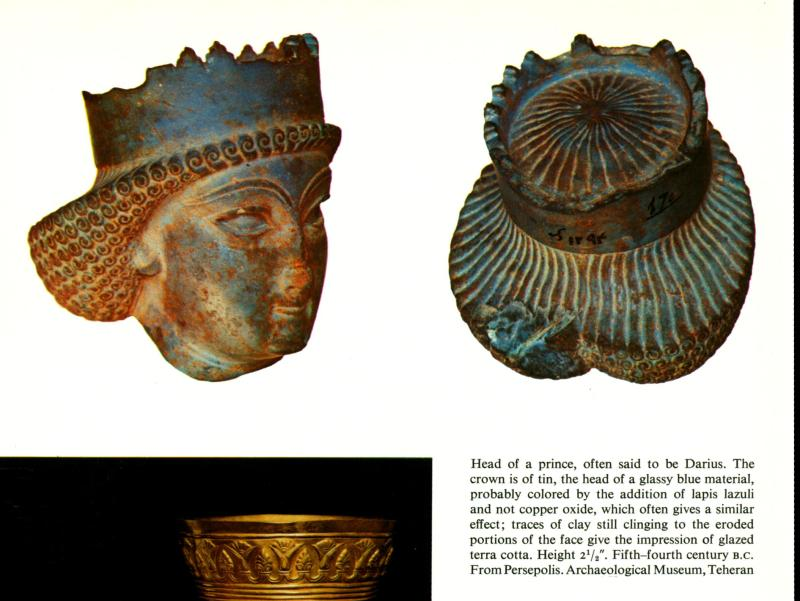
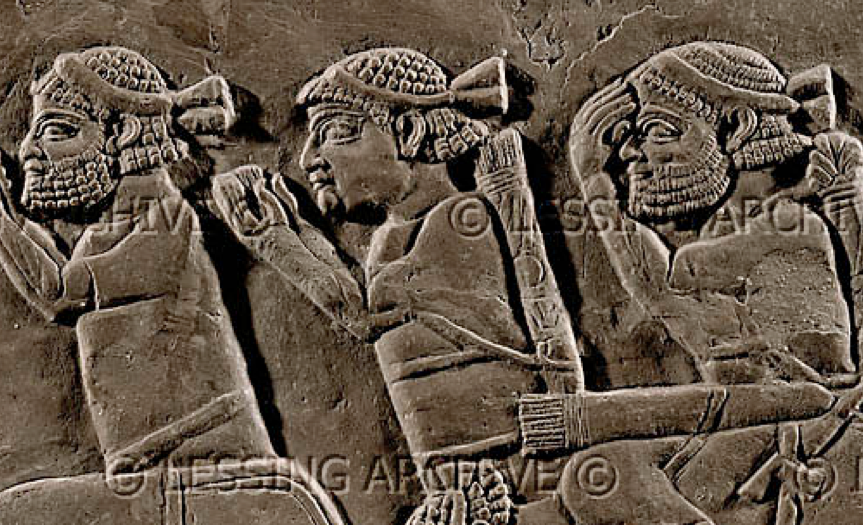


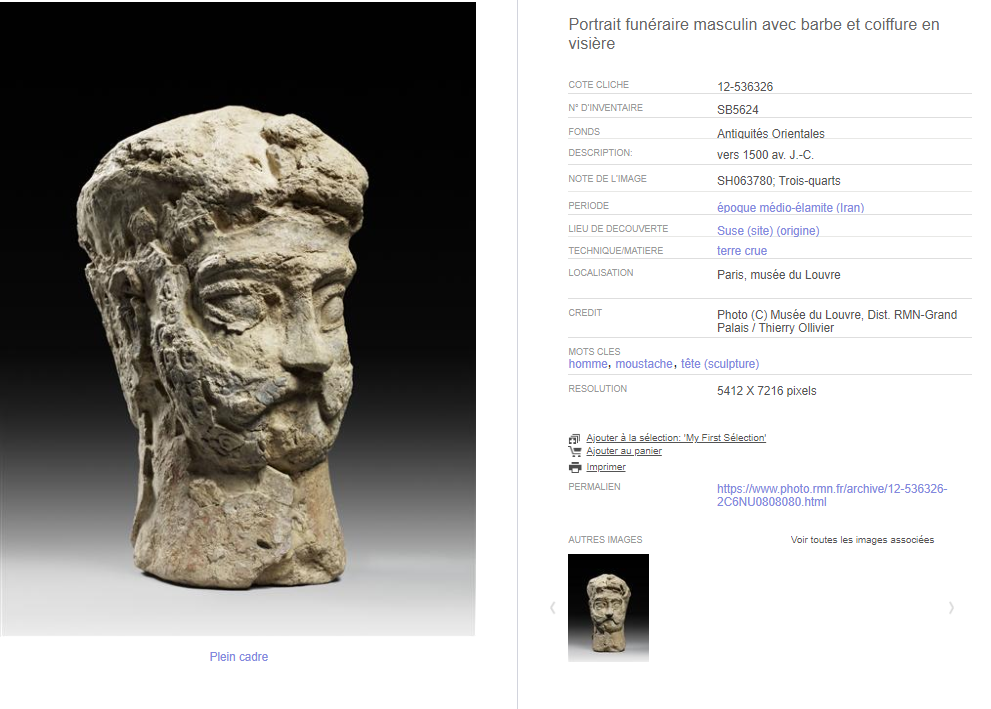
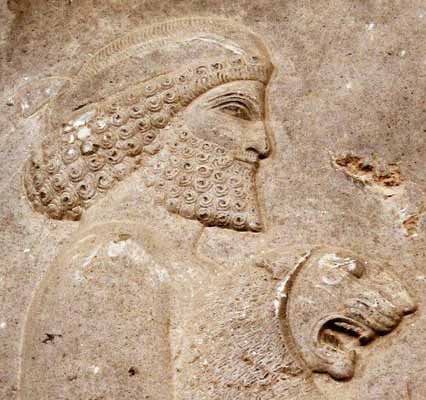

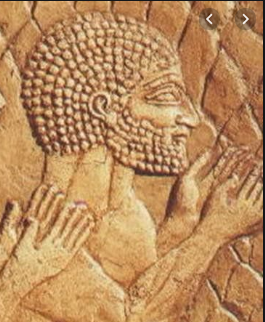

quote:
Originally posted by Yatunde Lisa:
quote:A very good thesis.. that matches the above.. Israel beginnings are with Egyptian mercenaries...VERY INTERESTING but when you watch listen to what he DOES NOT say or what he hesitates to say about "who" where hired Egyptian soldiers..
Originally posted by Tukuler:
Noted racists Nott & Gliddon also didn't want to accept Lachish depictions for what they delineate.
Oh, we're pretty sure of the Lachish art.
Art becomes doubtful only where blx r nvolved.
Yet somehow all other art reflects correctly.
Scattered modern ndividuals here and there mean nothing.
All Judaean men of Lachish have wooly hair.
There is no modern Israeli city of all woolly haired men.
Anyway roundup of current Jewish DNA includes a ~4% indistinguishable Afr ancestry going back to Babylonian captivity times.
The sources are posted above on this page
The earliest `Am Yisra'el spoke an African language and became a people on the African tectonic plate and, of course were not NW Euros nor continental Afrs.
Judea skin colour was within African brown complexions as noted by contemporaneous classical authors.
We have a Palestinian and old French Jewish self-descriptions as black & beautiful and plum black .
One authoritative self-description say neither Germanic yte nor Sudanic blk, but in between.
`Am Yisra'el hair texture and skin colour is what it is.
Blk Amers got nothing to do with it.
Ancient Israel was a Levantine ppl varying in looks from SyroLebanese to SudanoEgyptian naturally.
HellenoRoman Judea got some of its looks from N Med converts.
These ppl have married and mated with every ppl they came in contact with.
Patai, Raphael & Jennifer
The myth of the Jewish race
Scribner: New York, 1975
Wait lemme save this pg b4 this whole thread gets axed too.
The Oriental Institute
David Ilan | How Ancient Israel Began: A New Archaeological Perspective
https://www.youtube.com/watch?v=SSXmf0fnhMU
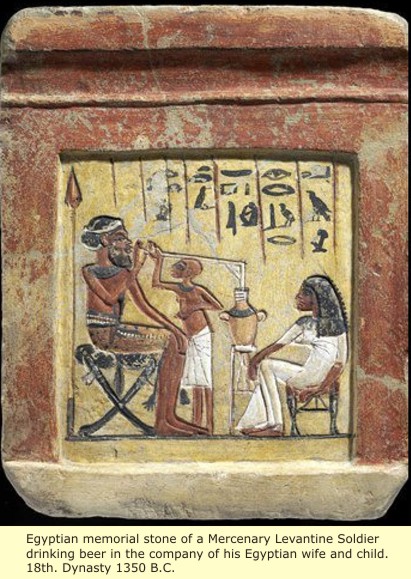
quote:It's time for you to start all over again, reading basic history. Especially when it comes to the ancient Greeks and Ethiopians.
Originally posted by the lioness,:
... Head from statue of Herakles (Hercules) Roman 117-188 CE from villa of the emperor Hadrian at Tivoli, Italy. Portland Art Museum
...
quote:https://pantheon.org/articles/h/heracles.html
Herodotus51 tells us that he made inquiries respecting Heracles: the Egyptian he found to be decidedly older than the Greek one; but the Egyptians referred him to Phoenicia as the original source of the traditions. The Egyptian Heracles, who is mentioned by many other writers besides Herodotus and Diodorus, is said to have been called by his Egyptian name Som or Dsom, or, according to others, Chon,52 and, according to Pausanias,53 Maceris. According to Diodorus,54 Som was a son of Amon (Zeus); but Cicero calls him a son of Nilus, while, according to Ptolemaeus Hephaestion, Heracles himself was originally called Nilus. This Egyptian Heracles was placed by the Egyptians in the second of the series of the evolutions of their gods.55
quote:https://archive.archaeology.org/9701/newsbriefs/negev.html
Egyptian Tomb in Israel
The discovery of an Egyptian-style tomb at Tel Halif in the Negev Desert suggests an Egyptian colonial presence in southern Israel ca. 3000 B.C. Most burials in the region are in caves or shaft tombs attributed to the Canaanites, but this one, built during the Early Bronze 1B period (3300-3000 B.C.), is typical of contemporary tombs in Egypt, according to excavators Thomas Levy of the University of California, San Diego, and David Alon of the Joe Alon Regional Research Center in Israel. A 30-foot-long passageway descends to the burial chamber, which is about 26 feet long, 16 feet wide, and nine and one-half feet high. Within the dome-shaped chamber is a plastered stone platform on which the skeleton of a woman was found. About 25 years old when she died, she was found in a fetal position facing east, characteristic of Egyptian burials.
That an Egyptian was buried at Tel Halif "gives us evidence of a full-blown Egyptian colony in Israel right after the crystallization of the first Egyptian state," says Levy. "Egyptians were known to have very profound and elaborate belief systems about the afterlife and what was required to get there. One of these requirements was to die and be properly entombed on Egyptian soil. I think it's very likely that this part of southern Israel was considered part of greater Egypt during this period."
Egyptian ceramics, seal impressions, and bread molds found at Tel Halif support an Egyptian occupation. Among these artifacts is a potsherd engraved with the serekh, or sign, of King Narmer, who is believed to have united Upper and Lower Egypt between 3050 and 3000 B.C.
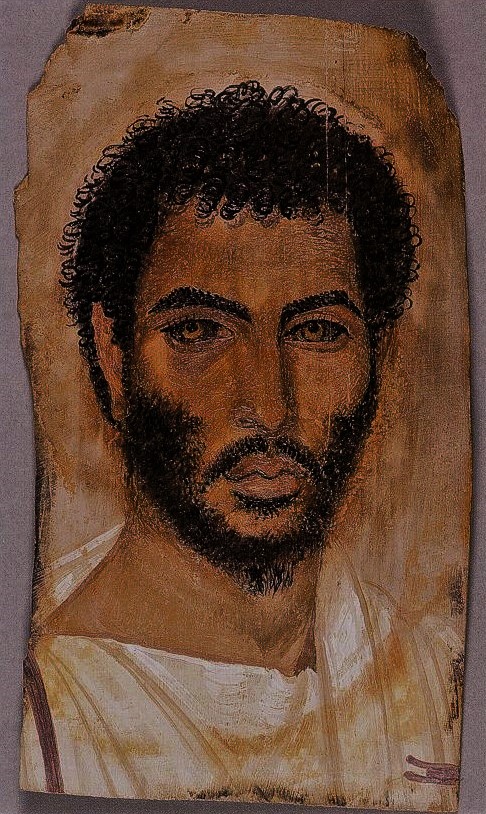
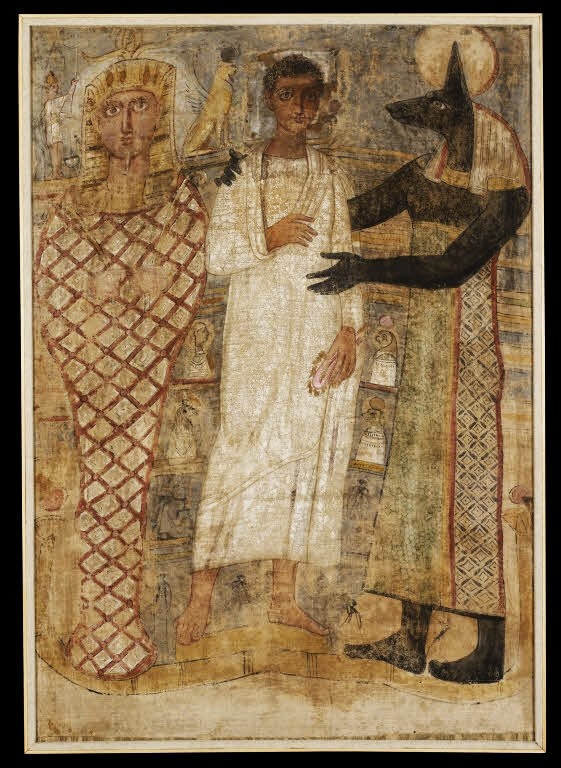
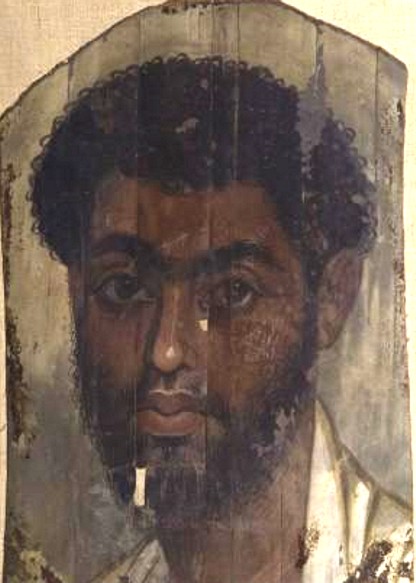

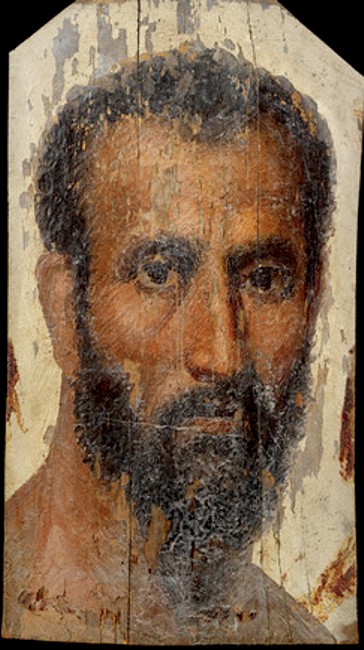
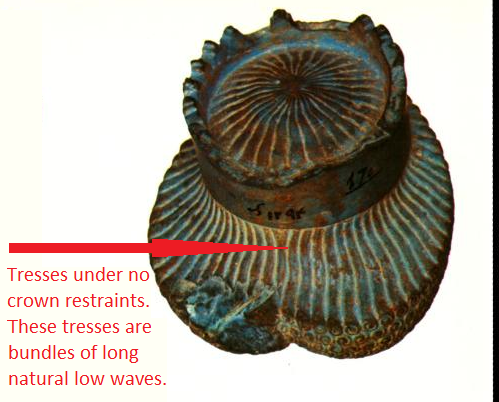




quote:.
Originally posted by Yatunde Lisa:
A very good thesis.. that matches the above.. Israel beginnings are with Egyptian mercenaries...VERY INTERESTING but when you watch listen to what he DOES NOT say or what he hesitates to say about "who" where hired Egyptian soldiers..
The Oriental Institute
David Ilan | How Ancient Israel Began: A New Archaeological Perspective
https://www.youtube.com/watch?v=SSXmf0fnhMU
quote:"Woolly hair" is often associated with an African phenotype overall but the above suggests not necessarily
Originally posted by Tukuler:
This 'Elamite' example has naturally woolly hair.
Upper hair appears wavy from filet pull pressure.
Lower hair unconstrained by filet is curly 'fro hair.
I've seen this hair type in a Belarus native.
It was stiffer than similar hair on a German.


quote:I don't know what this means
Originally posted by Tukuler:
Mm hmm yeah that's them dialectics saying so any much more than supraliminal text.

quote:.
Originally posted by the lioness,:

Jewish nosed man, Nineveh, Palace of Senacherib, Lachish Room: Surrender
Date
ca. 700 BCE
quote:
Originally posted by the lioness,:

Nineveh, Palace of Senacherib, Lachish Room: Surrender
Date
ca. 700 BCE
In looking at this Lachish relief it is not clear what the hair type is
The circular pattern, how it is arranged on the head doesn't seem realistic
quote:
Originally posted by the lioness,:
quote:"Woolly hair" is often associated with an African phenotype overall but the above suggests not necessarily
Originally posted by Tukuler:
This 'Elamite' example has naturally woolly hair.
Upper hair appears wavy from filet pull pressure.
Lower hair unconstrained by filet is curly 'fro hair.
I've seen this hair type in a Belarus native.
It was stiffer than similar hair on a German.
![[Roll Eyes]](rolleyes.gif)
quote:~Andrew Kitchen, Christopher Ehret2, Shiferaw Assefa2 and Connie J. Mulligan
Our statistical tests of alternative Semitic histories support an initial divergence of Akkadian from ancestral Semitic over competing hypotheses (e.g. an African origin of Semitic). We estimate an Early Bronze Age origin for Semitic approximately 5750 years ago in the Levant, and further propose that contemporary Ethiosemitic languages of Africa reflect a single introduction of early Ethiosemitic from southern Arabia approximately 2800 years ago.
[…]
Semitic languages (Akkadian, Aramaic, Ge'ez, ancient Hebrew and Ugaritic) combined with archaeological evidence for the sampling dates of the epigraphic data (the time at which the materials were inscribed).

"These results indicate that the ancestor of all Semitic languages in our dataset was being spoken in the Near East no earlier than approximately 7400 YBP, after having after having diverged from Afroasiatic in Africa"
(i) Semitic had an Early Bronze Age origin (approx. 5750 YBP) in the Levant, followed by an expansion of Akkadian into Mesopotamia;
(ii) Central and South Semitic diverged earlier than previously thought throughout the Levant during the Early to Middle Bronze Age transition; and
(iii) Ethiosemitic arose as the result of a single, possibly pre-Aksumite, introduction of a lineage from southern Arabia to the Horn of Africa approximately 2800 YBP.
quote:
Originally posted by the lioness,:

Nineveh, Palace of Senacherib, Lachish Room: Surrender
Date
ca. 700 BCE
In looking at this Lachish relief it is not clear what the hair type is
It could be like the Roman sculpture before it or not
The circular pattern, how it is arranged on the head doesn't seem realistic
![[Roll Eyes]](rolleyes.gif)
quote:~Moorjani et al
A parsimonious explanation for these observations is that they reflect a history in which many of the Jewish groups descend from a common ancestral population which was itself admixed with Africans, prior to the beginning of the Jewish diaspora that occurred in 8th to 6th century BC [41]. The dates that emerge from our ROLLOFF analysis in the non-Mizrahi Jews could also reflect events in the Greek and Roman periods, when there were large communities of Jews in North Africa, particularly Alexandria [34], [42].
quote:I don't see the problem.
Originally posted by the lioness,:
^^ Ish Gebor please add article title and the part of the text before "A parsimonious explanation for these observations"
because it's what observations? The thought is incomplete
quote:~Moorjani et al.
We analyze genome-wide polymorphism data from about 40 West Eurasian groups to show that almost all Southern Europeans have inherited 1%–3% African ancestry with an average mixture date of around 55 generations ago, consistent with North African gene flow at the end of the Roman Empire and subsequent Arab migrations. Levantine groups harbor 4%–15% African ancestry with an average mixture date of about 32 generations ago, consistent with close political, economic, and cultural links with Egypt in the late middle ages. We also detect 3%–5% sub-Saharan African ancestry in all eight of the diverse Jewish populations that we analyzed. For the Jewish admixture, we obtain an average estimated date of about 72 generations. This may reflect descent of these groups from a common ancestral population that already had some African ancestry prior to the Jewish Diasporas.
Author Summary
Southern Europeans and Middle Eastern populations are known to have inherited a small percentage of their genetic material from recent sub-Saharan African migrations, but there has been no estimate of the exact proportion of this gene flow, or of its date. Here, we apply genomic methods to show that the proportion of African ancestry in many Southern European groups is 1%–3%, in Middle Eastern groups is 4%–15%, and in Jewish groups is 3%–5%. To estimate the dates when the mixture occurred, we develop a novel method that estimates the size of chromosomal segments of distinct ancestry in individuals of mixed ancestry. We verify using computer simulations that the method produces useful estimates of population mixture dates up to 300 generations in the past. By applying the method to West Eurasians, we show that the dates in Southern Europeans are consistent with events during the Roman Empire and subsequent Arab migrations. The dates in the Jewish groups are older, consistent with events in classical or biblical times that may have occurred in the shared history of Jewish populations.
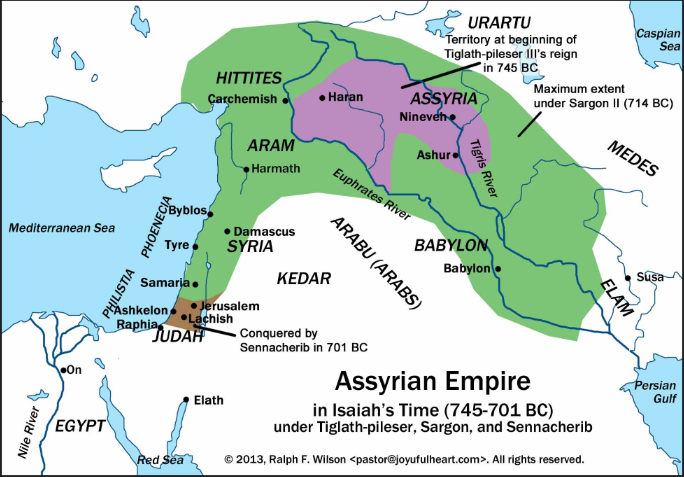

quote:?
Originally posted by the lioness,:
thanks, just trying to make everything clear
quote:That's because this is Assyrian art, not Egyptian. lol smh
Originally posted by the lioness,:
Notice the Assyrian at left's dotted portion of hair is depicted in the same way as the Israelites
I suspect if his hair was short it would all be like that.
Also his nose is somewhat similar to the middle figure and they all have beards, they look like kin, not resembling Egyptians

quote:.
Originally posted by the lioness,:
Notice the Assyrian at left's dotted portion of hair is depicted in the same way as the Israelites
I suspect if his hair was short it would all be like that.
Also his nose is somewhat similar to the middle figure and they all have beards, they look like kin, not resembling Egyptians
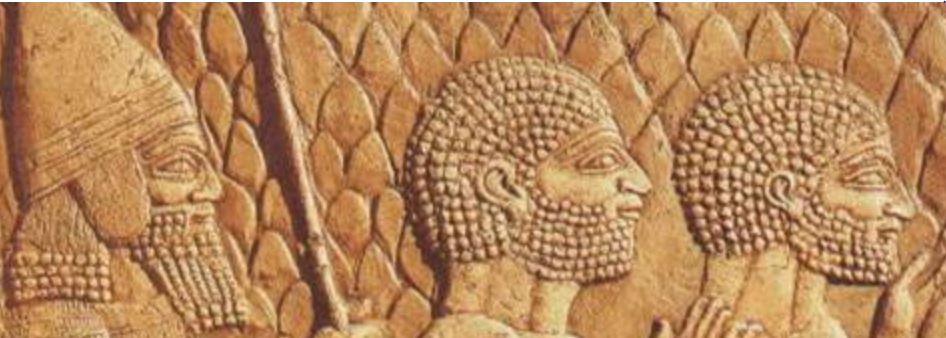


quote:Dis Deshret ain't it?
Originally posted by the lioness,:
seriously?



quote:mm hmm nice try at switching goal posts.
Originally posted by the lioness,:
[
Neo Assyrian
Nice try see the Assyrian boy has uniform hair. The adult has that wavy stuff above the curls on his hair. That is probably combed out with some oils [
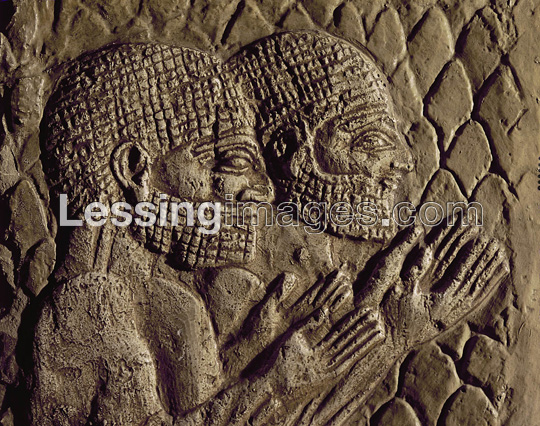
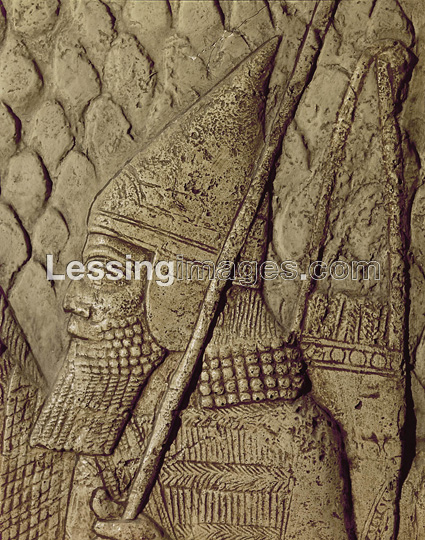


quote:Yoruba Men... yes.. Yoruba men.. they even wear the Jehu cap
Originally posted by the lioness,:
1) if "woolly" means afro textured hair that cannot be determined by the above art
2) no real person has hair that is straight and then curled on the bottom which means part of the hair depicted is not in it's natural condition.
The upper beard hair of the Assyrian shows the natural condition as well as the Assyrian boy.
If you think otherwise show a photo of a person that has wavy straight hair but is curled on the bottom in this drastically different way

In Egyptian art being bearded is most similar to other Asiatics not Nehesy.
What modern people most resemble these Lachishites? I'm not sure


quote:I think all the real analysis is done.
Originally posted by the lioness,:
show a photo of a person that has wavy straight hair but is curled on the bottom in this drastically different way




quote:
Originally posted by Yatunde Lisa:
Yoruba Men... yes.. Yoruba men.. they even wear the Jehu cap
quote:[/QB][/QUOTE]
Originally posted by -Just Call Me Jari-:
I doubt the Yoruba are Canaanite, we still have dark skinned Bedouin and Yemeni etc. makes more sense Lachish reliefs were depicting a Mehri or Socotran type among Israel

quote:Tukular can't be serious. He is trying to say that the Assyrian soldier, top left's hair can be explained by this Europeans woman's fake curls
Originally posted by Tukuler:
[QB] You must be joking.
Trying to use my own challenge against me?
Ain't nobody that slick, nice try.





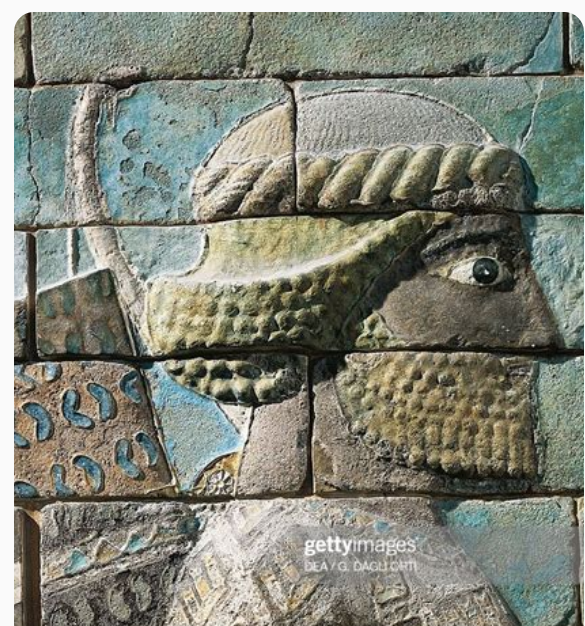
quote:
Originally posted by -Just Call Me Jari-:
I mean it would be one thing if they're were'nt native Bedouins who looked like this...


quote:From my understanding Persia didn't exist yet, but I could be wrong.
Originally posted by the lioness,:
As we can see the hair is naturally curly in this Persian art. The straight portion at the top is merely being pulled straight by the headband
quote:In hair texture they portrayed them the same fro north by the Egyptians. And ironically the Assyrians had the same in their art.
Originally posted by the lioness,:
1) if "woolly" means afro textured hair that cannot be determined by the above art
2) no real person has hair that is straight and then curled on the bottom which means part of the hair depicted is not in it's natural condition.
The upper beard hair of the Assyrian shows the natural condition as well as the Assyrian boy.
If you think otherwise show a photo of a person that has wavy straight hair but is curled on the bottom in this drastically different way
https://images2.imgbox.com/44/0e/3Z69Jje1_o.png
https://www.lessingimages.com/p3/080203/08020367.jpg]
In Egyptian art being bearded is most similar to other Asiatics not Nehesy.
What modern people most resemble these Lachishites? I'm not sure
quote:Wait no longer.
Originally posted by Nassbean:
I'm waiting for the black east asia thread too
quote:.
Originally posted by the lioness,:

Notice how the dotted portion of the Assyrians hair and beard has the same dots as the Israelite hair



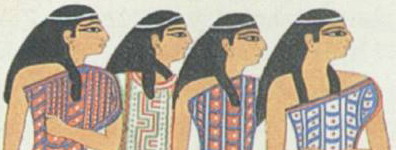
quote:https://www.biblicalarchaeology.org/daily/ancient-cultures/ancient-israel/the-only-ancient-jewish-hair-ever-found/
One of the more fascinating finds in this tomb, one that has not received much attention, was the preservation of a sample of Jewish male hair. The hair was lice-free, and was trimmed or cut evenly, probably indicating that the family buried in this tomb practiced good hygiene and grooming. The length of the hair was medium to short, averaging 3-4 inches. The color was reddish.
quote:https://www.biblicalarchaeology.org/daily/ancient-cultures/ancient-israel/the-only-ancient-jewish-hair-ever-found/
One of the more fascinating finds in this tomb, one that has not received much attention, was the preservation of a sample of Jewish male hair. The hair was lice-free, and was trimmed or cut evenly, probably indicating that the family buried in this tomb practiced good hygiene and grooming. The length of the hair was medium to short, averaging 3-4 inches. The color was reddish.

quote:
This painting depicts a family of nomadic traders entering Egypt from Canaan in the 19th cent. BCE. This is a very rare depiction of ancient Semites, dressed in colorful tunics, as opposed to the Egyptians wearing only white waistcloths.

quote:
This painting depicts a family of nomadic traders entering Egypt from Canaan in the 19th cent. BCE. This is a very rare depiction of ancient Semites, dressed in colorful tunics, as opposed to the Egyptians wearing only white waistcloths.
quote:Might want to post the original mural straight from the tomb instead of a modern reproduction.
Originally posted by Archeopteryx:
Some more Egyptian art depicting people from Middle East

quote:
This painting depicts a family of nomadic traders entering Egypt from Canaan in the 19th cent. BCE. This is a very rare depiction of ancient Semites, dressed in colorful tunics, as opposed to the Egyptians wearing only white waistcloths.

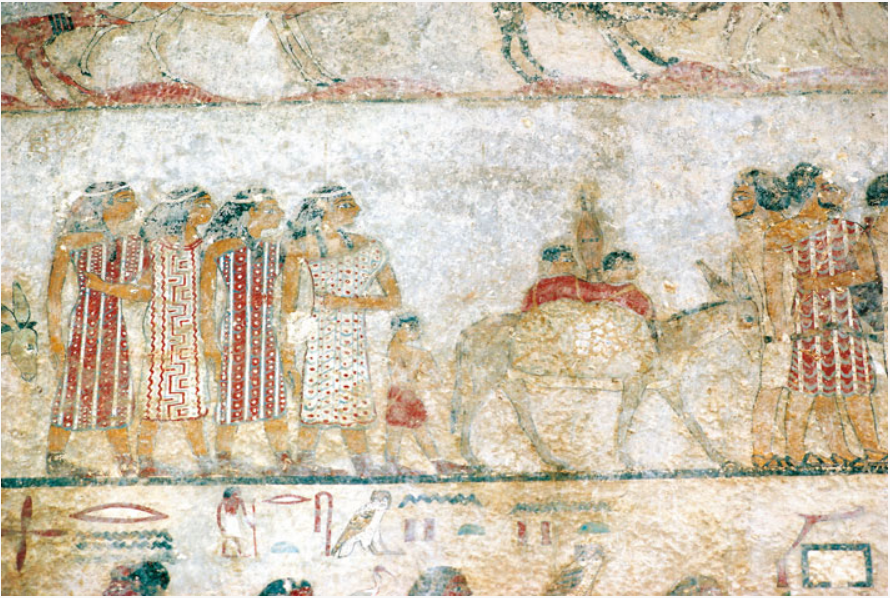
quote:some of the image hosting sites have size change options before you finalize the picture upload, that is the easy way, you start an account with one of the free image hosting sites
Originally posted by Archeopteryx:
How do I reduce size of a pic?
quote:Interesting,
Originally posted by Archeopteryx:
Sometimes it is best to get things directly out of the horses mouth. Here is a a small piece found in Israel, and about 2800 years old.
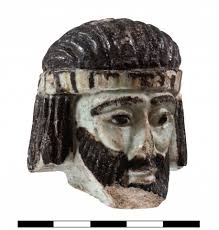
Could This Sculpted Head Depict a Little-Known Biblical King
quote:Smithsonianmag
“We’re guessing probably a king, but we have no way of proving that,” Mullins tells LiveScience’s Owen Jarus
quote:APNews
This Monday, June 4, 2018 photo shows a detailed figurine of a king's head on display at the Israel Museum, dating to biblical times, and found last year near Israel's northern border with Lebanon, in Jerusalem. A palm-sized enigmatic sculpture of a king's head dating back nearly 3,000 years has set off a modern-day mystery caper as scholars try to figure out whose face it depicts. The 5-centimeter (2-inch) head is an exceedingly rare example of figurative art from the Holy Land during the 9th century BC, a period associated with biblical kings. (AP Photo/Ilan Ben Zion)
The 5-centimeter (2-inch) sculpture is an exceedingly rare example of figurative art from the Holy Land during the 9th century B.C. — a period associated with biblical kings. Exquisitely preserved but for a bit of missing beard, nothing quite like it has been found before.
While scholars are certain the stern bearded figure wearing a golden crown represents royalty, they are less sure which king it symbolizes, or which kingdom he may have ruled.
quote:Biography
In 922 B.C., the nation of Israel was torn into two nations, Israel to the north and Judah to the south. Israel was racked by internal tribal differences and, subsequently, became susceptible to frequent invasions.
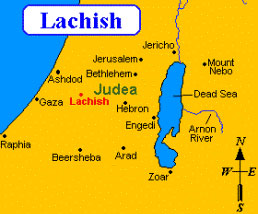

quote:Ok, you do have somewhat of a point. However, this was made thousands of years prior, 2589–2566 BC.
Originally posted by the lioness,:
Khufu (?)
quote:
Originally posted by Ish Geber:
At least we know it's Khufu

quote:
The statuette is identified as Khufu,king of the IVth dynasty ,by the ka name of the king,inscribed on the right side of the throne(PI.I).Petrie immediately dated this statuette to the IVth dynasty on the basis of the name inscribed on the throne,convincing all subsequent archaeologists and art historians of the validity of his assertion and dismissing as superfluous any thought of comparison with IVth dynasty sculpture.I disagree with this dating and believe instead that the statuette was manufactured in the XXVIth dynasty (26th),also known as the Neo-Memphite period.Let us now examine the archaeological evidence pertaining to the discovery of this statuette as well as the artistic and historical evidence connected with the IVth and XXVIth dynasties.
quote:You be like OJ, I be like 1985 … Ok?
Originally posted by the lioness,:
...
p5-
THE KHUFU STATUETTE IS IT AN OLD KINGDOM SCULPTURE?
Zahi HAWASS
http://www.gizapyramids.org/pdf_library/hawass_fs_mokhtar.pdf
The statuette is identified as Khufu,king of the IVth dynasty ,by the ka name of the king,inscribed on the right side of the throne(PI.I).Petrie immediately dated this statuette to the IVth dynasty on the basis of the name inscribed on the throne,convincing all subsequent archaeologists and art historians of the validity of his assertion and dismissing as superfluous any thought of comparison with IVth dynasty sculpture.I disagree with this dating and believe instead that the statuette was manufactured in the XXVIth dynasty (26th),also known as the Neo-Memphite period.Let us now examine the archaeological evidence pertaining to the discovery of this statuette as well as the artistic and historical evidence connected with the IVth and XXVIth dynasties.

quote:The folks who found this thing, have an inferiority/ superiority complex. They saw some thing "looking white", so it had to be a royalty. Let's make him a king. It's complete baseless babble, but a very classical school of thought way of "thinking". (no pun intended)
Originally posted by Archeopteryx:
Sometimes it is best to get things directly out of the horses mouth. Here is a a small piece found in Israel, and about 2800 years old.

Could This Sculpted Head Depict a Little-Known Biblical King
quote:Smithsonian mag
Ben Zion writes that Abel is significant for its location at the junction of ancient powers. Another Biblical reference to the city, found in Kings 1 15:20, includes Abel in a list of places attacked by Aramean King Ben Hadad during his invasion of Israel's territory.
[…]
Based on carbon dating’s inability to pinpoint the statue’s date beyond some point during the 9th century B.C., as well as the geopolitical conflicts that characterized the region at the time, archaeologists have a wide range of candidates for the figure’s identity.
quote:Times of Israel
King Hazael? A detailed figurine of a king's head on display at the Israel Museum, dating to biblical times, and found near Israel's northern border with Lebanon, in Jerusalem.
“The guy kind of represents the generic way Semitic people are described,” she said.
Because Carbon-14 dating cannot give a more exact date for the statue’s creation other than sometime in the 9th century, the field of potential candidates is large. Yahalom-Mack posited it could be kings Ben Hadad or Hazael of Damascus, Ahab or Jehu of Israel, or Ithobaal of Tyre, all characters appearing in the biblical narrative.
quote:The Vintage News
In one biblical story, a traitor to King David seeks refuge in the town. King David’s army besieges it and demands the traitor be given up. In response, the people of Abel Beth Maacah cut off the traitor’s head and toss it over the walls. Getting what they wanted, the Israelites end the siege.
[…]
The sculpture itself is only two inches in size. It’s well preserved and mostly intact. The figure has a beard and is wearing a crown. It’s considered a rare example of figurative art during that time period. Figurative art is defined as representational art derived from real objects or people. The hairstyle of the figure with a beard gives some clues to his ethnic identity.
The hair is pulled back in thick locks that cover the ears and is held in place by a striped headband. The art form is similar to how ancient Egyptian artists portrayed Semitic peoples of the Near East.
It’s still not known who the head depicted is and from what nationality they were from, though it’s likely a royal figure. The man portrayed was certainly an important person in his community.
But they have no clue what king it may have been or from which kingdom. The time period of the sculpture is from the period of biblical kings. After the death of David’s son, King Solomon, the Kingdom of Israel split into two entities with separate kingships, Israel in the north and Judah in the south.
Scholars have guessed at some contemporary names the sculpture could represent. They include biblical figures such as King Ben Hadad or Hazael of Damascus, Ethbaal of Tyre, and King Ahab or Jehu of Israel, whose capital was Samaria.
Knowing what king it might be would answer some questions. However, there are no known references or sources to check outside of the Bible narrative.
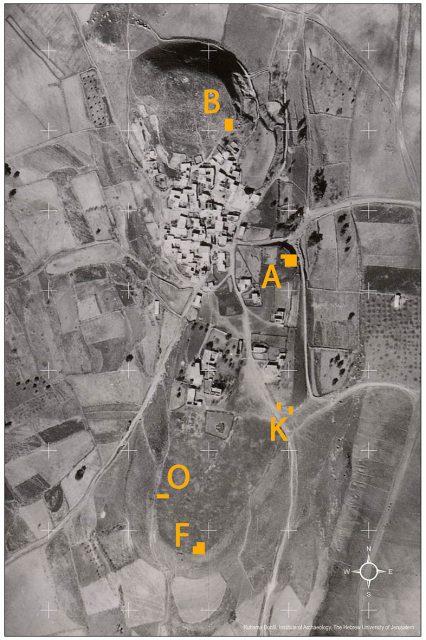

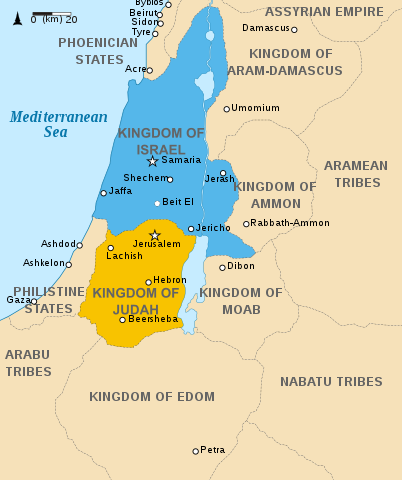
quote:Why is it you keep reposting the same thing?
Originally posted by Archeopteryx:
Interesting about ancient male Jewish hair
quote:https://www.biblicalarchaeology.org/daily/ancient-cultures/ancient-israel/the-only-ancient-jewish-hair-ever-found/
One of the more fascinating finds in this tomb, one that has not received much attention, was the preservation of a sample of Jewish male hair. The hair was lice-free, and was trimmed or cut evenly, probably indicating that the family buried in this tomb practiced good hygiene and grooming. The length of the hair was medium to short, averaging 3-4 inches. The color was reddish.

quote:Problem solved, it's a liberty hat.
Originally posted by Trollkillah # Ish Gebor:
Parthian Phrygian cap helmet, 249-224 B.C. Boston Museum of Fine Arts
Jehu-Obelisk.
quote:.
Originally posted by Ish Geber:
[QB] [QUOTE]Originally posted by Trollkillah # Ish Gebor:
[qb]
Parthian Phrygian cap helmet, 249-224 B.C. Boston Museum of Fine Arts

quote:
Originally posted by Ish Geber:
quote:Why is it you keep reposting the same thing?
Originally posted by Archeopteryx:
Interesting about ancient male Jewish hair
quote:https://www.biblicalarchaeology.org/daily/ancient-cultures/ancient-israel/the-only-ancient-jewish-hair-ever-found/
One of the more fascinating finds in this tomb, one that has not received much attention, was the preservation of a sample of Jewish male hair. The hair was lice-free, and was trimmed or cut evenly, probably indicating that the family buried in this tomb practiced good hygiene and grooming. The length of the hair was medium to short, averaging 3-4 inches. The color was reddish.
Anyway, Afro textured hair is usually lice-free due to the texture lice have a hard time surviving in it. The tighter the curls the more difficult it will be for the lice to survive in. And reddish hair "can" be a sign of malnutrition.

quote:I am not sure if, and how these two directly correlate.
Originally posted by -Just Call Me Jari-:
I doubt the color was due to malnurishment considering the indication of good hygene..
![[Roll Eyes]](rolleyes.gif)
quote:
Originally posted by Ish Geber:
quote:I am not sure if, and how these two directly correlate.
Originally posted by -Just Call Me Jari-:
I doubt the color was due to malnurishment considering the indication of good hygene..
quote:Hmm, I see what you mean.
Originally posted by -Just Call Me Jari-:
Because if you are malnurished, so poor you cant afford to eat but you have time to practice food hygene...![[Roll Eyes]](rolleyes.gif)
Anyway the tomb belonged to an elite Family, so this further makes the malnurished nature of the hair color seem even more silly and ridiculous.
quote:
Originally posted by Ish Geber:
quote:I am not sure if, and how these two directly correlate.
Originally posted by -Just Call Me Jari-:
I doubt the color was due to malnurishment considering the indication of good hygene..
quote:As if all ancient art was hyper realistic, as if there were not any artistic conventions or symbolic meanings of different stylistic traits. Those ancient pictures are not photos.
Originally posted by Snakepit1:
3813bc27c2b6de8642c2d4d[/IMG]
I don't know the amount of mental gymnastics you had to pull off in order to write what you just did, but as the artwork(s) show, the curl pattern is much tighter, i.e it's African textured hair. Even Stevie Wonder can see that. Try again. [/QB]
![[Smile]](smile.gif)
quote:That may not be true,mutations in the hair and eyes,assuming it wasn't some kind of natural dye doesn't mean the folks had to necessarily look like the contemporary inhabitant. There is no reason the ancient couldn't have some kind of tyrosinase positive form of albinism.
Originally posted by Archeopteryx:
Reddish hair 2000 years ago, lightly colored statue heads 2800 years ago, and some blue eyes 6500 years ago. At least it seems that everyone was not always "black" in what is now Israel, during the millennia.
The research of the demography of the ancient Levant continues. Shall be interesting to see what we find in the future.

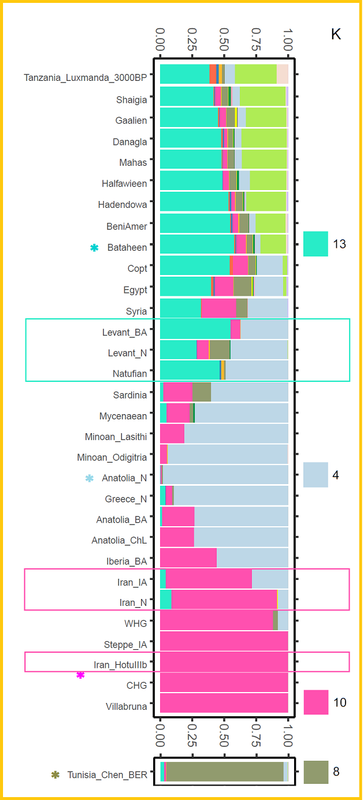
quote:
Originally posted 23 May, 2014 by Tukuler:
There is no other word for the inhabitants and
emmigrating peoples from the Caucasus Mountains
other than the word Caucasian because that is
precisely what they are, CAUCASIANS.
Caucasians passed down through the Daryal Gorge
to enter Mesopotamia and the Levant to influx
resident populations and to form new ethnies
of their own.
- The eastern Mediterranean is a nexus of three
continents. It and the Arabian Peninsula were
peopled by other migrant invaders who didn't
originally speak in Afrisian. Semitic speakers
were among the first but weren't the only
inhabitants of the region. Chadic and/or
Nilo-Saharan speakers likely preceded them.
Indo-Europeans, Caucasics, Altaics, etc., came
after them probably via Daryal Gorge through the
Caucasus.
From this can be gathered, if anything, that
"Semites" are partially North East Africans
who migrated into the Arabian peninsula and
moved northward (as far as up to Turkey)
where they met and mingled with and were maybe
blocked from further spread by southward invading
Eurasian peoples (Altaic and Indo-European speakers)
in pre-historic times. Upon the eclipse of the
southerners the hybrids and assimilated settlers
(beginning circa -1800 with the maryannu caste)
became heir to the names and languages of the
original people they married into and whose
culture they emulated and lexicon enriched.
from the What about Semitic? thread
- People look at the familiar faces from the region
as shown by the media and never see all the faces
on the back streets and non-urban areas which
more than likely resemble the original indigenees
even before E3b bearers introduced Afrisan and
the beginnings of neolithic industries.
It was the good life Afrisan speakers initiated
and the indigenees nurtured that made the place
a magnet for immigrants to cross the Daryal Gorge
to infuse themselves in SWANEA. And Indo-European
speakers continued to migrate in whatever numbers
especially in Roman Byzantine and Crusader eras.
Not to count the sexual slave trade (particularly
in Circassian females) with the rise of Islam.
from the Near East thread
I'd revise bits of that, if freshly posting it today,
but the bulk and certainly the gist of it is factual.
quote:.
Originally posted by Archeopteryx:
quote:As if all ancient art was hyper realistic, as if there were not any artistic conventions or symbolic meanings of different stylistic traits. Those ancient pictures are not photos.
Originally posted by Snakepit1:
3813bc27c2b6de8642c2d4d[/IMG]
I don't know the amount of mental gymnastics you had to pull off in order to write what you just did, but as the artwork(s) show, the curl pattern is much tighter, i.e it's African textured hair. Even Stevie Wonder can see that. Try again.
Seems as soon as you see some curly locks you immediately think "black". Must be boring to live in such limited world. [/QB]
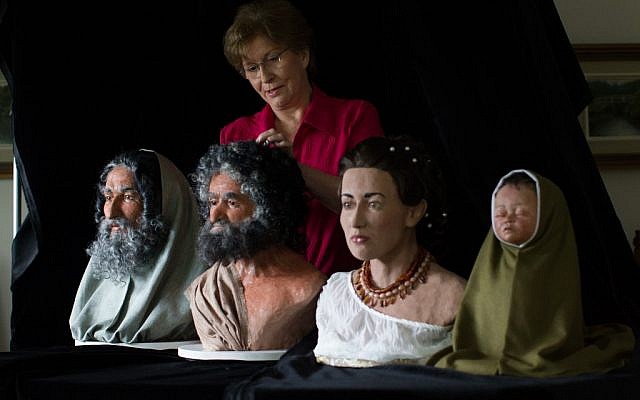
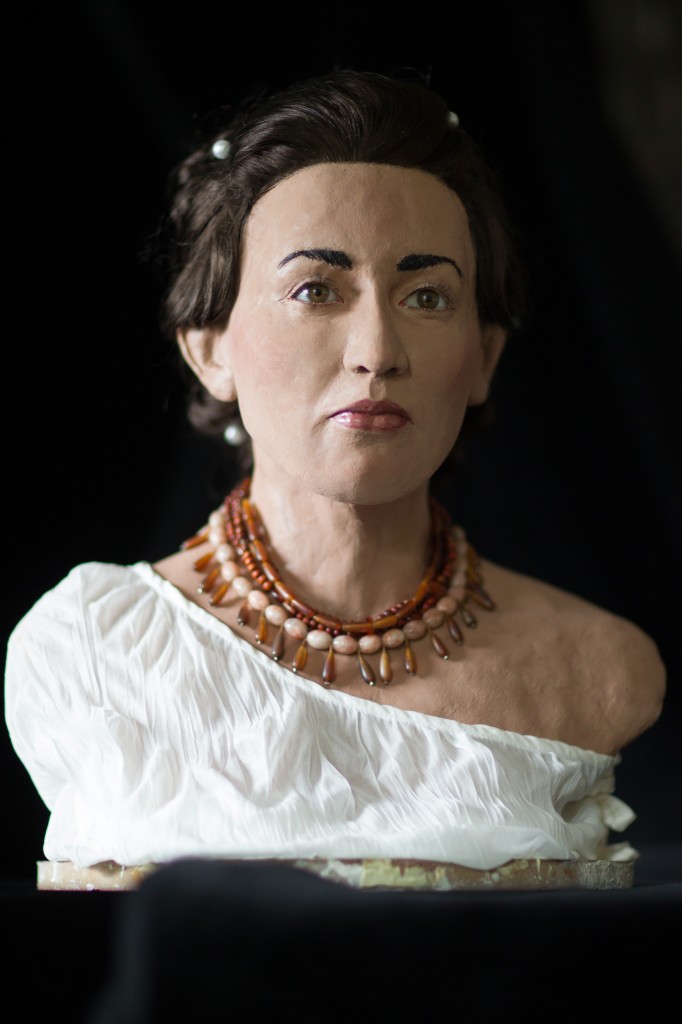
quote:.
Originally posted by the lioness,:
Figure 1.--This Assyrian carving at Lachish shows Hebrews being led into exile by Sargon's son Sennacherib after Hezekiah's failed revolot (701 BC).

Assyrirans with Hebrew captives

quote:Authenticity trumps nationalism and ethnocentricism.
Originally posted by Ish Geber:

